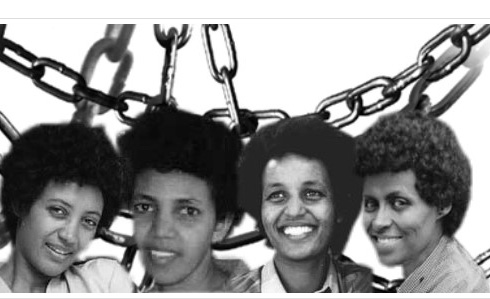
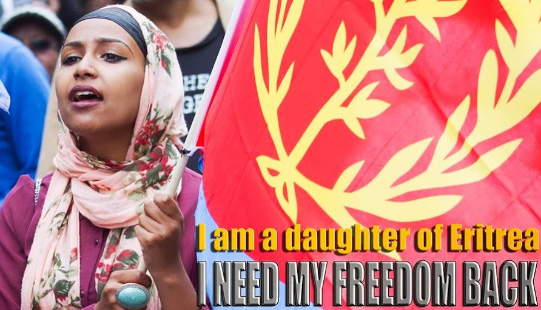
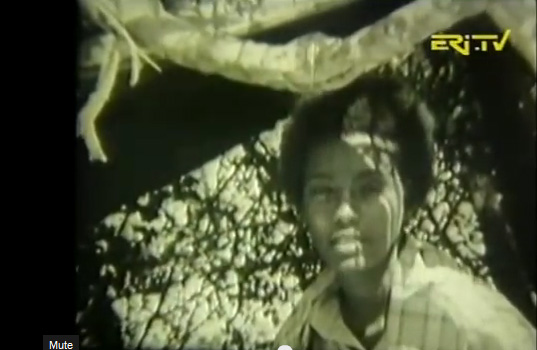



Researched and compiled by Resoum Kidane 29/08/2015
“Always bear in mind that the people are not fighting for ideas, for the things in any one ‘head. They are fighting to win material benefits, to live better and in peace, to see their lives go forward, to guarantee the future of their children” Amilcar Cabral
On the occasion of the commemoration of the 54th anniversary of the beginning of the armed struggle for national liberation and the 24th anniversary of Eritrea’s liberation from Ethiopian occupation, this compilation provides an overview of the Eritrean women who greatly contributed to the victory of the Eritrea revolution through supporting it financially, providing information and by joining the Fronts or by being clandestine members of the ELF and EPLF.
The women who joined the struggle came from diverse backgrounds and thus brought with them a very different understandings about what emancipation might mean. But once they had joined, they were exposed to and their thinking was formed by the ideological stance of the Fronts [Muller (2005 : p.47)
By the end of the liberation struggle the number of women fighters in the EPLF was estimated to be between one third and quarter of the freedom fighters. They had joined the Front not only to fight in the battlefield liberate Eritrea from the Ethiopian occupation but also to participate in the social transformation, to eliminate all social inequalities including gender inequality.
Gebremedhin,(2001, 58) has provided a brief account of gender inequality in traditional Eritrea society: women were generally treated as minors before and after marriage, additionally female children, from an early age, faced pervasive unequal treatment, and it’s tragic consequences were reflected in the lives of wives and mothers in late ages.
During the armed struggle the EPLF principle of emancipating women was grounded in Marxist ideas rather than feminist ones . The Marxist view on women’s struggle is based on class struggle which is different from the feminist focus on sexist oppression. To mark the struggle for women emancipation and mobilize women to participate in the struggle, the EPLF celebrated annual March 8th, International Women’s Day.
March 8th became officially an international day when Clara Zetkin at the Second International Socialist Women's Conference in 1910, in Copenhagen, Denmark, proposed a resolution to officially create an international women's day. Clara mentioned the idea, following the example of the American socialist women . From this day the commemorations of an international character have taken place, expanding throughout Europe, and to third world countries
The women’s struggle during the Russian, Chinese, and Cuban revolution wasn't restricted on Women's suffrage but beyond this.... Indeed the October Revolution gave women rights that they had never had and laid the basis for the emancipation of women. This became a model for the China revolution. In the Chinese revolution it is reported that approximately 50% of the rural women actively took part in the land reform movement. As a result of Chinese women’s active participation in the struggle, after victory they gained their newly obtained rights. (https://www.marxists.org/history/etol/newspape/fi/vol12/no04/conway.html) China’s example encouraged many women in the Third World, in the 1960s, 1970s and 1980s, to participate in their national liberation movements to fight for their freedom and equality.
Before 1960 the participation of women in earlier national liberation movements was uncommon. Evidence for this can be seen from the South African anti-Apartheid struggle. During the anti-apartheid struggle, South African women to actively mobilise took 30 years. The ANC Women’s League (ANCWL) had been formed in 1948. But the men of the organisation still saw women as inferior using women mainly for catering and mobilisation. [http://www.anc.org.za/wl/show.php?id=9807].
From the 1960 onwards the participation of women in liberation struggles became common. Muller [pages 19-210) mentions three liberation movements. The liberation movement in Mozambique, FRELIMO started an armed struggle in 1964 and from 1969 onward, the emancipation of women received great emphasis. In the Nicaraguan revolution women made up approximately 30% of the Frenete Sandinista de Liberacion National combat forces. In the Zimbabwean liberation war between one third and one quarter of the fighters were estimated to have been women
In the early years of the Eritrea revolution a relatively small number of women participated in the Eritrea Liberation Front. Wilson states that the ELF first refused to accept women's participation and after they were finally allowed to join the attitudes they faced made it impossible for them to participate as equals [Willison 1991 40).
During these early years, the ELF used women mainly for mobilisation. Zara who joined the ELF as early as 1964 recalls in her interview with Tanja R. Muller, most of her work was to organise people to participate in the revolution, and also how to organise the women outside. .[p78Muller Tanja 2005]
Zara also mentions that at first it was very difficult, but after doing their best, working hard to let the women in the field participate in the work, a lot of women worked inside the military. From late 1974 many women fighters joined the EPLF and ELF from both rural and urban areas as a result of mobilization in the face of intimidation and atrocities the Ethiopian army.
Additionally the EPLF strongly believed in women equality with the intention that gender inequality would not affect their children. Green, (1994) in her report to Dalida on gender equality and law also mentions that the National Democratic Programme, updated in March 1987, in theory provided the platform from which to challenge the various manifestations of gender inequality. The NDP aimed to: assure women full rights of equality with men in politics, the economy and social life (NDP, 1987 cited in Wilson, 1991:172)
Muller (2005:79) states that contrary to the picture painted by the EPLF, there were avenues open for women to become successful in their own right apart from joining the struggle and subscribing to its ideology of gender equality even though there was little room for women to assume public roles in political life [cited Wubesh Selassie, 1992; Wilson, 1991]
Bernal in her paper, From Warriors to Wives: Contradictions of Liberation and Development in Eritrea, argues that women’s participation in the nationalist struggle and the achievement of independence for Eritrea did not necessarily liberate them. There is confirmation for this in the case of an ex-fighter Senate Debessai.
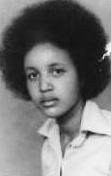 |
Senait joined the EPLF from Khartoum at a young age while she prepared to go to USA. Rather than move to the USA for better life., in 1976, Senait inspired by the EPLF’s gender equality, joined the Front. Senait spent her youth in the struggle to liberate Eritrea from the Ethiopia occupation to emancipate Eritrean women from male oppression. However, many Eritrean women like Senait became victim of patriarchal oppression. and injustice. Senait was abused and mistreated by her husband and eventually her husband levied criminal charges against Senait and her brother Ermias. .On 6th of December 2003, both were suddenly snatched from their bed. They have been incarcerated ever then. |  |
This brief background information might be useful for those who wish to conduct further research on:
1. Role of Eritrean women during the liberation struggle
2. What happened to Eritrean women in general and women fighters in particularly in the post-liberation period?
3. Eritrean women who became victims of conflicts during the 30 years Ethiopia occupation:
1.Short personal history of some women fighters and their role in the struggle
1.1.Brief information on the role of Eritrean women in the fifties strikes, demonstrations and in the Clandestine Group of Seven
1.2 .ELF female fighters
1.3.Background information on the first EPLF educated female fighters.
1.4.Personal history on women fighters who joined the EPLF after 1974
1.5 Brief information on Eritrean women in Ethiopian prisons after 1974
2. Eritrean women in Post-liberation
2.1 An overview 3. What is happening to their daughters in Post-Liberation
3.1 Background information
3.2 Life in Sawa
3.3 Legacy of Gedli
3.4 Bried information on Eritrea’s 15 favorite methods of torture and and Testmonies
3.5 Forced migration(Exodus)
3.6 Eritreans young women/girls currently situated in Ethiopia refugee camps)
3.7 Kidnappings and Missing young women/girls after fleeing the country
3.8.Testimonies of Eritrean women currently situated in Sudan, Uganda, and Kenya
4. Sexual abuse of Eritrean women and commercial sex workers (CSW) in pre- and post-liberation in Eritrea
Unfortunately during the armed struggle the ELF or EPLF was unwillingness to include the role of women in the fifites in their history of Eritrea. Sadly, members of the Eritrea Women Association who affiliated with the PFDJ and the opposition groups only honour the women who contributed to the Eritrea struggle after the 1960s. not in the 1950s.
The contribution of Eritrean women in the struggle for justice, democracy and independence has history goes back to the 1958 General Strike that lasted four days General Strike. General Tedla Ogbit Police Commissioner ordered the workers and their supporters to disperse but instead a group of women, symbolically blindfolded and carrying candles, surged up the cathedral stairs loudly praying to Saint Mary for aid, and were pushed back by the police. In the 1950s a considerable number of women students were involved in these strikes and demonstrations, but unlike their male comrades they were in general not arrested .
Worku one of the first women in the EPLF explained the role of women in the fifties:
In the 1950s there were Eritrean police and guards and they did not mistreat women in the same way as the Ethiopians were to do later. Actually the policemen were in a dilemma because when the Eritrean students sang patriotic songs, the policemen identified with them. But they attacked demonstrators with tear gas. They didn't want to arrest women and they would say to them. "You go home, you are women". But the women refused to leave their male comrades Asmara, women had participated all through, side by side with men, in strike, but in the fifties soldiers were not arresting women. The women would refuse to part from their male comrades and sometimes when they were arrested and their parents came to see them, the police would ask them to go and they would refuse to leave. Wilson p 25
In the early 1960s the activities of the Group were reaching a peack Gedey Fassah "Gandhi" was one of them. She too remembers the mid-1950s as a point when the struggle started. Married at the age of 13 in 1955, she and her husband became involved in the Group of Seven in 1961. We used to agitate, carry out operations and after 1963 when we established a connection with the field, we used to collect money for the struggle. In March 1966 on Ethiopian New Year we carried out an operation in Asmera near the fuel-station. My husband was involved in this. The Ethiopians found out about it. At that point we had in our house two machine guns and about one thousand bullets, we had kept them there for about eight months and I was the one responsible for them. I remenber the speed with wich we acted we got hold of a car, took them to the house of the inflitrator and put them under his bed. He was out and his mother was blind so she could not see. Three hours later the police raided our house. One of the comrades responsible for the operation escaped to the front, and six others were arrested. To start with they were all given death sentences but later these were changed to sentences of 13, 7, and 4 years. My husband and two other were fined and placed under house arrest. That was my husband's third arrest; the first time he had been tortured. After 1966-7 the Group of Seven was finished. At that time there were very few Eritrean women fighters. Wilson p31
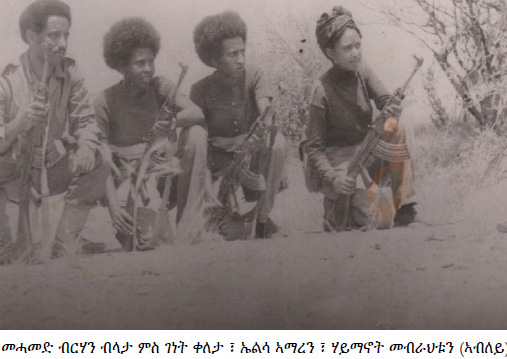
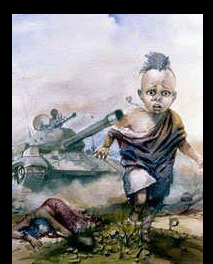
|
Ethiopians should blame their rulers not the Eritrea revolution, when Eritrea was occupied by Ethiopia in 1962, its rulers attitude toward the Eritrean people was :“We need the land not the people” One of the factor which contributed for the barbaric crimes committed by the Ethiopian army forces in the 1960s was the rivalry among the Zone commads which caused for , the civilian population to be the victims of the Ethiopian arm. The fierce power struggle within Supreme Council also exacerbated the mutual suspicion and hatred among the fighters. Shermam,(1980:75) states that the leaders of the regional-based military structure (zones), were not only far from helping each other to resist the offensive which was launched by the Ethiopia army in 1967 but also were rejoicing at each other’s defeat. Haile Drue in the interview with Dan Connel said that whenever there were military operations against the government, nobody from one division wanted to help the other division. Even to the extent that every division would not allow fighters from other division to go around their area (Conell, 2004:31). The Ethiopian army through exploiting the ethnic rivalries between Eritrean launched a concerted offensive by attacking one zone at a time Patment( 1990:118). As a result of this offensive the unarmed civilian population became victims of the Ethiopian atrocities:
[ንሕና ሓደ በትሪ ዝግመታ ኣሓ (100) ማለተን'ዩ ከምኡ ውን ብርክት ዝበላ ጠለበጊዕንውን ኔረናና እንተኾነ ንሳዕሪ ብላዕ ንጋሽ ምስ ወፈራ ኣይተመልሳናን፡ ጸላኢ ንበዓል ቤተይ ምስ ቦኽሪ ወድና ቀቲሉ ኩለን ጥሪትና ዘሚቱወን ሕማቕ ኣይትርከቡ ንክትሰምዖ ከቢድ መርድእ መጺኡ።] with the EPLF[http://www.bridge.ids.ac.uk/sites/bridge.ids.ac.uk/files/reports/re22c.pdf
|
After the annexation of Eritrea in 1962 and the formation of ELF in September 1961, the Haile Selassie regime with its scorch earth policy and mass killings in the Easter and Western Eritrean lowlands burnt villages including the schools and some schools were used as military camps. Tens of thousands of Eritrean people including students and teachers were uprooted from their villages and towns and forced to flee and seek refuge in the Sudan and other joined the struggle, Rahma Saleh was the first women who joined the ELF here is her brief biography written by Mohammed Belta ሓጺር ዛንታ ሂወት ራሕማ ሳልሕ ቀዳመይቲ ኣብ ሰውራ ዝተሰለፈት ጓል ኣንስተይቲ ብ ብመሓመድ ብርሃን ብላታ [readmore]
Rahma Saleh
A short biographical sketch of Rahma Saleh Eritrea’s first female fighter [source http://emnetu.com]
[readmore]
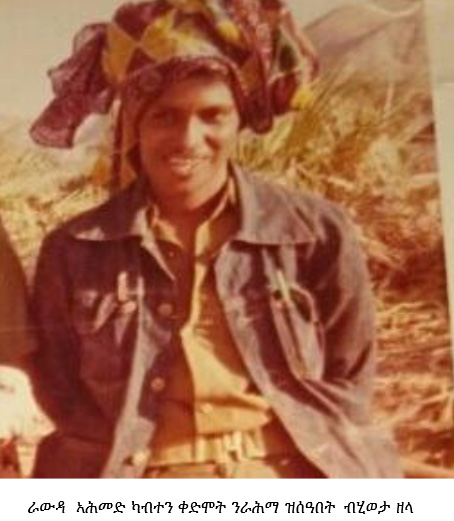
Jum’a Omar

Jum'a Omer, first woman to join the Eritrean armed struggle in Akele Guzai in October 1967. (together with Rahma Saleh)
“I joined the Third Zonal Command of the ELF on 18 October 1967. With me was Rahma Saleh who in 1971 went to the PLF. We attended the literacy courses in the field and were later sent to Kassala in April 1968 where we worked in an ELF clinic. In October 1969, we were sent to Iraq for training in public health and returned in August 1970. We were 18 girls and 17 boys; all of us continued to work [for the ELF] in Kassala.”
Jum'a Omar ... "The forgotten icon in the Eritrean struggle for independence. The first Eritrean female who joined the armed struggle 1966" ~ Ramadan Abdalla
"By the closing years of the 60s, as the Eritrean armed struggle advanced, the Eritrean women transformed their role to carry arms side by side with their brothers. One can proudly mention here Juma Omar and the late Rahma Salih as the first two women who joined the armed struggle. Many others have followed in their footsteps." ~ Aysha Idris, March 05, 2004. Women's or any social rights Cannot be achieved When the whole society suffers under despotism.
"Not forgotten:" ~ Mohamed Kheir Omer http://hedgait.blogspot.com/2015/03/ehrea.html
"Indeed, Jumaa Omar and Rahma Saleh were the first women to join the armed struggle (ELF) -- on 18 October 1967, to be exact. In April 1968, they were assigned to the ELF clinic in Kassala, Sudan. (Rahma Saleh later, in 1971, joined the PLF). Read more about Jumaa and other women pioneers of the Eritrean revolution in Woldeyesus Ammar's book, here (pages 147-149):" ~ Ahmed Raji
http://daberinet.com/.../Woldeyesus%20Ammar,%201992...
Nistrit Karar
“The first ELF women’s cell in Kassala was formed in June 1963 whose key members included Jemie Bahdur, Sitel Hamid, Fatna Mahmudai, Khedija Nur, Aisha Osman and myself. We helped organize cells in Aroma, Halfa and Ghirba. Cells were expanded after the October 1964 revolution in the Sudan. Our cells in Kassala rose to 35. We also encouraged the establishment of cells in Tessenei, Agordat and Keren. Already in 1964, Fatna Jaafar was our contact in Haicota. We in the Sudan were contributing 25 piasters per month each. Besides, we sewed flags and prepared dry food. Bekhita Abdalla joined the ELF in 1970 and had been serving as a nurse ever since then. There were ten women participants in the first ELF National Congress of [October] 1971, eight of them nurses.”
Zahra Jabir
Zahra comes originally from Ali Ghider, near Tessenei, and as early as 1964 joined the ELF-she was by then working in the office of Yemenia Airlines in Asmara. Shortly after she joined she was forced to leave the country because the Ethiopian authorities suspected her of involvement with the ELF. She went first to Rome and then to Algeria, where she studied law and continued political activities on behalf of the ELF, as she recalls: During my study period of course I was struggling, I was in the student union, and I can say, I was the first one to start women's movement... so I was working in the student union and the women's movement'... after I finshed my study [in Algeria] I came back to the field (...)[fighting], but most of our work was how to organise people to participate in the revolution, and also how to organise the women outside, in Sudan, Egypt, Saudi-Arabia, in Italy, all these places where we find the Eritrean women, we were moving there and organising the women (...)[asked whether there were many women in the ELF at that time] many women, yes, we were ... we had an organisation, about 18, what you call it, executive members and also local, what you call it... anyhow, I was member of the executive (...) executive member foreign affairs (...) [asked about the relationship with male comrades in the ELF] of course it was a little difficult, you know, at the first time of course they couldn't accept you with help the women or the girls to participate in the military... and to help them how to have the right to fight everywhere, politically, socially and (...) for the first time it was very difficult, but after doing our best, working hard to let the women be in the field and participate in the work, really we had a lot of women, girls, working inside the military(...) after 1980, as you know, of course there was internal fighting ELF was out of the field, so I was continue the struggle outside. Zahara did return to Eritrea only after liberation and joined the EPLF.Muller, Tanja R 2005[pp.77-78]
“I became an ELF fighter in April 1973 together with Ghennet Gebre-Hiwet .Until that time, I had been a member of a five-person [urban ELF] cell; there were many student strikes then. In August 1973, Alem Mesfin joined the ELF in the Akkele-Guzai region. Swhe was martyred in 1974. [She was a victms of civil war, the ELF and EPLF leaders who should be blamed for the death of Alem Mesfin and other 3000 fighters who were killed in the civil war 1972-1974]
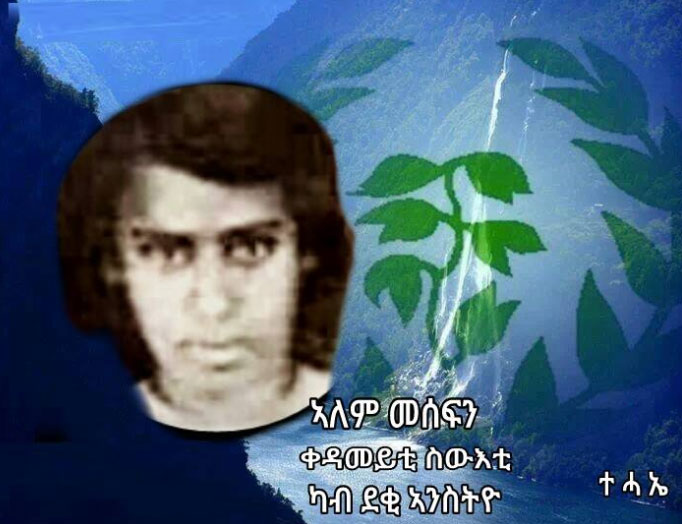
“Before 1973, therefore, there were no well studied plans to accommodate women in the ELF. We were given a short 20-day training as fedayeen and stayed in the Mensa’e area around Gheleb sewing and repairing clothes for fighters. We also helped in the preparation of food.
“Almaz was my nome de guerre. My first [real] name, now totally forgotten, was Nebiyat. By end of 1973, we conducted a public meeting in the Mensa’e area and wanted to continue doing so in other parts of the country. There were no sexual advances made on women in those days. However, women were not accepted as fighters before us. We met many girls in the countryside who told us that they were sent back with their hair shaven by ELF units when they asked to become fighters in the 1960s.
“Ghennet and I started talking to women about their rights and duties in the revolution; we addressed in gatherings like village holidays, and at funeral or matrimonial ceremonies. We were later given a two-month course at Debir Sala by Martyrs Hassan Bashumel and Idris Omar. In February 1974, we joined a 13-member women’s committee [that was] already formed in 1973. The Constituent Congress of the Eritrean Women’s General Union [affiliated to the ELF] was held on 27 June 1974 with 40 women participants.
“Talking about other women fighters, Almaz added the following:
“ Saadia Tesfu was one of the early and heroic women participants in the Eritrean nationalist cause. In early 1968, Saadia Tesfu agreed with two ELF fedayeen to help them liquidate Ali B ekhit (Wed Hayget), a deserter from the ELF who was helping the Ethiopian authorities to arrest many [ELF] cell members in the town [of Keren].
“Ali- Bekhit had terrorized Keren. Many of the town’s inhabitants had some connections with the ELF, and had reason to spend sleepless nights or leave the town to become refugees [in the Sudan]. It was then that Saadia was asked to help. She soon befriended herself with Ali-Bekhit and had him killed. She left the town with the ELF men but her father was shot dead by the Ethiopians [at the very spot where Ali-Bekhit was found killed]. Saadia spent five months in the field and later went to the Sudan.
“Another early woman participant was Rumana Saleh who helped in the [execution] of another deserter, Abu Nurit; the latter had terrorized the town of Agordat until he was killed by the ELF in January 1975.
“Mana Mussie was an important political cadre of Company 97 who successfully led the Battle of Metekel, and Martyr Haregu G/Egziabeher was a brilliant platoon leader. After 1975, the number of women fighters became very large.”
[ SOURECE Nharnet.com- The interview was held with Almaz Woldu, who at the time of the interview was one of the leaders of the Eritrean Women’s General Union; Jum’a Omar and Nisrit Karar. Nisrit tells about the first women’s cell in Kassal in 1963; Jum’a was in the field as early as October 1967, and Almaz joined the ELF army in 1973 at the head of the first massive wave of women fighters who joined the liberation struggle over 30 years ago. Almaz also tells us more about the historic exploits of other women fighters who worked with the ELF fedayeen (like Saadia Tesfu,1967, and Rumana Saleh,1975) and about the first woman martyr in the armed struggle, Alem Mesfin. (The material is reprinted with the permission of W. Ammar, who conducted the interview at Rasai near Kassala on 18-19 March 1982.) Good reading.]

Background information on the first EPLF female fighters.
After Kidane Kiflu was assasinated in Kassala by the ELF, members of GESU split at the meeting held in Nuremberg in August 1971, the Eritrean students in the North America became supporters of the PFL by condemning the ELF leaders for their role in killing democratic fighters; furthermore the Eritrean students inside Ethiopia formed a clandestine Eritrean Marxist Group and became supporters of the PLF, in 1972 and 1973 many members of this group joined the EPLF from the Haile Selassie I University, Addis Ababa University. Dehab Tesfatsion, Aberash Melke and Werku Zerai. were among those students who joined the EPLF from Haile Selassie University.
Those three intellectual females who joined from the Addis Ababa believe that they were strongly influenced by the black American civil rights activist Agela Davis and Marta Mebrahtu who was a medical student in the late 1960s at the Haile Selassie I University.
Martha was a daughter of a brigadier general who hailed from the province of Eritrea (Eritrea was then part of Ethiopia) Martha entered college when she was only 15 years old.and a few months away from graduating, the then government killed her.
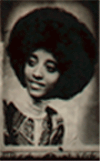
.She was a beautiful and intelligent medical student at Haile Sellasie I University (now Addis Abeba University) back in the 1970s (or 1960s in the Ethiopian calendar). (her peers affectionately called her the Angela Davis of Ethiopia) [By KM November 19, 2011
Martha wrote (roughly translated from Amharic):
We, women of Ethiopia and Eritrea, have made our life ready to participate in a struggle, and we would like to explain the nature of our struggle to our sisters and brothers all over the world.
Our struggle demands a bitter sacrifice in order to liberate our oppressed and exploited people from the yokes of feudalism and imperialism. In this struggle we have to be bold and merciless. Our enemies can only understand such a language.
We, women of Ethiopia and Eritrea, are not only exploited as members of the working classes and peasants, we are also victims of gender inequality, treated as second class citizens. Therefore, our participation in this struggle must double the efforts of other oppressed groups; we must fight harder, we must be at the forefront.
We must equally participate in the struggle for economic and social justice that our brothers have waged. We have a responsibility to become a formidable force in the revolutionary army.
The rights for freedom and equality are not manna from heaven. We, women, have to be organized and have to make ourselves ready for any armed struggle. This fight will need financial, material, and moral support of progressive international women’s associations. We reach out to our sisters in other parts of the world so you can help us achieve this goal; we hope your support will reach us as we need it.
We affirm our full support for the oppressed people of the world who are struggling to free themselves from imperialism, colonialism, neocolonialism, and racism! We stand by the freedom fighters in Vietnam, Palestine, Guinea-Bissau, and in other African and Latin American countries; we also champion the Civil Rights leaders in North America.[ By KM November 19, 2011
Martha who was the daughter of brigadier general Mebrhatu and medical student could have everything in life, but she chose to fight against oppression. Similary the first three EPLF female fighters they could have a bright and comfortable future after completing their studies but decided to participate in a struggle to fight against any oppression for sake of economic and social justice. This was the dream of Martha generation, Martha, Dahab and Aberash have never been honoured by any Eritrean (political) organisation!
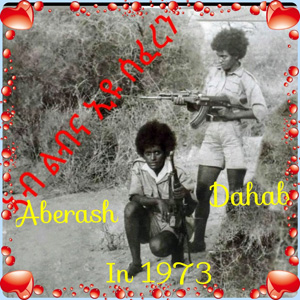
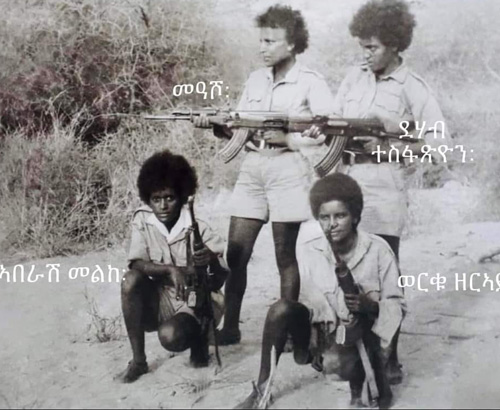
ስውእቲ ተጋዳሊት ደሃብ ተስፋጼንን ስውእቲ ተጋዳሊት ኣበራሽ ምልኩን ካብተን ቀዳሞት ኣብ ህዝባዊ ሓይልታት ኤርትራ ዝተሰለፋ ተጋደልቲ እየን ነይረን። እንተ ኾነ ግን በቲ ዝነበረን ዝኣመናሉን እተስለፋሉ ውድብ ዝነበረን ገስጋሲ ኣራኣእያ ዝጉዕጽጽ ብምንባሩ ኣብ ልዕለእን ዘይፍትሓዊ ናይ ሞት ስጉምቲ ብላዕለዋይ መሪሕነት ኣብ ልዕሊ ዘን ንጹሃት ደቅንስትዮ ተጋደልቲ ተወሲዱ። በቲ ዝተሰለፋሉ ውድብ ዝተቀንጸላን ዝተኻሒደን፤ ጀጋኑና ድሕሪ ባይተን ከም ዚ ዝስዕብ እዩ።
ስውእቲ ደሃብ ተስፋጼን ካብ ኣዲኣ ጽገውይኒን ኣቦኣ ተስፋጼን ኣባል ፓርላማ ኢትዮጵያ ዝነበሩን ኣብ 1975 ድማ ናብ ሰውራ ኤርትራ ህዝባዊ ሓይልታት ሓርነት ኤርትራ ኣሰር ጓሎም ካብ ዝተስለፉ ሓርበናኛ ኣቦ ዝተወልደት እያ ነይራ። ደሃብ ኣብ ከተማ ደቀምሓረ ኣውራጃ ኣኮለግዛይ ብናይ ሎሚ ኣጸዋውዓ ድማ ዞባ ደቡብ ተወሊዳ። ናይ መባእታን ማእከላይን ደረጃ ትምህርታ ኣብ ከተማ ደቀምሓረ፤ ካልኣይ ደረጃ ትምህርታ ድማ ኣብ ኢተገመነን ቤት ትምህርቲ ኣዲስ ኣበባ ወዲኣ። ድሕሪ ላዕለዋይ ደረጃ ኣብ 1ይ ሃይለ ስላሴ ዩኒቨርሲቲ ማሕበራዊ ዕዮ ተማሂራ። ጎኒ ጎኒ ትምህርታ ድማ ኣብ ልዕሊ ህዝባን ሃገራን ዝነበራ ልዑል ሃገራዊ ፍቅሪ ብምስጢር ተወዲባ ተቃሊሳ። ኣብዚ ከይትሓጽረት ነቲ ተፍቅሮ ህዝባናን ሃገርና ኤርትራን ክትብጆ ምስ ገለ ብጾታ ካብ ኣዲስ ኣበባ ብብረት ንክትቃለስ ናብ ሜዳ ተሰሊፋ።
ስውእቲ ደሃብ ተስፋጼን
ብ1971 ኣብ ዝነበረ ናይ ተማሃሮ ምንቅስቃስ ብምሲጥር ተውዲባ ክሳብ 1973 ተቃሊሳ። ኣብ ሚያዝያ 1973 ድማ ኣብ ብረታዊ ቃልሲ ተሰሊፋ 1974 ድማ ብምኽንያት ደምክራሳዊ ምንቅስቃስ (መንካዕ) ተባሂሉ ዝፍለጥ ኣብ ፋሕ ተኣሲራ. ኣብ መጀመርታ 1979 ድማ ተረሺና
ስውእቲ ኣበራሽ ምልከ
ካብ ኣቦኣ ወትሃደር ኢትዮጵያ ዝነበረ ኮይኑ ናይ ኮሎኔል ማዕርግ ዝለበሰ ኮሎኔል ምልከ እያ ተወሊዳ። ዝተወለደትሉ ቦታ ብርግጽ እንተ ዝይፈለጥኩዎ ግን ኣብ ጎንደር ወይ ኣብ ትግራይ ተወሊዳ ዝብል ግምታት እዩ ዘሎኒ። ዝዓበየትሉን ዝተማህረትሉን ድማ ኣብ ጎንደርን ትግራይን እዩ ነይሩ። ዝቀጸል ትምህርታ ኣብ ቀዳማዊ ሃይለስላሴ ዩኒቨርስቲ ኣዲስ ኣበባ ናይ ስነ-መሬት (Geologist) ተማሃሪት ነይራ። ጎኒ ጎኒ ትምህርታዊ ንጥፈታታ ምስቲ ዝነበራ ፖሎቲካዊ ንምንቅስቃስ ተማሃሮ ዩኒቨርሲቲ ኣዲስ ኣበባ ንኸትቃለስ ጽልዋ ሓደራ። ካብ ትምህርታዊ ዓለም ወጺኣ ምስ ከምኣ ዝኣመሰላ ቀዳሞት ኣርባዕተ ተማሃሮ ዩኒቨርሲቲ ዝነበራ ደሃብ ተስፋጼን ትርከበን ናብ ሓርነታዊ ቃልሲ ሰውራ ኤርትራ ኣብ ውድብ ህዝባዊ ሓይልታት ኤርትራ ተሰሊፈን።
ስውእቲ ኣበራሽ ምልከ
ኣብ ሚያዝያ 1973 ድማ ኣብ ውድብ ህዝባዊ ሓይልታት ኤርትራ ተሰሊፋ 1974 ድማ ብምኽንያት ደምክራሳዊ ምንቅስቃስ (መንካዕ) ተኣሲራ። ብ1979 ግዳይ ናይ ምርሻን ኮይና። source ብ'ሰሎሞን ዮውሃንስ by Solomon Yohannes
Dehab Tesfatsion& Aberash Melke were reportedly discharged (terefiten) . However, there has not been any news about them from their friends or relatives since then . According to a reliable source both of them refused political indoctrination and self-criticism consequently Executed in 1979 at Gerger (Belekat), This was when Wodi Woldu and other who participated in the Menka movement were released from Halewa Sewra[ EPLF’s prison ] after their self-criticism in 1979. Many educated women fighters like Dahab and Aberash who joined to the EPLF from 1973 to 1976 also became victims of the EPLF’ ideology which was based on the alliance of the working class and the peasantry. In the 1970s there was a saying that |
It is sad to see that these educated women fighters who became the victims of the EPLF leaders are never mentioned or remembered on March 8th by the Eritrean women’s associations which are affiliated to the opposition groups, the PFDJ and youth associations. Hope Dahab and Aberash will be remembered in future by the young generation of women. Dahab and Aberash became the victims of the EPLF leaders Isayas, Mesfin Hagos and others.
 |
መስፍን ሓጎስ ብቐሊሉ ዘኽፈኣሉ ዘጸብቐሉን ዘይፈልጥ ምዃኑ ዝሕብረካ ብዛዕባ ‘መንካዕ’ ተሓቲቱ ክምልሽ ከሎ፡ “ግቡእ መቕጻዕቶም እዮም ረኺቦም” በለ። እቲ ሕቶ ‘መንካዕ’ ኢሎም ይጸዉዑ እምበር ብኻልእ ኣዘራርባ እቶም ኣብ ቤት ፍርዲ ከይቀረቡ ገበኖም ከይተፈልጠን ከይተመርመረን ብዘይ ሓንቲ ክንዲ ጽፍሪ ትኸውን ቅንጣብ ጌጋ ከይተረኽቦም ብሓሶት ኣልዕል ኣቢልካ ስሞም ብምጽላም ዝቕተሉ ዝነበሩ ዘጠቓልል ሕቶ እዩ ተሓቲቱ። ነቲ ጉዳይ መንካዕ ብከመይ ትገልጾ ተባሂሉ ንዝቐረበሉ ሕቶ፡ ግቡእ መቕጻዕቶም እዮም ረኺቦም ኢሉ ዝሃቦ ብዱዕ መልሲ ኩሉ እዩ ሰሚዑዎ። መሊሱ መቕጻእቲ ዝበሃልexcrept from ወፍሮም ንገዘኦም ዘይተመልሱ (ሳልሳይን ናይ መወዳእታን ክፋል) |
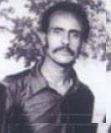 |
Solomon Wolde Mariam who was the head of Halewa Sewra when many innocent fighters including Menka group became his victims. According Solomon a large number of people were killed during he was in the leadership and the head of Halewa . He added that around one thousand fighters who participated in the Menka movement were rehabilitated after undergoing serious political indoctrination and self-criticism ( Mengiseab,49:2005) Regarding this when he was asked about them by the public at the meeting in Keren in 1978, he admitted that all of them were innocents. Below is an excerpt from The case of Solomon[text] |
The picture which will see below was the Halewa Sewra (Gestapo section of the EPLF) where Dehab Tesfatsion, Aberash Melke and Werku Zerai were impresion in 1973. Teklay Aden described Halewa Sewra in the following: The most criminal and notorious organ within the EPLF is known as 'Halewa Sewra or the security department. This is the Gestapo section in the EPLF assigned with the task of arresting, torturing and killing elements who opposed the leadership clique.ስዉእ ተጋ ሙሴ ተስፋሚካኤል እዚ ውድብ ዚ ከይዱ ከይዱ ውልቀ ሰብ ዝመልኮ ከምቲ ኣብ ቺለ ዝርከብ ቀንጻሊ መንግስቲ ፒኖሸ ክተክል እዩ ዝቃለስ ዘሎ ዝበለ .
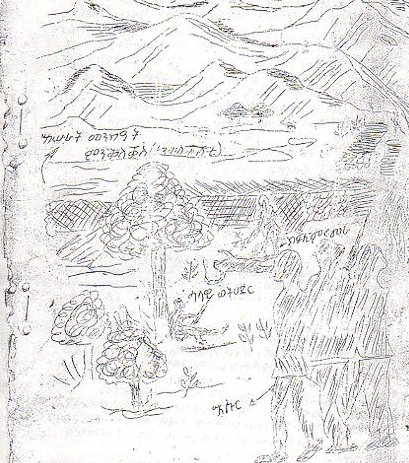
Source EPLF Prison System of 1970s in picture asmarino.com [The Main EPLF prison's center was located at Faha, Belekat and Gerger from 1974 to 1978. [[ Interview with Tesfay Temnewo [Part 23]]]
Let's remember the first EPLF women fighters
Aida Kidane, 02 March 2005
The three women are: Dehab Tesfatsion, Aberash Melke and Werku Zerai. In 1973, they were students at Haile Selassie University (currently Addis Abeba
University) who chose to leave their comfortable lives to join their brothers in the armed struggle to liberate their country and themselves.
These amazing women were intellectuals who soon became involved in the policy debates over the nature and direction of the armed struggle known as
"MenkE". Along with their mates, they suffered the consequences of their democratic and open actions by being put in prison; in separate cells from
their male comrades.
The women were never charged in an official capacity but were treated with suspicion and were accused of being spoilt on upbringings and of unknown
origins according to "Destructive Movement of 73", Tigrina. Some of the students survived the "MenkE" accusations by recanting their testimonies
while, while six of the others were executed, two of whom were women. The numbers of the MenkaE who perished are larger than the said 6.
"Menkaay" in 1975 documents the humiliation the women fighters suffered by being jeered at and accused of coming to meda looking for husbands! Not only did they have to endure harsh climate, difficult living conditions and risk their lives, but had to put up with accusations from their chauvinist counterparts who did not give them thebrespect they deserved. In 1975 many educators were joined the EPLF and some of them with good educational background were also killed by the EPLF because they were always suspected of being supporters or sympathizers Menkae.
ቀዳሞት ደቀንስትዮ ተጋደልቲ ወርቁ ዘርኣይ፡
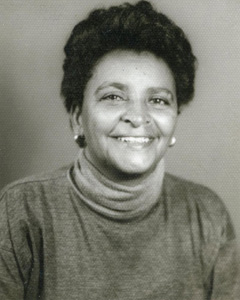
ወርቁ ዘርኣይ ኣብ መጋቢት 1973 ኣብ ዩኒቨርሲቲ ኣዲስ ኣበባ፡ ቀዳማይ ዲግሪ ምስ ዝዛዘማ ቀንዲ መሓዙታ ደሃብ ተስፋጽየንን ኣበራሽ መልከን፡ ኣብ ልዕሊ ህዝቢ ኤርትራ ንዝወረደ ጐበጣን ዓመጽን ስርዓት ሃይለስላሰ ብረት ዓጢቐን ክገጥማኦ ካብ ኣዲስ ኣበባ ናብ ህዝባዊ ሓይልታት ንሜዳ ተጸምቢረን።
እዘን ካብ 1971 ኣትሒዘን ጥሒሻ ኣብ ዝተባህለ ምስጢራዊ ምንቅስቓስ ዝሳተፋ ዝነበራ ሰለስተ መንእሰያት፡ እተን ኣብ ህዝባዊ ሓይልታት ብረት ዓጢቐን ዝተጋደላ ቀዳሞት ተቓለስቲ እየን። ካብ ኣስመራ ዝተሰለፈት መዓሾ እውን ራብዐይተን ነይራ። ወርቁን ደሃብን ካብ መባእታ፡ ምስ ኣበራሽ ከኣ ኣብ ላዕለዋይ ደረጃን ዩኒቨርሲትን ብሓንሳብ ዝተጓዕዛ፡ ዳርጋ ኣብ ኵሉ ህይወተን ይዅን ብምስጢር ተወዲበን ኣብ ዝሰርሓሉ ዝነበራ ፖለቲካዊ ንጥፈታት ብሓባር ተዋሲአን። ክንዮ እቲ ዘራኽበን ፖለቲካዊ ዛዕባ ከም ደቀንስትዮን መዛኑን ናይ ልበን ዘዕልላን ኣዝየን ዝፋተዋን መሓዙት እየን ነይረን። readmore
Hiwet Ogba Giorgis
Hiwet who had been a domestic worker in Asmera and had then migrated to Aden in 1966, played a key role in this process. She told Wilson about it
At the time I was not politically conscious. But when I was in Aden I gradually got involved in the Yemeni struggle for liberation. I had experienced in Italians, British, the Ethiopians, so I felt something for the Yemeni fighters-I cannot tell why but I felt it in my heart and I started helping them. I started contributing monthly to their struggle, cooking for them and taking food to their hiding places-I got really involved... When they got their independence they gave me a three-story house in Aden which I later gave to the EPLF.
It was through the Yemenis that the Eritrean fighters heard of me. They asked me to help them because wounded from the field were coming for treatment to Aden. I took them, cooked for them and did all the administrative work necessary... Once I got involved I stopped working as a domestic. But the Ethiopians got suspicious. They refused to renew my passport because I was working with rebel, and told all other Eritrean domestic workers to stop speaking to me or they would lose their passports too. I got a Somalia passport and I stopping going to Asmera. My friend Haddas Haile who was also a domestic worker refused to obey the Ethiopians and lost her passport too, but she also managed to get a different one. I would go and see the fighters who had been injured and were in hospital. When they recovered I would bring them to my house, feed them and so on till they were ready to leave for the field.
It was in that period on one unforgettable day I met two Eritrean fighters-Maasho and Tuku Yihedego. They were from the ELF and they looked very deeply sad. They told us that two of their friend Woldai Gidai and Kidane Kiflu, had been murdered by the ELF in Kassala... for their democratic ideas. Soon after they and two others, Mesfin Hagos and Mehari Debassai, began to orientate us politically. They explained that we had to start afresh because the ELF couldn't be changed. We had to start something new. They told us to be strong and firm. Tuku said it was a moment when history was being made. We wrote our name together on a paper and we swore on a candle that we would never betray Eritrea. Tuku later married my life-long friend Haddas. She now has a son, name Kidane after Kidane Kiflu. Tukhu wanted that child very much but never lived to see him.
In 1970 the EPLF was formed I had given them my house and it was like a meeting place for those coming from and going to the field. Then in 1971 I was arrested and put in prison for nine months, I still do not know on whose behalf it was done. The Aden government had been sympathetic to us, but maybe there was a stand within the security who were against us, or maybe it was on behalf of the ELF. For three weeks I was beaten up- slapped so hard that my hearing has been impaired on one side.
They asked me Do you know the people you are entertaining? Have they got guns? Where do they go? They asked me about certain specific people? They threatened to kill me if I didn't tell them. I said I don't know anything about politics.I just help them because they are Eritreans. Eventually the EPLF intervened they were strong and well established by then, and they approached the number two man in the government and I was released. I carried on my work in Aden, and later also co-ordinated the care of the wounded in Beirut and Syria source Wilson, Amrit (1991 pp.94-95)
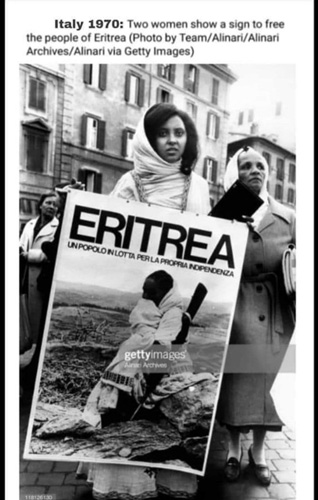
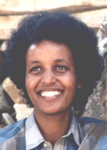 |
 |
 |
 |
As mentioned earlier in the 1960s there were not many women within the Eritrea Liberation Front but gradually their numbers increased. By the end of the liberation struggle the number of female fighters within the EPLF was estimated to be between one third and quarter of the fighters.
These female fighters who joined the EPLF not all of them did so joined the Front out of conviction, some were caught up in the strategic retreat and did see no other choice to survive than to join, others who were forcefully recruited against their will. Muller(2005: 47)
Generally here is a brief description on those contributor factors for increasing the number of women fighters within the ELF from 1975-1980 and the EPLF from 1975-1991.:
Many Ethiopians were deeply upset on May 24 1993 when Eritrea became independence. Many of them believed that the Eritrean people struggle became strong because of support from the Arab countries. This is not true. The main cause for the strength of the Eritrea revolution after 1975 was that in the 1970s many Eritreans joined the ELF and EPLF because the Ethiopia soldiers committed crimes against them. Ethiopians should blame their rulers not the Eritrea revolution. Since 1962, when Eritrea was occupied by Ethiopia, its rulers attitude toward the Eritrean people was :“We need the land not the people”
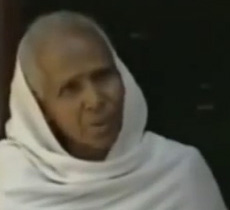
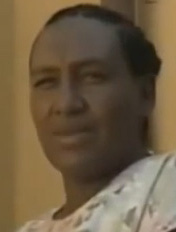
Mother and daughter. Saba's mother said her daughter risked rape and death here , it was better to go and fight in the resistence Source for the above picture
:
Background information on Ethiopian government policy between 1962 and 1974
Following the independence struggle in 1961 and the decalaration of the state of emergency in 1970 Eritrean students, teachers and other educated classes became a target of the Ethiopian government. Ephrem(2007:79 ) states that the Ethiopian government made every effort to suppress Eritrean identity, culture and tradition. To implement this policy the first step which taken by the Ethiopian government was to destroy all books written in Eritrean languages. As a result of this policy all publications in local languages were discouraged or banned outright, with the exception of a single newspaper, written in Tigrinya and Arabic, which Ethiopia used for propaganda purposes. Negash also states that the Ethiopian government in order to restrain the progressive education system in Eritrea replaced as a first step Tiginya and Arabic with Amharic the official language of Ethiopia. Thereafter, all the school textbooks and other documents which had been written in Tigrigna were burnt [11], by the Ethiopian government. Yohannes Zeggai documented it as follows.
“A greater part of the books, together with other documents, were burned in 1963 in the industrial oven of the Matches Factory in Asmara. The same took place at the Ceramic Factory in Asmara. Private collections were also gathered and destroyed in similar fashion” (Negash , p10). Ephrem adds that Ethiopian education policies in Eritrea between 1962 and 1974 were designed to erase Eritrean national identity, foster Ethiopian nationalism, facilitate the growth and development of the Amharic language, and curtail access to education for the Eritrean child.(Ephrem 2007:800
Salem Solomon (2013) also states that my mother grew up at a time when Ethiopia forcefully annexed Eritrea and attempted to undermine the intellectual strength of the country by shifting all higher education to its capital in Addis Ababa. The goal was to co-opt the energy and intelligence of the best and the brightest of the country. During this time, Haile Selasie, the emperor of Ethiopia, held campaigns calling all high school students to migrate to Ethiopia. Advertisements on radio and newspapers targeted young students and provided opportunities in Ethiopia. Amharic, the official language in Ethiopia, was forcefully introduced in the curriculum in Eritrean high schools.
Following the annextion in 1962 the Ethiopian government gradually introduced a calibration of examination scores for entrance to the university according to the province of origin, in order to limit places in higher education for Eritrean students. Based on this policy, students from provinces with poor educational endowment needed only to achieve low marks to gain entrance to the university compared to those with better schools in Eritrea. This policy was not applied to Addis Ababa which had a higher number of foreign teachers as compared to Eritrea. (Table 3)
Table 3.
Provinces |
Schools |
Students |
Eth.Tech |
Fore.Tech |
Shoa |
105 |
35, 534 |
748 |
57 |
Gojjam |
36 |
9, 527 |
242 |
17 |
Wollega |
45 |
12,651 |
253 |
10 |
Arussi |
34 |
6,839 |
237 |
15 |
Bale |
12 |
2,594 |
85 |
6 |
Harar |
36 |
12, 535 |
266 |
43 |
Sidamo |
43 |
12,571 |
278 |
12 |
Bigemidir &Semien |
52 |
10,340 |
286 |
23 |
Tigre |
9 |
8,795 |
192 |
18 |
Wollo |
33 |
10, 876 |
337 |
29 |
Gemu-Gofa |
17 |
3, 163 |
143 |
7 |
Illubabor |
36 |
5,745 |
165 |
8 |
Kaffa |
13 |
5, 800 |
173 |
14 |
Eritrea |
190 |
40,565 |
830 |
70 |
Addis Abeba |
40 |
29,908 |
827 |
241 |
Source: A historical survey of state Education in Eritrea p.101
The standard of education in Eritrea was far in advance of the Ethiopian education system which was ranked bottom among African nations at the Conference of African States on the Development of Education held in May 1961 [12]. Because of this and other factors such as thirst for education that was aroused during the British Administration, Eritrea was among the main sources of students for the university in Ethiopia through the Ethiopian School Leaving Certificate Examination (E.S.L.C.E) as shown in table 18.
Erlich (1983) who was lecturer at the University of Addis Ababa also observed that the proportion of Eritreans at this University was higher than for Ethiopians in the early 1970s. A lecturer, who had worked in Ethiopia in the early 1970s claimed that there were more Eritrean students than Ethiopians at Haile Selassie I University during the period that he taught there.
Table 4
Provinces |
1968and 1969 E.S.L.C.E Passes |
Rank order of passes |
Arussi Bale Begemeder & Semen Eritrea Gomu Gofa Gojjam Hararhe Illubabor Kaffa Shoa Addis Abeba Sidamo Tigre Wellega Wollo |
7 1 9 118 2 5 31 - 3 74 431 7 30 7 18 |
8 13 7 2 5 11 4 14 12
1 9.5 5 9.5 6 |
Source: A historical survey of state Education in Eritrea p.106
Once the students had gained qualifications in Ethiopia . or overseas, they had wider opportunities than their Ethiopian counterparts. Most of them secured better jobs in the private and public sectors. Many modern organizations employed a disproportionate number of Eritreans in jobs including the Ethiopian Airlines, Telecommunications , Ethiopia Electric Light and Power Authority (EELPA), the Air Force, banks, hospitals and other public sectors . As a legacy of the Eritrean federal government’s educational system Eritrea, in the early 1960s, had a sizeable intelligentsia at an intermediate professional leve
However, in the 1970s many Eritrean professionals who had graduated from university and students from higher education institutions became the victims not only of the Ethiopian government but also of the EPLF and ELF leaderships. According to the Human Rights Watch, there was a great deal of violation of academic freedom at the University of Asmara , which included the killing of Dr. Petros Habtemikael and others in 1975. Consequently the number of Eritrean professionals, students and schools started to decline from 1974 onwards.The numbers of students and schools started to decline between 1974-1978 (Africa Watch ,1993), and between 1974 and 1980 the number of Eritrean teachers in Eritrean schools fell from 3,000 to 1,200 and many of them joined the EPLF and ELF or went in to exile.
Kidane, Eyob (2002) also states that after the annexation of Eritrea in 1962 and the formation of ELF in September 1961, the Haile Selassie regime with its scorch earth policy and mass killings in the Easter and Western Eritrean lowlands burnt villages including the schools and some schools were used as military camps. Tens of thousands of Eritrean people including students and teachers were uprooted from their villages and towns and forced to flee and seek refuge in the Sudan. The Derg pursued this barbaric policy in its worst manner and thousands of students and teachers were tortured and killed. Following the heavy and fierce fighting in areas surrounding Asmara in January 1975, the number of schools and students dramatically dropped. Many students were also massacred, mass imprisonment, detention, blockage of main roads, others were forced to serve in the military and some others were forced to leave their villages and towns either to join the liberation fronts or to seek refuge through out the world.
By 1980s, there were more than 2,000 non-Eritrean teachers in Eritrea. Furthermore the balance among staff and students between Eritreans and Ethiopians changed at the University of Asmara (Africa Watch (1993). Africa Watch adds that by 1990 62 % of the staff were non-Eritreans, and 91 % of the students were from Ethiopia Tsega Gaimin a teacher who graduated from Asmara Teacher Training Institution (TTI) in 1975 and then joined the EPLF in her interview with Tanja R also mentioned that ‘out of around 500 students at TTI I think we were only 16 Eritreans’.
Overall, the number of Eitrean schools also fell from 3,000 to 1,200 between 1974 and 1980. Many of the teachers joined the EPLF and ELF or went in to exile. One of those teachers who joined the EPLF in 1974 and greatly contributed to the literacy campaign among civilian women from 1975 to 1978 was Saba Gidy
ፈላሚት_ሓኪም_ስኒ_ ገጽን_መንጋጋን
ኣብ ሰዉራ ኤርትራ
ተጋዳሊት "ዶር ላይነሽ ገብረህይወት
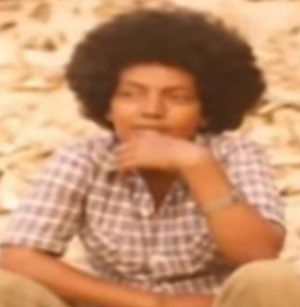
ዶክተር ላይነሽ ገብረህይወት ኣብ "ህዝባዊ ግንባር" እታ ቀዳመይቲ ሓኪም ስኒ : ገጽን መንጋጋን ከም ተወሳኺ መምህርን ኣማሓዳሪትን ዝኾነት ዋዕሮ።
ኣብ ውግእ ብከቢድ ተሃሪሞም ንዝመጹ ውጉኣት ተጋደልቲ ብፍላይ ምስ መንጋጋ ስኒ ገጽ ብዝተሓሓዝ ኣብ ምሕካምን ንካልኦት ኣብቲ ሞያ ኣብ ምስልጣንን ካብተን ብኣብነት ዝጥቀሳ ክኢላ ሓኪም ሓንቲ እያ። ዶክተር ላይነሽ ገብረህይወት ስድራቤታ ብንእስነታ ስለዝሞቱ ምስ ሓዋ ኣብ ኣዲስ-ኣበባ እያ ዓብያ፡ ንዝለዓለ ትምህርቲ ናብ ቤላሩስ "Belarus" ብምኻድ ሓኪም ስኒ ብምዃን ብዲግሪ ተመሪቓ ። ድሕሪ መመረቕታ ኣብ ሂወታ ዓቢ ዝኾነ ውሳነ ወሰነት ። ናብቲ መሪር ዝኾነ ውግእ ዝካየደሉ ዝነበረ ሰውራ ኤርትራ ኬድካ እጃምካ ምብርካት ዝብል ተባዕ ውሳነ ወሰነት።
ካብ "ቤላሩስ" ናብ "ቡልጋርያ" ተጓዒዛ፡ ኣብ "ቡልጋርያ" ንሓጺር ግዜ ድሕሪ ምጽናሕ ናብ "ሮማ" (ዓዲ-ጥልያን)፡ ካብኡ ናብ "ካርቱም" (ሱዳን) ኣምሪሓ፡ ካብ "ካርቱም" ብቐጥታ ናብ ሜዳ ኤርትራ ናብ መሳርዕ ህዝባዊ ሓይልታት ተሰሊፋ።
ዶክተር ላይነሽ ኣብ 1977 ክትስለፍ እንከላ እቲ ቐዳምነት ዝገበረቶ ነገር ነቲ ዘይነበረ ኣገልግሎት ሕክምና ስንን ገጽን ምምስራትን፡ በቲ ዘሎ ድሩት ዓቕሚ ሕክምና ኣገልግሎት ምሃብ እዩ ።
በቲ ዝነበረ ውግእ ተሃሪሞም ዝመጹ ተጋደልቲ ብዘለዋ ክእለት ናብ ንቡር ዘይኮነ ጥቃ ንቡር ንምምጻእ ምጽዓርን መጻኢ ሂወት እቶም ውጉኣት ኣብ ምምሕያሽን እያ ተጸሚዳ ።
ጎኒ እቲ ሕክምናዊ ኣገልግሎታ ሓደስቲ ሓካይም ኣብ ምፍራይ ደኺመ ከይበለት ብዙሕ ፍልጠትን ክእለትን ናብ ካልኦት ኣመሓላሊፋን ተመሓላልፍ ኣላን።
ብፍላይ ኣብ መንከሶም መንጋግኦም ተሃሪሞም ዝመጹ በቲ እትገብረሎም ሕክምና ዝያዳ ትፍለጥ።
ንውልቅኻ ንፉዕ ዋላ እንተኾንካ ግን ምስ ካልኦት መሳርሕትኻ ብምትሕግጋዝ እትሰርሖ ስራሕ ዝያዳ ውጽኢታዊ ከም ዝኸውን እያ ትጉስጉስ ።
ኣብዘን ልዕሊ 43 ዓመታት ዝገበረቶ ልምዲ ስርሓ ተወሃሂድካ ምስራሕ ነቲ ትሰርሖ ስራሕ ዓቢ ውጽኢታዊ ከም ዘለዎ እያ ትዛረብ ። readmore
Saba Gidy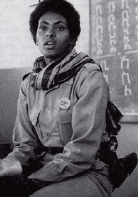
Saba Gidy graduated from Lycee Gibra Mariyam (French School) Addis Ababa and became a secondary school french teacher in Dekemhare. She joined the EPLF from Dekemhare in late 1974 and was working in the Department of Public Adminstration (Jemher) in the Karnishim area of the highlands from 1975- 1977. Subsequently, she was in the combat force at the Massawa Front line for a short period where she was killed in action. In 1970s and 1980s someone who was suspected of having different views from that of the EPLF leaders was commonly sent deliberately from Kefletat (EPLF departments) to the front line, without appropriate military retraining . This happened to many of the EPLF fighters who were killed at the Massawa front in 1977 and 1978. Many of them became a forced martyr. Saba Gidy was one of them. . [Interview with Tesfay Temnewo - Part34]
ሓጺር ታሪኽ ስውእቲ ሳባ ግደይ ዕዋል፡ ብጽገ መንገሻ ካብ ዝተጻሕፈ ምስክር ዘርእስቱ መጽሓፍ ዝተጾምቀ
ገዲም ተጋዳሊት ኤልሳ ኣማረ (ተሓኤ)።
።.jpg)
ንዝኽሪ 8 መጋቢት ገለ ካብ ዋዕሮታት ጀጋኑ ስውኣትና፡ጸሃይነሽ ሃይለ መሓረና chemistry BA Addis A University ፡1975 ሩባ ጋሽ ወገን ኦምሓጀር፡ ነቢያት ኢስቲፋኖስ 1977 ዓዲ ሓንስ መቐርካ።ትሕዝቶ ሓጺር ታሪኽ ሂወተን ኣብ Tv Sened በዚ ዝስዕብ link ክትርእይዎ ይከኣል፡https://youtu.be/J3ZsJH-MTj8?si=1f3h6LgLMg69_jKN
| ነቢያት ኢስቲፋኖስ | ጸሃይነሽ ሃይለ መሓረና |
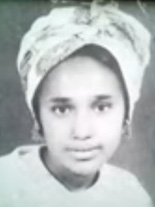 |
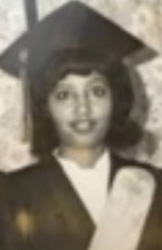 |
Eyobel Haile Negusse (Gual Haile)
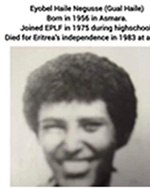
Eyobel Haile Negusse (Gual Haile) was born in 1956 in Asmara. She was was the 8th child out of 11 children house hold. Enjoyed playing basket ball at Luel Mekonnen Highschool in Asmara. She was lovely woman, always smiling, family oriented and was popular and loved by her peers around the city of Asmara. She had a great sense of humor and was a joker. She joined the EPLF in 1975 during highschool. She was a lead of a cell (Wahyo) movement in the city throwing pamphlets with information about the Liberation struggle for Eritrea. She fought with Dignity, Compassion and care and gave her life for better Erittea in the battle of 7th offensive in 1983! 'Love' 'Outspoken' 'Compassion' and family woman. She fought in Brigade 23 which was one the strongest forces the EPLF had. She's a mother of one and an aunt to many.
.
Glory to our Martyrs! May they rest in peace.
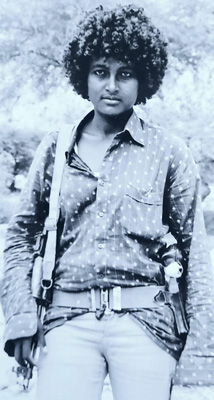
መብራት ሓድጉ ጓል 16 ዓመት ከላ፡ ኣብ 1978 ናብ መሳርዕ ህዝባዊ ግንባር ተሰሊፋ፡፡ ካብ እዋን ምዝላቕ ክሳብ ዛዛሚ ኩናት፡ ኣብ ከበድትን ፎከስትን ውግኣት ተሳቲፋ፡ "ኣብ ስርሒት ፈንቅል ከም መራሒት ጋንታ" ልዕሊ 6 ግዜ ዝተወገአት ተጋዳሊት ኣደ እያ። እዚ ሕጂ ንዙረት ወሪድና ሸናዕ ኢልና ነስተማቕሮ ጎደናታት ከተማ ምጽዋዕ፡
መብራት ሓድጉ ኣብ ስርሒት ፈንቅል መራሒት ጋንታ ኮይና ዘዋጋኣትሉ ስፍራ እዩ። ዘለዋ ጦብላሕታ ድማ ነዚ ይመስል።
ወርሒ ቅድሚ ፈንቅል፡ ውግእ ኣብ ዘይተፈልጠ ቦታ ኔሩና። ካብ ግንባር ሓልሓል ተበጊስና፡ ልዕሊ 1000 ኪ፡ሜ ተጓዒዝና ዶብ ሱዳንን ኢትዮጲያን በጺሕና። ኣብኡ ምስ በጻሕና ብሓለፍትና ንኣሶሳ (ንርእሰ ከተማ ክፍለ ሃገር ኢሉባቦር)፡ ክንድምስሳ ሙዃና ተሓቢሩና።
ነቲ ለምለም መሬት ኢትዮጲያ ምስ ረኣኹ፡ ኢትዮጲያውያን እምበርዶ ሽሻዮም ይፈልጥዎ እዮም?ክንድዚ ዝኣክል ሃብታም መሬት ከለዎም ዘይዓዶም ክወሩ ሂወትን ሃብትን ህዝቢ ኢትዮጲያ ዘጥፍኡ ኢለ" ድሕሪ ሓደ ሰሙን ነቲ ተዋጊእና ዝሓዝናዮ ከተማ ነቶም ኣንጻር ደርግ ዝዋግኡ ዝነበሩ "ግንባር ሓርነት ኦሮሞ" ኣረኪብናዮም ናብ ዝነበርናዮ ቦታ ተመሊስና፡፡ 5 መዓልቲ ምስ ኣዕረፍና ናይ ተበገስ ትእዛዝ ተዋሂቡና። ካብ ግንባር ሓልሓል፡ ኣፍዓበት ሰንጢቕና ሽዕብ በጺሕና። ተልእኾና ባጽዕ ንምሓዝ ሙኻኑ ከኣ ብብጻይ ፍሊጶስ ወልደዮውሃንስ ተሓቢሩና። "ሎሚ በዚ ፈንቅል ተሰምዩ ዘሎ ስርሒት ነታ ደርግ ጎሮሮና ዝብላ፡ ከተማ ባጽዕ ሓራ ኣውጺና ንደርግ ንዘልኣለም ጎሮርኡ ክንበትኮ ኢና፡ ባጽዕ ዳግማይ 77 ኣይትኸውንን እያ" ኢሉ ብምትእምማን ገሊጹ ካልእ ክውስኽ ምስ በለ ኩልና "ኣይትኸውንንያ" ብምባል ጨሪሕና፡ ተበገስና።
☆ ንስኺ ንጋንታኺ ዝሃብክዮ መምርሒ'ኸ?
● ኣነ ውን ብወገነይ፡ "ሎሚ ይኹን ጽባሕ ነቲ 77 ኣብ ሳሊና ዝተቐብረ ሬሳታት ብጾትና ረጊጽና ክንሓልፍ ስለ ዝኾና፡ ሕድሪ ሰማእታትና ከነኽብር ሃንቀውታ ህዝብና ክንምልስን ተቢዕና ክንዋጋእ ኣለና" ኢለዮም።
ውግእ 8 ለካቲት 1990 ጀሚሩ። ከቢድ ኩናት እዩ ኔሩ። ንጽባሒቱ ዕለት 9 ንመጥቃዕትና ክጻወር ዘይከኣለ ጸላኢ ዝማረኽ ተማሪኹ ዝሃድም ከኣ ሃዲሙ። 10 ለካቲት ቦጦሎኒና ምስ ካልኦት ኣሃዱታት ተኣሳሲራ ሓይሊ ጸላኢ ደምሲሳ ኣብ ከባቢ እንዳ ስሚንቶ ዕማማ ዛዚማ፡፡ ድሕሪ ከበድቲ መጥቃዕታትን ዝተኸፍለ መስዋእቲን፡ ኣጋ ፋዱስ ወደባዊት ከተማ ባጽዕ ሓራ ከም ዝወጸት ብድምጺ ሓፋሽ ተበሲርና።
ዝበዝሐ ክፋል ባጽዕ ሓራ እኳ እንተወጸ፡ ኣብ ጥዋለት ሓደ ጀነራል ሰራዊት ኢትዮጲያ፡ ህዝቢ ከይወጽእ ድፋዕ ጌሩ 5 መዓልታት ጌሩ ነበረ፡፡ ብሓለፍቲ ህዝባዊ ግንባር ነቲ ጅሆ ሒዝዎ ዘሎ ህዝቢ ለቒቑ ኢዱ ምስ ዘይህብ ክድምሰስ ሙኻኑ ተሓቢሩ።
እቲ ጀነራል ግን ካብ ኣስመራ ብኣጋርን ነፈርቲ ኩናትን፡ ብዓሰብ ድማ ዘመናዊ ናይ ውግእ መራኽብ ዝዓጠቐ ሰራዊት ይመጸካ ኣሎ ስለ ዝተባህለ፡ ነቲ መዓልታት ከናውሖ መረጸ።
ዝተዋህቦ መዓልታት ምስ ወድአ ድማ፡ ህግ ብ15 ለካቲት ሰዓት 6 ምሸት ብመሬት ብስጋለት ቀጣን ብባሕሪ ድማ ብርእሲ ምድሪ መጥቃዕቲ ከፈተ።
ጋንታና ምስ ስለያ ክፍለ ሰራዊት 70 ብማእከል ጽርግያ ስጋለጥ ቀጣን፡ ብየማንን ጸጋምን ጫፍ ባሕሪ ክንኣቱ ተሓቢሩና። ስጋለት ቀጣን ከምዛ ኣብ መንጎ ክልተ ባላ ዝተተኽለት መስጥሒ ክዳን እያ፡ በዛ ቀጣን ገመድ የማን ጸጋም ሰንከል ከይበልካ ምሕላፍ እዩ እቲ ዕማም፡፡
ጸላኢ ነዛ ሓደ ኪሜ ዘይትኣክል መንገዲ ካብ ካላሽን ጀሚርካ ክሳብ፡ መዳፍዕ፡ ረሻሻት፡ ጸረ ሚሳይል፡ ታንክታት ጌሩ ዓጊትዎ እዩ ኔሩ፡፡ ብወገና ውን ኣብ ሲነማ ኣይዳን ቶታልን ኣጽዋር ተጻዊዱ ኔሩ እዩ።
ሰዓት 6፡30 ኣጋ ምሸት፡ብማእከልነት ቦጦሎኒ ብጻይ የማነ ጠዓመን መራሒት ሓይሊ ፍዮሪ (ጓል መሓርን)፡ ዘወሃሃድዋ ሓይልና ብየማንን ጸጋምን ናይቲ ባሕሪ ንመጥቃዕቲ ተበጊስና፡፡
ኣነ ዝመርሓ ጋንታ ድማ ካብ ቶታል ንየማን ብማእከል እቲ ልዕሊ መዓጥቖና ዝበጽሕ ማይ ባሕሪ ተበጊስና።
ኣብቲ ኣብ መሬት ዝነበረ ውግእ ታንከኛታትን ኣጋር ሰራዊትን ጸላኢ ጠኒኑ ይኣቱ ብምንባሩ ብዙሕ መውጋእትን መስዋእትን ኣጋጢሙና እዩ።
ሰዓት 7፡30 ኣቢሉ እቶም ብሰለስቲኡ መኣዝን ዝተበገስና፡ኣብ ከባቢ ቤተክርስትያን፡ ኣብዚ ሕጂ ሓወልቲ ተሰሪሕዎ ዘሎ በጺሕና፡፡ ብወገን ምብራቕ ብጀላቡ ተጻዒኖም ኣብ ርእሲ ምድሪ ዝነኸሱ ሓይልታትና ድማ ኣብ ከባቢ ወደብ በጺሖም።
ኣብ ጥዋለት፡ ነተን ጠያይትን ቦምባታትን ወዲአን ዝነበራ ታንክታት ጸላኢ ብኣርብጂ ክንሃርመን ምስ ፈተና፡ ከምዚ ኣብ ዓውዲ ዝወደቐ እኽሊ ኣብዑር ዘንጠቕጥቕዎ ክረጋግጻና ሸንኮለል ኢለን። ታንክታትና ውን ከምዚ ኣባእሳ ኣብዑር ገጽ ንገጽ ገጢመንአን።
ክረግጻና ምስ ደለያ፡ ናብቲ ፍርስራስ ፓላሶታት ኣቲና። መሬት ወጊሑ ክሳብ ዝዓርብ ካብ ፓላሶ ናብ ፓላሶ፡ ካብ ገዛ ናብ ገዛ ምቕያር ኮይኑ።ሰዓት 8 ናይ ምሸት ግን፡ ኩሉ ዘፍ ኢሉ ኣብ ዘዘለናዮ ሓዲርና።
☆ እሞ መውጋእትኺ ደኣ መዓስ እዩ ኔሩ?
● ሽዓ ንግሆ!!! ኣብታ ዝነበርናያ ቦታ፡ብድሕሪት ዝገደፍናዮ ማእከልነት ጋንታ ዶሽካ መጺኒ፡ እንታይ እዋንካ ሰጊርካ እንዳበልክዎ፡ ኣብቲ ፓላሶ ዝጸንሐ ወተሃደር ጸላኢ ሃሪሙ ኣውዲቕልና። ሬድዮ ናቱ ኣልዒለ፡ ገዛ ገዛ ኣቲና እንዳፈተሽና፡ ንግሆ ሰዓት 8፡ ንዓይ ውን ተሓቢኦም ዝጸንሑ ወተሃደራት ብኣድራጋ ጠያይት ነታ ጥዕይቲ እግረይ ሃሪሞምኒ ኣብኣ ተወጊአ። እታ ሓንቲ እግረይ ናይ ቅድሚኡ ማህረንቲ ኔርዋ።
ኣብታ እዋን ካብ ሓይልና፡ ኣነን ወዲ ሓውስን መራሕቲ ጋንታታት፡ ጓል መሓሪ መራሒት ሓይሊ ተወጊእና ወጺና።
ንሕና ኣብ ከባቢ፡ ናቫል በይዝን እንዳ ስሚንቶን ኣብ ዝነበርናሉ፡ ኣብ ስጋለት ቀጣን ከቢድ ኩናት እዩ ኔሩ። ኣብቲ እዋን ጨው ቀትሪ ስለ ዝነበረ ተጋዳላይ እናረኣኻዮ እዩ ኣብ ማእከል ጽርግያ ዝወድቕን ኣብ ባሕሪ ዝጥሕልን ኔሩ፡፡እዚ እናኾነ ግን ሳላ እቲ ብተደጋጋሚ ዝተኻየደ ህጁማት፡ ጸላኢ ዘፍ ኢሉ። ንስጋለት ቀጣን ከኣ ጥሒስና ክንሓልፍ ኣኽኢሉና።
☆ ኣብ መወዳእትኡ ከ?
● ንባጽዕ እንዳተዋጋእና ኢና ኣቲና፡ ኣነ ኣብ መንጎ ተወጊአ ገዲፈያ። ድሕሪ ሓደ ወርሒ መውጋእተይ ሕይሽ ምስ በለኒ፡ ነታ ዝተወጋእኩላ ቦታ ክርእያ ሰዓት 5፡30 ኣብ ጥቓ ስጋለት ቀጣን ክበጽሕ ከለኹ፡ ነፈርቲ ኩናት ደርግ መጺአን ኣብ ልዕሊ እቲ ኣብ በረኻ ውዒሉ ናብ ሰናይ መነባብርኡ ዝምለስ ዝነበረን ኣብ ቃልዕ ቦታ ንግዳዊ ንጥፈታቱ ከካይድ ዝጀመረ ሰለማዊ ህዝቢ እቲ "ብቕብጸት" ዝፍለጥ ኣዕናዊ ቡንባታት ኣዝኒበን፡፡ ኣብ 10 ደቒቕ ዘይመልእ ድማ ሂወት ኣማኢት ሰባት ቀዚፈን።
ኣነ ኣብዛ ዕለት ካብ መቕዘፍቲ ንስክላ ድሒነ፡ እንሆ ድማ ሕጂ ታሪኽ ኮይኑስ ኣብ መበል 34 ዓመት ንዝክሮ ኣለና።
#fenkil2024 source from facebook
ኣኽበረት
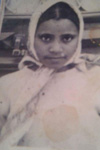 ++
++
ሓንቲ ካብተን ንህላወይ ዝሓለፋ ሂወት
::::::::::::::::::::::::::::::::::::::::::::::::::::::::::::::::::::::::::::::::::::
እቲ... ኣብቲ ግዜ እቲ ዝተዛረበቶ ዘረባ ዘይርሳዕ መንፈሳዊ መግብታተይ እዩ :: ንምድጋሙ ብዘየጸግም ኣብ ርእሰይ ቁሙጥን: ውቁጥን እዩ :: ኣእምሮይ : ዘይሃስስ ስእሊ ሕብሪ ክዳውንታ ውን ዓቂቡ ኣሎ ::እንተ ኾነ : እዚ ዝኣክል ዝኽርታት ኣተሲኡ ክንሱ ነቲ ልዕሊ ዝኾነ ካልእ ነገር ዘገድሰኒ ምስላ ከምጽእ ኣበደን ካብ ዝብለኒ ነዊሕ እዋን ኣቁጺሩ:: ኣይሓገዘንን ::
እታ ድምጻ ከም መቃልሕ ዝደጋገም : ልብሳ ከም ጽሓይ ደሚቁ ኣብ ዝኽርርታተይ እናሻዕ ዝቅጀል : ምስላ ካብ ኣእሙሮይ ምህዳሙ :ሰላም ዘይህብ ካልእ ውሽጣዊ ሕማም ምኻኑ እዩ ::ብዝክኣለኒ : ምስተን ገለ ዝርካበይ ናይ ንእስነታ ስእልታት ኣተሓሒዘ :ንዝነበረኒ ሃሳስ ዝኽሪ ከተስእ ርሑቅ ተተመላሊሰ ካብ ምድህሳስ እኮ እንተ ዘየዕረፍኩ እቲ ዝህበኒ ግብረ መልሲ ግን : ከም ምስሊ ከተምብቦን ክጭበጥ ብዘጸግም ካብ ሙኻን ሓሊፉ ዘጨንቅ ዝኾነሉ እዋን ውን ኣሎ ::እቲ ከም መደዓዓሲ ኣብ ኣእሙሮይ ዝመጽእ ምስሊ: ካብ ሚላኖ ተኸዲት : ኣብ ዕሙር ፍሪዝ ጸጉሪ ርእሲ :ዕማ ተጠምጢማ ኣኣብ ዝርእየሉ ስእሊ ቀያሕ ተጋዳሊት ንሳ'ዶ ትኸውን ካብ ምባል ዘድሕን ጥርጠራዊ ሓልወሳ ዘገላግል ኣይኮነንን ::
ሎሚ... እዚ ኣብ ኣእምሮይ ተሪፉን ሒዘዮ ዘለኹን ናይ ህጻንነት ስእልን ዝኽርን ብኽኢላታት ተሓጊዘ :ሓቀኛን ትኽክለኛን ዝኽሪ ምኻኑ ከረጋግጽ ስለ ዝኸኣልኩ ድኣ እምበር :ብዙሕ እዋን ነዚ ኣልዒለ ኣብ ዘዘንትወሉ ዝነበርኩ እዋን: ምስ ዕድመይ ብምትሕሓዝ ካብ ስድራቤተይ ጀሚርካ ክሳብ ኩሎም ቀረብተይ : ብዝህቡንን ዝብልዎን ዝነበሩ ግብረ መልሲ ነቲ ነብሰይ ርግጸኛ ኮይና እትዝክሮ ዝኽሪ ከይተርፈ ኣብ ምልክት ሕቶ ክእትዎ ክኢሉ እዩ ::ብብዙሓት.... እዋእ ህጻን እንዲኻ ኔርካ ዘይከውን : ዘይመስል ንዝብሉ ሰማዒ ዝሰኣንክሎም ዝኽርታት ብግብረ መልሲ ሰባት : ንነብሰይ :ኣብ ጌጋ ኣሎኺ ዘይእመን ኣይትዛረቢ ኢልካ ካብ ምዕጋሳ ዝኣክል : ነቲ ሓቀኛ ሎሚ ዘናድዮ ዘለኹ ምስሊ ከጥፍእ ዓቢ ተራ ተጻዊቱ እዩ ::
እቲ ርክብ ሃንደበት እዩ ኔሩ :: ምስ ኣደይ ኣብ ዝነበርናሉ ኣጋጣሚ በዚ መጺኣ ከይበልናያ እያ ህሩግ ኢላትና:: ኣደይ ምስ ርኣየታ : ብሓጎስ ተወሊዓ ብዕልልልልልልልታ መሬት ቀደደቶ :: ኣብ ካልእ ኣድህቦን ጸወታን ጸኒሐ ብስምባደ ሓፍ ብምባል ካብቲ ገዛ ከምልጥ ኣይርሳዓንን :: ንድሕሪት ብምምላስ ግን : ኣብ ኣፍ ደገ እቲ መእተዊ ገዛ ብምግታር ኩነታት ክዕዘብ ጀመርኩ :: እቲ ነዊሕ ዝወሰደ ብኸቢድ ብኽያት ተሓወሰ ምትሕቁቃፍ ንዓይ ውን ኣይተገደፈንን ::ኣደይን : እታ ጋሻን ተሓቃቁፈን ናባይ ብምጥማት ኩነታተይ ተገርመን ክልቲአን ብሓንሳብ ንዓ እባ በላኒ :: መልሰይ ኣብ እግራ እምቢ ነበረት :: እታ ተጋዳሊት እና ነብዐት ኣነ እየ እኮ :: ኣነ ኣኽበረት እየ : ብምባል : በጃኪ እባ ገለ ግበሪ ብዘስምዕ ኣጠማምታ ንኣደይ ብምርኣይ ብብኽያት ተነኽነኸት ::ኣደይ ኣብ ከቢድ ናይ ሓጎስ ህሞት ስለ ዝነበረት ብብኽያት ተሳዒራ ክትጥምተኒ ድኣ እምበር ክትዛረበኒ ዘኽእል ዓቅሚ ኣይነበራን :: ብውሽጠይ ትበኪ ተጋዳሊት ብምርኣየይ ኣብ ከቢድ ምግራም ኣትየ ከመይ ዓይነት ተጋዳሊት ድኣ እያ እዚኣ ወደይ ክብል ጀመርኩ :: ጽንሕ ኢላ : ካብ ቦርስኣ ሹሽ ዝብሃል ግኑን ናይቲ ግዜ እቲ ኣብ ማይ ኣእቲኻ ዝስተ ነገር ምስ ኣውጽአት ጽቡቅ ቀረብክዋ ::ኣኽበረት : ሓንሳብ ብኢዳ ምስ ሓዘትኒ ካብቲ ፈጺሙ ክሳብ ሎሚ ኣጋጢሙኒ ዘይፈልጥ ዘሰምብድ ኣሰዓዕማ ኣብ ውሱን ካሊኢታት ብዝሑ ብዘይ ፍለጥ ብተዳጋጋሚ ክትበልዓኒ ደለየት ::ከየምልጣ ጨቢጣ ብምሓዝ ታህና ኣውጽአት ::እታ :ኣነ እየ እኮ : እትብል ቃል ከየዕረፈት ብምድግጋም ድማ ክሳብ ዓቅለይ ጸቢቡኒ ዝበኪ ሰዓመትኒ ::
እቲ ... ኣነ እየ እኮ : ዝብል ቃል :ካልእ ስዉር መልእኽቲ የማሓላልፍ ምንባሩን ነቲ ምሳይ ዘለዎ ቀጥታዊ ርክብ ንኽርደኣሉን ክገልጽ ብዓቅሊ ጽበትን ስቡር ልብን ነቲጉ እንታይነቱ ክጋሃደሉ እናኣዕለበጠ ዝወጽእ ዝነበረ ቃል ምኻኑስ :ሕጂ እምበር ሽዑስ ኣበይ ኢለዮ ::
ኣባሃህልላኣ : ነቲ ናይቲ ሽዕኡ ዝነበረ : ኩነታት ብዘይዘርግ : ንዓይ ውን ብዘይብርዝ : መገዲ እቲ ሓቂ ክሳብ ክሞልቃ ዝደሊ ብተዳጋጋሚ ገለ ክትብል ትደሊ ምንባራ ብሩህ እዩ :: ኣነ እየ እኮ !!ኣነ እየ እኮ :: እቲ ዘየዕርፍ ተዳጋጋሚ ሌላ ::
ድሕሪ ነዊሕ ዓመታት :ካብ ብዙሓት ብቀረባ ዝፈልጥዋ ሰባት ብዛዕብኣ ዝኣከብክዎ ሓበሬታ እንተ ድኣ ኣሎ : ብትሕትናኣን ጠባያን : ብዙሕ ፈታዊ ዝነንባራ ምቅልልትን እሳ ውን ፈታዊት ሰብን ምንባራ እዩ ::እዚ በቶም ናይ ቀረባ ፈለጥታ ዝደጋገም ዘረባ ኮይኑ : ብምስትንታን ገጾም ውን ክዛረብ : ኣብ ዝተፋላለየ ኣጋጣሚ ብዝተፋላለዪ ሰባት ክደጋገም ናይ ቀረባ ሰማዕን ተዓዛብን ኔረ እየ ::
ኣብ ዝኽርታቶም :ስማ እና ኣልዓሉ ንዝነበራ ልቦናን : ጽባቀን ብኣድንቆት ክገልጹ ከለዉ: ንግዚኡ ክስእላ ዘየጸግም ኣጋጣሚታት ውን ኔሩ እዩ ::
ገለ ክፋል: ታሪኽ ሂወታ ውን : በታ ሎሚ ብሂወት ዘይትርከብ ወላዲታ ክዝንቶ እንከሎ ክኣ እሞ: ነቲ ኮፍ ኢሉ ምስማዕ ዘይፈቱ ከይተረፈ: ክምስጥ ዝኽእል ዝድነቅ ድሕረ ባይታ ዝሓዘት መንእሰይ ምንባራ: ኣብቲ ጽን ኢልካ ክትሰምዕ ዝግብረካ ነገር ጥራይ እኹል መልሲ ኣሎ ::
ኣኽበረት .. ሓንቲ ካብቶም ኣርባዕተ ኣሕዋት ኣለዉኻ ተባሂለ :ነዊሕ እዋን ምስ ሂወተይ ዝተጓዕዘት ግን ድማ ዘይፈልጣ ሰብ እያ ::ብሓሳብ ዝስእላ : ብመንፈስ ዝዛረባ : ብውሽጠይ ዝናፍቃ ኮይና: ክሳብ እቲ ዕለተ ምምላስ ኮይኑ :ነቲ... ንሳ እምበር ኣነ ዘይፈልጦ: እቲ.... ኣነ እምበር ንሳ ዘይተመለሰቶ ቦታ ዝበጽሕ ዝፈትዋን ዝናፍቃን ሓፍተይ እያ ኔራ ::
ዕለቱ ይኹን : ዓመተ ምሕረቱ ኣይዝክሮን እየ :: ሓቂ ይሓይሽ : እዛ መዓልቲ እዚኣ ካብቲ ኣእሙሮይ ከይዝክራ ንምድፋና ዝከኣሎ ክገብር ዝጽዕረሉ መዓልቲ እንተ በልኩ ዝጋነንን ኣይኮነን ::እንተ ኾነ : እቲ ዕለት ይኹን ዓመተ ምሕረት : ንብዙሓት ኤርትራውያን ዝጸሉን ኣብ ተመሳሳሊ ህሞት ኣእትይዎን ዝነበረ ዕለት ፍጻሜ ምንባሩ ደፊንካ ዝድፈን ኮይኑ ኣይጸንሐን ::
እታ ቅድሚ እዚ ዕለት እዚ ኣብ ንቡር ሂወታዊ ስሓቕን ስድራቤታዊ ዕላልን ዝገደፍኩዋ ቤት : ኣብ ድባብ ሓዘን ተኾዲማ : ብብዝሒ ሰብ ኣዕለቅሊቃ ዓቕላ ኣጽቢባ ጸንሐትኒ :: እቲ ብኹሉ ሸነኻት ዝውሕዝ ዝነበረ ድምጺ ዶግዓ ግንብንብ ኣቢልዎ'ዩ :: እቲ ኣብ ካልእ ክሓድር ብመቅርብ ዝተመርጸ ስልቲ ንዝሪኦ ዝነበርኩ ክርዳእ ኣይሓገዘን ::
ካብቲ ዝነበርክዎ ብየማናይ ሸነኽ ጓሂ ምጻሩ ዝስኣነት ሰበይቲ : ብሰለስተ ኣንስቲ ተታሒዛ ብምሒር ኣውያት ዝላሕተተ ድምጺ ብብኽያትን ድኻምን ምሒር ተጻዕረት : ብሓዘን ተለለወት :: ኣዒንተይ ተኺለ ናብኣ ምስጠመትኩ : ኣብ ዘለኹዎ ከም ዓንዲ ጨው ደሪቐ ተረፍኩ ::
ኣደይ'ያ እታ ብፍቕርን ሓልዬትን ዘዕበየትኒ :ተንከባኻቢተይ :: እታ ለዋህ ሂባ ዘይትርብርብ ወላዲተይ : ኣደይ ...እታ ...ኣደይ....ብሌን ዓይነይ : ብርሃን ገዛ .....!
መሬት ብቐትሩ ጽልግልግ ኢሉ ጸልመተኒ : ልበይ ፍጥነት ህርመታ ወሰኸት : ርእሰይ ጽ....ርው ር..ው በለኒ : ኩሉ ዘይፈልጦ ነገር ኮይኑኒ :ኣብ ውሽጠይ ደሃይ ኣጥፊአ ነብሰይ ሰኣንክዋ..... ኣብ ምቅብሕብሐይ ሃንደበት ነቲ qፍሽኽ ክብለኒ እምበር ክበኪ ርእየዮ ዘይፈልጥ ወላድየይ ተጨቢጡ ክነብዕ ተዓዘብኩ:: ኩነታተይ ሪኡ ዝርንዛሕ እና ነብዐ ናባይ ብምምጻእ : ካብ ዝነበርክዎ ሓፍ ኣቢሉ ኣብ ኣፍ ልቡ ብምጉዝጋዝ ናብቲ ዝነበሮ መኣዝን ወሲዱ ኣብ ብርኩ ሓቁፉኒ ተቀመጠ :: ብክልተ ኢዱ ጨቢጡ ብምሕቃፍ ድማ ደሓን ኣጆኻ ኣይትሰምብድ እና በለ ከደዓዕዕሰኒ ጀመረ ::ድሕሪ ቁሩብ ደቃይቅ እቶም ኣብ ጎድንና ዝነበሩ ክዝክሮም ዘይክእል ሰባት ንገሮ :ንገሮ ብምባል ክርብሽዎ ኣይርስዖን :: ድሕሪ ቁሩብ ግዜ ካብ ውሽጡ ብከቢድ ብምስትንፋስ : ስማዕ ደጀን ወደይ ፍጹም ሓውኻ: ምስ ኣኽበረት : ተሰዊኦም ኣለዉ በለኒ ::
ነቲ ዘይምህላዎም : ከሳላስል ወይ ክሓስብ ግዜ ዘይሃበኒ ኣጋጣሚ እዩ :: ብጉዳይ መስዋእቲ ብዙሕ እዋን ምስ ኣቦይ ይኹን ኣደይ ኣዕሊለ ስለ ዝፈልጥ : ማዕረ ክንድኡ ንሓደ ስዉእ ክሕዘን ብዘይምርኣየይ : ናብ ካልእ ነገር ሸመመኒ :: እቶም ሰባት ግን ኣይገደፉናን !!! ጽንሕ ኢሎም ንገሮ እምበር ንገሮ ደገሙ :: ብቀታ ኣቦይ ምስኦም ኣብ ክርድኣኒ ዘይክእል ምትህልላኽ ኣተወ ::ብኸቢድ ሕርቃን ድማ ሓቁፉኒ ንደገ ወጸ ::ኣብ ርእሰይ ብዙሕ ሕቶታት ተላዕለ ::ምስ ወጻእና ግን ሕቶታተይ ጠፍአ ::ዓይኒ : ዓይኒ እቲ ክነብዕ ርእየዮ ዘይፈልጥ ኣቦይ ተጸመድኩ::ኣነ ከም ሰብ : ኩሉ ባህረይ ኣብ ስለምንታይ ዝብል ሕቶ ዘተኮረ እዩ :: እቲ ኩነታት ግን ክሓትት ዕድል ዝህብ ኣጋጣሚ ኣይነበረን ::ካብ ነብሱ ከየውረደኒ ድማ ድጊሙ ሓቁፉኒ ኣተወ ::ድሕሪ ቁሩብ ኮፍ ምባልና ኣይጸንሑን :እቶም ዘይደኽሙ ከም ኣመሎም ንገሮ ጀምሩ :: እና ነብዐን ምስኦም እና ኣንጸርጸረን
ድሕሪ ብዙሕ ክትዕ :ስማዕ ደጀን ወደይ : ኣኽበረት እንታይካ ምኻና ትፈልጥ'ዶ ዝብል ቀሊል ሕቶ ሓተተኒ !!!! ተገርመ !! እወ ኣኽበረት ድኣ ሓፍተይ :: ብመልሰይ ኣቦይ ምኽኣል ስኢኑ ብብኽያት ዝያዳ ክጫናነቅ ረኣኽዎ ::ኢሂ ባባ ኣኽበረት ሓፍተይ እንድያ ደገምኩ ብምርግጋጽ :: ሓዘኑ ገዲዱ ንምጥማተይ ምድፋር ስኢኑ ነዊሕ ግዜ ወሰድና :: ናባይ ኣትኩሩ ብምጥማት : ኖ ደጀን ኣኽበረት : ኣዴኻ እምበር ሓፍትኻ ኣይኮነትን ትብል ቃል ካብ ኣፉ ክትወጽእን እዝነይ ብኸቢድ ዘይፈልጦ ነገር ተደፊኑ ክዕጾን ኣይርሰዓንን ::ንኹሉ ኣብቲ ዳስ ዝነበረ ኣትኩረ ብምጥማት ደጋጊመ ተዓዘብክዎ :: ኣብ ኩሎም ኸቢድ ጽልኢ ኣሕደርኩ :: ድሕሪ ቁሩብ ደቃይቅ ካብ ሑቁፊ ወላድየይ ሃንደበት ፈንጺገ ብምውጻእ ንደገ ኣምለጥኩ :: ክርደኣኒ ኣብ ዘይክእልን ምስ ዘይክእሉን ኮይኑኒ መልሲ ኣብ ዘይረኽበሉ እዝነይ ብዕጽዉ ጎየኹ ::እዝነይ ጽቡቅ ኣይነበረን :: በቃ ገለ ኣትዩኒ ገው ገው ዝብል ድምጺ ተዘይኮይኑ ፍጹም ልኩት በለ ::ማዕረ እቲ ዘጨንቅ ዝሰማዕክዎ እዝነይ ውን ኣጨነቀኒ ::ኣይጸንሐን : ባባ ከይረኣኽዎ ብድሕረይ መጺኡ እንደገና ሰፍሲፉ ኣብ መንኮቡ ሰቀለኒ ::ሒዙኒ ነዊሕ ካብቲ ከባቢ ረሓቀ ::ባባ በቲ ካብቲ ከባቢ ጥራይ ከርሕቀኒ ምምራጹ ዝያዳ እቲ ዝነበረኒ ፍቅሪ ኣብ ውሽጠይ ገለ ክፈስስ ተሰማዓኒ :: ካብቲ ኩነታት ጥራይ ክኣልየኒ ምምራጹ ብልበይ ከመስግኖ ኣይርስዕን :: ብዘይ ዘረባ ነዊሕ ሰጎምና ሃንደበት ኣብ መንኮቡ ብምውራድ ኣብ ቅድሚኡ ኮፍ ኣበለኒ ::ስማዕ ደጀን ወደይ ኣኽበረት ኣዴኻ እያ ሓፍትኻ ኣይኮነትን በለ ::እታ ትፈትዋ ኣዴኻ ድማ ዓባይካ እያ ደገመ ::ዝሰምዕ እዝኒ ኣይነበረንን::ልበይ ዓጸኹ :: ኣብ ሞንጎ ክልተና ጸጥታ ሰፈነ ::ጸጸኒሑ ዋይ ኣነ ወደይ ዝብል ቃላት ጥራይ ካብ ኣፉ ብዘይ ዕረፍቲ ክዳጋገም ጀመረ ::ስማዕ ደጀን ወደይ: ኣነ ከማን ኣቦሓጎኻ እምበር ኣቦኻ ኣይኮንኩን ወሰኸ :: ድሕር'ዚ ዝኣምኖን ይኹን ዝፈልጦ ሰብ ሰኣንኩ :: ከም ሓደ ህጻን ዘይኮነስ ዘይባህረይን ከም ዘይፈልጦን ክበኪ ጀመርኩ:: ንሂወት ጸላእክዎ ::ናበይ :ዘይተጸንዐ ክኸይድ መረጽኩ :: ክኸይድ ስለ ዝነበረኒ ድማ ኣብ ከቢድ ምጉታት ኣተና ::እኹል ሓይልን ጉልበትን ስለዘይነበረኒ ተሳዓርኩ :: ተዓምጺጸ ብኽያተይ ቀጸልኩ ::
ድሕሪ ምድኻመይ ተሰኪሙኒ ናብቲ ዳስ ተመልሰ:: ደጊመ ኣደይ ምስ ርኣኽዋ ናይ እንስሳ ባህሪ ሓዝኩ :: ጽንሕ ኢለ ድምጺ ዘይብሉ ዘድክምን ዘህልኽን ብኽያት ነባዕኩ ::ድሕሪ ዝተወሰነ ግዜ : ነብሰይ ተቃጻጽረ : ኣይተድልዩን ኢኹም ውጹልና ካብዚ ገዛ ክብል ጀመርኩ ::ብኩነታተይ ዝተገረሙ ሓዝዎ እንዶ እዚ ቆልዓ ዝብል ድምጺ ዓበይቲ በዝሐ::ብልቢ ንኹሎም ጸላእክዎም: እንተ ዘይተጋግየስ ጸልኡኒ ውን: ዝያዳ ግን ኣነ ጸላእክዎም:: ክወጽኡለይ ጥራይ መረጽኩ ::እንተኾነ እቲ ዝፈልጠኒ ዘበለ ሰብ ግን: ካብ ንዕዖም ንዓይ ተሰኪሙኒ ዝወጽእ በዝሐ :: ተዳኸምኩ :: ኩሉ ሓድሽ ኮይኑ ነብሰይ ሰኣንክዋ ::እዛ ዕለት እዚኣ ሂወተይ ሙሉእ ክትዘርጎ ርኣኽዋ :: ንኣብ ውሽጠይ ዝነበረን ክህልወኒ ዝኽእልን ኣዕነወትለይ :መንዘዓትኒ ::ውሽጠይ ኣባላሸወቶ :: ርግምቲ መዓልቲ ኮይና ድማ ረኸብክዋ ::
እዚ ሓሊፉ ድሕሪ ዝተወሰነ ዓመታት ግን: ቡዙሕ ነገር ክፍትሽ ኔሩኒ :: ካብቲ ዝነበረኒ ሓበሬታ ንላዕሊ ንምእካብ እንታይነት ኣደይ :ኣቦይን ክፈልጥን : ንዝፈልጥዎም መቅርብ ይኹኑ ኣዕሩኽ ተወከስኩ :: ዝያዳ ንኽፈልጦም ብህንጡይነትን ብዘይ ድኻም ፈተሽኩ ::
ካልእ ክምለስ ዝግብኦ ሕቶን :ክሓቶ ዝነበረንን ውን : ስለ ዝነበረ :ካብ ምሕታት ዓዲ ኣይወዓልኩን :: ኣደይ ስለምንታይ ኣደ ምኻን ገዲፋ : ተጋዳሊት ምኻን መሪጻ ዝብሉ ሕቶታት : ኣብ ውሽጠይ ክምለሱ ኔርዎም :: ካብ ስድራቤታ ጀሚረ :ክሳብ እቶም ብቀረባ ዝፈልጥዋ ሰባት ተወከስኩ :: ኣብ ርእሰይ ዝነበራ ተገዳስነትን ነዚ ውሳኔ እዚ ክትኣትዎ ዘገደዳ ምኽንያትን ብምፍታሽ እኹል እዩ ዝብሎ ሓበሬታ ኣዋህለልኩ ::
ሎሚ... ብዙሕ ምሕታተይን ምፍታሸይን ብዙሕ እንታይነቶም ክፈልጥ ሓገዘኒ እዩ :: እቲ ዝያዳ ንድሕሪት ክምለስ ዝገብረንን ዝምስጠንን ነገር እንተ'ሎ ከምኡ ውን ክነብሮን ክደግሞን ዘይጸልእ : ነታ ሃንደበት ምስ ኣደይ ከለኹ ዝረኣኽዋን ዝተላለኽዋን ኣብ ገዛና ኣትያ ዝርንዛሕ ዝርንንዛሕ ዝነብዐት ምስላ ዝሞልቆኒ ዘሎ ተጋዳሊት : ደጊማ ኣነ እኮ እየ :ኣነ እኮ እየ: ክትብል እሞ እወ ፈሊጠ እኮ እየ : ብምባል :ጻዕራን ጉዱእ ልባን ክፍውስ ደስ ምበለኒ:: ሓቂ ዘረባ ንዓይ ውን ምሓሸኒ ::ሰኣን ኣነ ኣዴኻ እየ ኢላ ኣቀዲማ ቁስለይ ተንትዐለይ ምስ ግዜ ተተኩሱ ደማስሱኒ ምሕላፉ መቸም ወላ እኮ እንተ ዘይነበረት ኣብ ገለ ኮይናስ ትርኢ ምንባራ እዩ :: ካብ ኣነ እኮ እየ !ኣነ እኮ እየ !! ዝብል ተደጋጋሚ ቃላት ኣነ እኮ ኣዴኻ እየ እንተ ዝነብር ክልተና ምተፈወስና ::
ኣኽበረት ንገድሊ : ምስ ኩሎም ስድራቤታ እያ ኣትያቶ :: ኣብቲ ከም ኣደ ኮይና ከቀጽል ዘየኽኣላ ህሞት ግን ብህጻነይ ገድፋትኒ ክትከይድ እዩ ኔርዋ ::ከም ኣደ : ብዝያዳ ድማ ንዓይ ከም ናይ ስጋ ወላዲተይ:ሎሚ ድማ ኣነ ከም ኣቦ ኮይነ: ነዚ ክሪኦ ከለኹ : ንዝገበረቶን ዝወሰደቶን ስጉምቲ ብምግንዛብ ንዝነበራ ድሌትን ዝወፈረትሉን ዕላማ ፍጹም ናይ መወዳእታ ብርሃን ምንባሩ : ወዳ ኮይነ ጥራይ ዘይኮንኩስ ከም ዝኾነ ውሉድ ሰብ ኮይነ ኣደ ንውሉዳ ትደልዮን ትሓስቦን ኣይጠፍኣንን እዩ ::ኣብ መወዳእታ ንድሌታታ ዝያዳ ዘጉልሖ ወይ ብሩህ ዝገብሮ ድማ ነቲ ኣደይ ኮይና ጥራይ ዘይኮነስ ቅድሚ ኣደይ ምኻና እታ ትነብዕ ዝነበረት ተጋዳሊት ሓፍተይ ኮይና ብዙሕ ዝተዛረበቶ ውን እኹል ስንቂ እዩ ::
ኣደይ ንዓይ ጅግናይ እያ ::ኣብ ልበይ ጀግና ኮይና ውን ትነብር ኣላን : ክትነብር እያን ::ጅግና ኮይና ናይ ምቅጻል ድማ ንዓይ ዝተገድፈ ስራሕ እዩ ::ብግቡእ ንዝመጹን ዝቅጽሉን ዘርኣ ታሪኻን ውዕለታን ክንገረላ እዩ ::
ኣኽበረት ኣበይ ቦታን:መዓስን ኣብ ከመይ ዓይነት ህሞትን ተሰዊኣ ውን እኹል ሓበሬታ ኣሎኒ ::እንተ ኾነ ሎሚ ነቲ ዝተዋደቀትሉ ኣጋጣሚ ክገልጽ ዘላልክዎ ኣይኮነንን ::ድሌተይ ማዕረ ካብ ትፈትዎ ውሉዳ ክፈለያ ዝኸኣለን ዝተወስደ ስጉምትን ውርጹጽ ዕላማን ሓሳብን ምንባሩ ንምግላጽ እዩ ::
ኣኽበረት ድሕሪ መስዋእታ ጽቡቅ ካልኦት ድኣ እምበር ካብ ሞት ዝርባሕ ነገር ከምዘየለ ክትፈልጥ ዘኽእል እኹል ትምርቲ ዝነበራ መንእሰይ እያ ::እቲ ጽቡቅ ናይ ካልኦት ክህሉ ግን ነቲ ውሳኔ ክትኣትዎን ክትወስዶን ኔርዋ :: ኣብዚ ረብሓኣን መኽሰብን ኣኽበረት : ኣነን ካልኦትን ቀጻልነትና ክውሓስ መታን እቲ ደም ሰብ ዝሓትት ሂወታ ከይበቀቀት ነብሳ ዝበጀወትሉ ምኻኑ እዩ :: ኣይኮነን እዚ: ነዊሕን ጽንኩርን ቃልሲ በዲሁ : ብዙሕ ሕቶታት መልሱ ዝኣክል ናይ መቀይሮ ባይታ ከጣጥሕ ዝተራእየ ናይ ትማል ወፍሪ ደሓር ብድኻም ህሉዋት ኣንፈቱ ዝሰሓተ ኣካይዳ ኣይኮነንን :ሓደ ታሪኽ ከይዕወት ውን ይኽእል እዩ ::ተሳትፎን ድሌትን ናይቶም ንጽቡቅ ዝወፍሩ ዜጋታት ግን ኣብቲ ዝርከብ ውጽኢት ጥራይ ዘይኮነ ኣብቲ መጀመርታ ንሰናይ ዝተወስደ ተበግሶ ውን እንታይነቶም ድሌቶምን ኣይሳንን እዩ :: ነዞም ጀጋኑ እዚኦም ድማ ኣብዚ ቦታ እዚ እየ ዝረኽቦም ::
ዝነበረ መከራን : ዝተኸፍሎ ዋጋን : ዝሓተቶ ደምን : ክርሳዕ ማለት ዘበት እዩ ::
እቲ ከፊሉ ዘይጠዓሞ ከማርር ውን ንቡር እዩ ::
ሎሚ ውን ብሰንኪ እዚ ኣብ ሃገርና ወሪዱ ዘሎ ከቢድ ኣደራዕ ታሪኽ ተደጊሙ ብተማሳሳሊ ንዓና ዝሓተሉ እዋን ኣርኪቡን ይጽውዕን ኣሎ :: እንተ ኾነ :ሕጂ ውን ኣነ ከም ሓደ ኣቦ :በቲ ሕሰምና ክቅንጠጥ ንሰናይና ዝወፍረሉ ንጹር ናይ ሓደ ለውጢ ዕላማን ኣካይዳን ድኣ እምበር ብውጽኢት እቲ ኣነ ውን ከይህሉ ዝኽእለሉ ናይ ጽባሕ ለውጢ ህሉው እንተ ዘይኮይነ ከይፍረድ ደጋጊመ ብኣይ ይኹን ብኣዕሩኽተይ ጓለይን መሰልታን ክማዓዱ ክርዱኡንን ክጽዕር እየ ::
ዘልኣለማዊ ዝኽሪ ነቶም ሂወቶም በጃ ዝሃቡ ሰማእታት ሃገርና ::
Dejen Alex
ዝኽረይ ንጅግና ስውእቲ፡ ሑሩያ ዘይኑ!
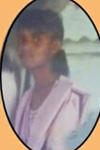
!
![]()
ብመጀመርታ ነቲ ኣብ ገጻት face book ነቶም ስለ ሃገር በረኻ ሰፊሮም ዕድመኦም ሙሉእ ሓዳርን ናብራን ጥጡሕ ናብራ ከይተመነዩ ዝተቃለሱ ጀጋኑ ስዋኣት ኣብ ሶፋ ኮንኩም ጥዑም እናበላዕኩም ከተቃሽሽዎም ትውዕሉ ዘለኹም ቁሩብ ሕልና ግበሩ ዓገብ።
ቀጺለ ሓጺር ውዕሎ ናይታ ካብ ቅድሚ ዓይነይ ዘይትስወር ስውእቲ ጅግና ጓል ኣንስተይቲ ከቅርበልኩም እየ።
#ሙሉእ ስማ ሑርያ ዘይኑ ትባሃል ተወሊዳ ዝዓበይቱሉ ኣኽርያ ኮይኑ ኣባል 5ይ ዙርያ እያ።ኣባላት 5ይ ዙርያ ታዕሊም ምስ ወዳእና ኣብ ናቅፋ ኢና ኔርና ብድሕርዚ ናብ ቃሩራ መጺና ካቡኡ ተኽሊጥ ምስ ተገብረ ናብ ግላስ ዓሸራ ዝባሃል ቦታ ባርካ ንምኻድ ካብ ኩሉ ኣንፈት ዝተኣኻኸበ ሰራዊት ናብ መካይን ማርቸድስ ዝዓየነትን ተሰቅለ፡ምስ ሑሩያ ሌላና በዚ ጀሚሩ ኣብ ጥቃይ ኮፍ ኢላ ብምንባራ ክንላለን ጽቡቅ ጌርና ክንፋለጥን፡ዕድል ጌርና ገዛውታ ኣኽርያ ጥቃ እንዳ (ዓሊ በኺት )ሙኻኑ ምስ ነገረትኒ ድሕሪ ነዊሕ ጉዕዞ ኣጋጣሚ ኣብ ከረን ከም ነዕርፍ ተጌሩ።ሑሩያ ዘይኑ ብጠባያን ሰሓቅ ጸወታኣን፡ብዘይ ኣፋላልይ ሓቓፊት ኩሉና እያ ኔራ ።ኣብቲ ዝነበርናዮ፡ቦታትት ዓጌፋ ኮይኑ ብመስርዕ፡ጋንታ፡ዝግበር ዝነበረ ምዝንጋዕ ቀንዲ ተሳታፊት እያ ኔራ።ካብቲ ዘይርስዖ ድማ ኣብ ናይ እስቃጥላ ጌራ ቡን ሻሂ እናገበረት ንኩሉና ከም ንዘናጋዕን ነዕልልን ትገብር ዝነበረት ጅግና እያ።ብኩሎም ኣባላት ኣዝያ ፍትውቲ እያ ነራ።ብድሕሪዚ ናብ ካዕላይ ዝብሃል ቦታ ኣምራሕና ኣብ ካዕላይ 8 ወርሒ፡ድሕሪ ምግባር.።ኣይጸናሕናን ኩነታት ኣርኪቡ ኩሉና ናብ ደጀን ናቅፋ ተመሊስና ኣቡኡ እቶም፡ብሓንሳብ ነዊሕ፡ዝገበርና ፋሕፋሕ ኢልና፡ሑሩያ ሕጂ እውን ምሳይ ኣነ ግደለ ንሳ ሓረን ከባቢ ደቀምሓረ ተመዲባ ኣብቲ ቦታ ንዊሕ ኣይጸናሕናን ናብ ጾሮና ተቀየርና፡ኣሃዱና ኣብ ሩባ ጾሮና ዓሪዳ ነበረት ብድሕርዚ ፍቃድ ተዋህቡኒ ሕሩያ ዘይኑ ናብ ገዛ እናተበገስኩ ከለኹ ሓደራኻ ከም ወትሩ ንገዛና ኣላጊስካ ሰላም በለለይ ኢላ ኣፋነወትኒ።ቅድሚኡ ኣብ ዝተፈላለየ እዋናት ንገዛ ብሓንሳብ ንመላለስ ብምንባርና ሽዑኡ ግን ንበይነይ ንክከይድ ቻው ተባሃሂልና ተፋላሊና።ኣሰመራ ተመሊሰ ዕረፍተይ ከይዛዘምኩ።ኩነታት 2ይ ወራር ምጅማሩን፡ኣዝዩ ብምጽንካሩን ካምታ ለበዋይ ንገዝኣ ብምካድ ስድራቤታ ንዝሃቡኒ ደብዳቤ ሒዘላ ናብ ኣሃዶይ ተመለስኩ።ካብኡ ብቀጥታ ናብ ገምሃሎ ዝብሃል መረብ ሰቲት ብመኻይን ተሰሪዕና ከድና።
ወጋሕታ ዕለት 26/02/1999
ሰዓት 5፥40 Am ልክዕ ኩናት ተጀሚሩ እቲ ዝነበርናዮ ቦታ ኡኩል ድፋዕ ስለዘይነበሮን ቓልዕ ብምንባሩ ጸላኢ ብብዝሒ ሰብን ዓይነትን ኣጽዋር ኣዝዩ ብተዓጻጻፊ ካባና ይበዝሕ ስለ ዝነበረ ጉድኣት ኣሲዒቡልና፡ዝግበር ስለዘየለ ግን ብዘለኻዮ ሓቦ ጌርካ ምርግራግ ኮይኑ።ኣብ ከምዚ ርሱን ኣጋጣሚ እዩ እንባኣር ሳምራዊት ትብሃል ጓል ጋንታኣ ብዓውታ (ሑሩያ በዚ ወዲቃ) ኣላ በለትና ናብ ሓንቲ ቦታ እናኣመልከተት ዝግበር ስለ ዝየለ ጸላኢ ድማ ኩሉ ዓይነት ኣጽዋር ከም ዝናብ ልዕሊ ንቡር ጻዕቂ ደብዳብን ቶኽስን ስለዝገበረልና ቀልጢፉ ዝኸዳ ኣይነበረን ንሑሩያ።ብድሕርዚ ንደቂ ጋንታኣ ረኺበ ሑሩያ'ኸ ኢለ ምስ ሓተትኩዎም ንሕክምና ከይዳ ኣላ በሉኑ ኣነ ድማ ተረጋጊአ።ይኩን ደኣ እምበር ንሕና ተኣኪብና ኮር 271 1ይ ክ/ሰ እዛዚ ሰውእ ብርጋደር ጀነራል ዓብዱ ረመጭ እዩ ዝነበረ።እዚ ኣሃዱና ኩሉ ከም ዝፈልጦ ተወርዋሪ ብምንባሩ ኣብ ዘዝትወለዐ ኩናት እዩ ዝኣቱ ዝነበረ።እዚ ኩሉ ተዛዚሙ ኩናት ኣብ ዘዕረፈሉ እዩ እምበኣር ኣሃዱና ኣብ ገማግም ሩባ እናዕለልና ከለና፡ገለ ደቂ፡ጋንታ ንሑሩያ ረኺበ ደሃያ ዝሓተትኩ።ገለ ካብኦም
Tedros Michiel
ዝርከቦም ኩሎም፡ብሕዙን መንፈስ ናባይ እና ጠመቱ ሑርያ ብዕለት 26/2/1999 ሽዑ ኣብቲ ገምሃሎ ዝበሃል ቦታ ብጅግንነት ስለዛ ሓላል መርየት በጃ ሓሊፋ ተሰዊኣ በሉኒ።ንብዓተይ ክውሕዝ ይዝከረኒ ግን መስዋእትን መውጋኣትን ብጾትና ለሚድናዮ ስለዝኮና ዝገብሮ ኣየነበረን።ሑራይ ጋል 17 ዓመት ኣዝያ፡ንእሽቶን ከም ዝነበረት ኩሉ ዝፈልጣ ብኣ ይግረም ምንባሩን ታሪኻን ታሪኽ ከማኣ ዝመስላ ጀጋኑ ብጽሑፍን ካልእን ቀሪቡ ስለዘይፈልጥ እየ ንመዘኻኸሪ፡ኣዚኣ የቅርባ ኣለኩ።
ከምኡ እውን ኩሉን ኣሃዱ ኣባላት ኮር 271 1ይ ክ/ስ ከም ንዝክሮ እታ ካብ ሓፍታ ሒዘላ ዝመጻኩ ደብዳቤ ናይ ሑርያ ዘይኑ ኣብ ኢድ ወያነ ኣትያስ,ሙሉእ ትሕዝቶ ናይታ ናፍቆት ስድራቤታን ካልእን ዝሓዘ ደብዳቤ ኣብ ሬድዮ ወያነ እውን ተነቢባ ምንባራ ኩሉና ንዝክር።
ሓውኩም Nuredin Elaj Nuredin Elaj
ጅግና ስውእቲ ሓርበኛ ሹዋ እስቲፋኖስ
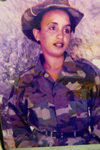
ክብርን ሞጎስን ን ጅግና ስውእቲ ሓርበኛ ሹዋ እስቲፋኖስ ጋል ማይ ሞስኖ ቤት ሓላል ጻዕዳ ሓያል ስነጥበባዊት ሃገርና 5ይ ዙርያ
1 ( እቲ ሰክራም ሓሊፍሉ )
2(ርግጸኛ ኣይኮንኩን)
ኣብ ዝብላ ፍልምታስ ዝሰርሓት ዋዕሮ ሓብተይ
ሎሚ ጽባሕ ክሉሳእ ወትሩ ኣብ ልብና !!
ስውእቲ ተጋዳሊት ኤልሳ ዮሴፍ (ገዙ)
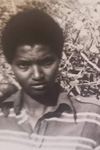
ስውእቲ ተጋዳሊት ኤልሳ ዮሴፍ (ገዙ) - ትእምርተ ጽንዓትን ተወፋይነትን ኤርትራዊት ጓል-ኣንስተይቲ (እዚ ጽሑፍ'ዚ ብተጋዳላይ መኮነን ኪዳነ (ሻባይ)
ዝተጻሕፈ ኣደናቒ ጽንዓትን ተወፋይነትን ኤርትራውያን ተጋደልቲ ደቂ-ኣንስትዮ የዘንቱ።)
ነዛ ብዛዕባ ብጸይቲ ኤልሳ ዝጸሓፍኩዋ ንእሽቶ ተዘክሮ ዘንበቡ ክልተ ብጾት ደዊሎም ቁሩብ እንዶ ኣስፍሓልና ኢሎምኒ። ኣብ መጽሓፍ እንተዘይኮይኑ ኣብ ማሕበራዊ መራኸቢ ብሰፊሕ ክትጽሕፍ ጥራይ ዘይኮነ ንምንባቡ'ውን ምቹእ ከይከውን ይኽእል እዩ። ብዝኾነ ንተነባብነት እንተዘይጸጊማ ቁሩብ ኣስፍሕ ከብላ።
ብቐዳምነት፡ ብጸይቲ ኣስቴር ተስፋጋብር፡ ንስእሊ ጅግና ስውእቲ ኤልሳ ዮሴፍ (ገዙ)ን ብጻይ ፍስሃየ ወዲ ፖሊስን ዓቂብኪ ምዝርጋሕኪ ዘሐጉስ እዩ። ደጊመ ንዝኽርታተይ ስለ ዝቐስቀስኪ ብስም ኩሎም ህልዋትን ሕሉፋትን ብጾትና አመስግነኪ።
ስውእቲ ብጸይቲ ኤልሳ ዮሴፍ (ገዙ)፡ ፈለማ ኣባል ብርጌድ 23፡ ኣብዚ ታሪኹ ንዝክሮ ዘለና እዋን ድማ ኣባል ክፍለ ሰራዊት 70 ቦጦሎኒ 46፡ ካልኣይቲ ሓይሊ፡ ካልኣይቲ ጋንታ ኣጋር ከቢድ ብረት'ያ ነይራ።
ነቶም ንኣሽቱ ደቅና፡ ኣጋር ከቢድ ብረት ዝበሃል፡ ካብ ረሻሻት ዶሽካ፡ ብራውን፡ 14.5 ረሻሽ፡ ካብ መዳፍዕ 57 ሚ.ሜ.፡ ቢቴን 75 ሚ.ሜ.፡ ቢቴን 82 ሚ.ሜ.፡ ካብ ሃውናት ድማ፡ ሞርታር 60 ሚ.ሜ.፡ ሞርታር 81 ሚ.ሜ.፡ ሞርታር 82 ሚ.ሜ.፡ሞርታር 120 ሚ.ሜ.፡ ነጥብ ኣራት ዝኣመሰሉ ብመንኩብ ሰብ ተጸይሮም ዝንቀሳቐሱ ከበድቲ ብረታት ዓጢቑ ዝዋጋእ ኮይኑ፡ ኣብ ልዕሊኡ ድማ፡ ከም ኩሉ ኣጋር ተዋጋኢ ሓይልታት ካላሽን፡ ብሬን፡ ኣርፒጂ፡ ቦምባ ዓጢቑ ዝዋጋእ ኣሃዱ እዩ፡፡
ስውእቲ ብጸይቲ ኤልሳ ዮሴፍ፡ ሓንቲ ካብቶም ብሉጻት መድፍዓጂታት ሞርታር ናይ ኣሃዱና እያ ነይራ። ብጀካ እቲ ጓለንስተይቲ መድፍዓጂ ሃውን ምንባራ፡ ብሰንኪ ተኹሲ ከበሮ እዝና ተቐዲዱ፡ ብሓገዝ ear phone ትንቀሳቐስ ምንባራ ፍልይ ካብ ዘብላ ረቛሒ እዩ። ምስ ኩሉ ጸገማ ካብ ድፋዕ ከይወረደት ተጋዲላ። ከምኡ ኢላ ከላ እያ ድማ ሃውና ትሽምሽሞን ብካላሽንን ቦምባ ኢድን ትደራገምን ዝነበረት ጅግና እያ።
ነዛ ስእሊ ምስ ረኣኹዋ፡ ንሓንቲ ካብ ሕድሮታትና ምስ ብጸይቲ ኤልሳ ዮሴፍ (ገዙ) ኣዘኻኪራትኒ። ኣብ ወራር ባሕረ ነጋሽ፡ ጥቅምቲ 1985 እዩ።
ልክዕ ንምዃን ዕለት 10 ጥቅምቲ 1985፡ ደብዓት - ፓሪስ ጠልጠል፡፡ ስርዓት 8፡30። ክልተ ኣንተኖቭ ዝዓይነተን ነፈርቲ ብልዕሌና ናብ ሰሜናዊ ምብራቕ ሳሕል ገጸን ሓሊፈን። ሰራዊት ኣውሪደን ቀዲመናና ድፋዓትና ክሕዝኦ ይጓየያ ምህላወን ፍሉጥ'ዩ ነይሩ። እንተቐዲመናና፡ ንምውጽአን ዝኽፈል ዋጋ ከቢድ ምዃኑ ኣጸቢቑ ስለ ዝርዳኣና ቀልጢፍና ክንከይድ ተሃንጠና።
ጀነራላት ደርግ፡ እቲ ኣብ ውግእ ባረንቱ ንተጋደልቲ ህ.ግ. ንምድምሳስ ዝወጠኑዎ ወፍሪ፡ ውድብ ህ.ግ. ብምዝላቕ ምስ ኣፍሸሎ፡ ብባሕረ ነጋሽ ዝፍለጥ ወራር እዮም ኣበጊሶም። ሓደ ካብቲ ሓደገኛ መደቦም ድማ፡ በቲ ቅድሚ ዓመትን መንፈቕን ንውቃው ዝተባህለ ደርማስ እ'ዞም ኣብ ጎላጉል ማህሚመት፡ ኣውገትን ክራይን ጥሒንና፡ ዝቕተል ቀቲልና ዝማረኽ ብምምራኽ፡ ብዘይካ ውሑዳት ፋሕ ፋሕ ኢሎም ንማርሳ ጉልቡብ ገጾም ዝሃደሙ፡ ደምሲስና ናብ ባሕሪ ዘጥሓልናሉ፡ ሰብ ዘይነበሮ ግንባር ሰሜናዊ ምብራቕ ሳሕል ተመኹልዮም ንምግራህና እዩ።
እዚ ሓደገኛ ውጥን'ዚ እንተሰሊጡዎም ብቐሊሉ ንደጀንና ክቈጻጸሩ ጸገም የብሎምን። ብመሬት፡ ብባሕርን ብነፈርትን ድማ ዘይተኣደነ መዳፍዕ፡ ታንክታትን ረሻሻትን ዝዓጠቐ ሰራዊት ናብ ግንባር ሰሜናዊ ምብራቕ ሳሕል ኣውሓዙ።
ሓደ ካብቶም ነቲ ወራር ዓጊትካ ንምፍሻሉ ዝተጓየዩ ኣሃዱታት፡ ብብርጌዳት 23 ን 44 ዝቖመ ክፍለሰራዊትና 70 እዩ ዝነበረ። እቲ ግንባር፡ ንነዊሕ ዓመታት ዝዓረድናሉ ግንባርና ብምንባሩ ዳርጋ ኩሉ ተጋዳላይ ናይቲ ክፍለ ሰራዊት ነቲ ቦታ ከም ኣጻብዕቲ ኢዱ እዩ ዝፈልጦ፡፡ ኣብ ኩናት ቀዲሙ ቦታ ዝሓዘ ስለ ዘድምዕ ዝሓዝካ ሒዝካ ኣርክብ ኮይኑ።
ኣብቲ ሳልስቲ፡ ብጸይቲ ኤልሳ ምጉሊ ኣንጭዋ ኣብ ረቃቒቶኣ ወጺኣታ ብቓንዛ ክትልሎ'ያ ቀንያ፡፡ ፈውሲ ረኽሲ መድሃኒት ብመርፍእ ጀሚረላ ነይረ። ነታ ቁስሊ ድማ መዓልታዊ ይሕክማ። እንተኾነ ግን ኣብ ጥቓኣ ካልኣይቲ ሕበጥ ገይራ ገዲዳታ፡፡ ረኽሲ ኣይተመሓየሸን፡፡ ክትሓዊ እንተወሓደ ሓደ ሰሙን የድልያ ነይሩ። ናብ ሕክምና ቦጦሎኒ ክትከይድ እናሓሰብኩ'ዩ ጉያ ንኩናት ኮይኑ፡፡ እታ ዝተበገስናላ ንጉሆ ክሕክማ ከለኹ፡ ኣብ ጉዕዞ ስለ ዝሓደርና፡ ክልቲኡ ሰለፋታ እናተፋሓፍሐ ተጎዲኣ በሻዕሻዕ ኢላ ጸኒሓትኒ። ብቓንዛ ምቕራብ ከሊኣትኒ። ክትጽመም ነይሩዋ። ሓኪመ ምስ ጀነንኩላ ፈውሲ ረኽሲን ፈውሲ ቃንዛን መራፍእ ወጊአያ። ወዲአ ኣቕሑተይ እናጠራነፍኩ "ሻባይ ሞጎስ ደኣ ዘይትሕግዘኒ" ኢላትኒ። ንሞዴስ ዘውጻእናሉ ሳጓ እዩ። ነዋልድና ባህርያዊ ጸገመን ስለ ዝርዳኣና ካብ ዘለዋና ባንደጅ ንሕግዘን ኢና። ክልተ ዕኹላላት ባንደጅ ሂበያ፡፡ በቲ ዓዳይ ክውል ኢላ ከም ዝጥዕማ ገይራ ተመሊሳ። ዕጥቃ ዓጢቓ ነብሳ ንኩናት ድልውቲ ገበረታ፡፡ ሽዑ ንሽዑ ድርብ ጸገም ከም ዘለዋን ኣብ ጉዕዞ ክጽግማ ምዃኑን ንብጻይ ዓብለል ረዘነ (ስዉእ) መራሒ ጋንታና ሓቢረዮ። ስለ ሓበሬታ'ምበር ግንባር ምሉእ ንቕይር ስለ ዝነበርና ምርጫ ኣይነበረናን። ኣብቲ ንኸዶ ቦታ ከም ኩነታቱ ክንሕግዛ ተረዳዲእና። ኣብ ምጥርናፍ ንብረትናን ምምስሳልናን ኣቲና።
ኣነን ኤልሳ (ገዙ)ን ዝነበርናያ ካልኣይቲ ሓይሊ ብቐትሪ ኢና ካብ ደብዓት ተበጊስና። ነታ ክትወስደና ዝመጸት ማጅሩስ ዝዓይነታ መኪና፡ ዓበይቲ ዓዳያት ብምቑራጽ ኩሉ ነብሳ ሽፊንና ኣመሳሰልናያ። ኣብ ዝባና ክንድይብ ከለና'ውን ነፍሲ ወከፍና ቁራጽ ዓዳይ ሒዝና ብምድያብ ኣብ ልዕሊ ኣራእስና ሰቒልና ካብ ርእየት ነፈርቲ ውግእ ደርግ ተመሳሰልና። ንሕና ይኹን እታ መኪና ዓቢ ገረብ ኢና መሲልና።
እቲ ዓዳይ ካብ ርእየት ነፈርቲ ጥራይ ዘይኮነ ካብታ ኣቃጻሊት ጸሓይ ሰሜናዊ ምብራቕ ሳሕል'ውን ጽላል ኮነና። እንተኾነ ግን እተን ብጽርግያታት ሰሜናዊ ምብራቕ ሳሕል ንዝንቀሳቐስ ተጋዳላይ ንምድምሳስ ትሒተን በብድርብ ዝውንጨፋ ዝነበራ ሚጋትሲ ኣይመሓራናን፡፡ ኣብ ጽርግያ ደሮና እናገደፈ ዝንቀሳቐስ ገረብ ዘይኮነስ ተጋደልቲ ዝጸዓነት መኪና ምንባራ ፈሊጠን ፋክረሳት ኣዝነባልና። ዝዘርየልና ጸረ ነፈርቲ ረሻሽ ኣይነበረን። ሓንሳብ ብቕጽበት ወሪድና ፋሕ ብምባል፡ ሓንሳብ ብጽዑናትና ካብ ጽርግያ ብምእላይ ሽክዕ ተተሓሓዝናዮ፡፡ ደው ምባል ግን የለን። ነፈርቲ ቦምባ ክጽዕና ወይ ናብ ካልእ ቦታ ክድብድባ ግልል ክብላ ከለዋ ምቕጻል'ዩ። ናይ ሞትን ሕየትን ጉዕዞ! ብዕድል ድማ ዝሃረማልና ሰብ ይኹን ንብረት ኣይነበረን። መሬት ብብርሃኑ ኣብቶም ጽኑዓት ድፋዓትና በጺሕና።
ኣብቲ ኣባላት ክፍሊ ታዕሊምን ኣብቲ ከባቢ ዝነበሩ ካልኦት ክፍልታትን ተኣኻኺቦም ብገለ ሸነኹ ዘጻንሑዎ ግንባር ሰሜናዊ ምብራቕ ሳሕል፡ ቅድሜና ዝበጽሓ ገለ ቦጦሎኒታት ናይ ክፍለ ሰራዊትና ምስቲ ህንዱድ ሰራዊት እናተቐዳደማ ካብን ናብን ድፋዓት እናተወናጨፋ ክቋሻመዳ'የን ጸኒሐናና። ንሓያለይ ክፋል ካብ ዕርድታትና ድማ ከየድፈርኦ ጸኒሐን፡፡
ብዛዕባ'ቲ ውግእ ብሰፊሑ ኣብዚ ክለዓል ኣጸጋሚ እዩ። ዕድመን ጥዕናን ይሃበና፡ ንምጽሓፉ ዝጀማመርናዮ ስራሕ ኣሎ። ንመፈጸምታኡ የብቃዓና፡፡ እዛ ስእሊ ስውእቲ ብጸይቲ ኤልሳ ዮሴፍ (ገዙ) ዝቐስቀሰቶ ተዘክሮይ ብጥማዕ'የ ከካፍለኩም ሓሲበ።
ኣብቲ መግሃር ኩናት፡ ሓይልና ካብ ደብረ እበን ክሳብ ሽግለት ዘሎ ድፋዓት ኢና ዓሪድና። ከየዕረፍና ድማ፡ ብዘይካ መድፋዓጂታት ዶሽካን ሞርታራትን ኩላ ከም ኣጋር ሓይልታት፡ ኣብ ምብርዓን ህጁማት ጸላኢን ህልኽ መልሰ-መጥቃዕትን ተጸመድና። ኣብ ሓድሕድካ ክትረዳዳኣሉ ዘየገላብጥ ሓዊ ኩናት!
ኣብቲ ኩናት ገዙ ምንቅስቓስ ጸጊሙዋ ብቓንዛ ተለለወት። እናተቐንዘወት ክትዋጋእ ሓዲራ። ካብ ቃንዛ ንላዕሊ ግን እቲ ቁስሊ ምስቲ ሓደ ሰለፋ እናተላገበ ምንቅስቓስ ከልኣ። ኩናት ዝግ ክብል ከሎ ክሹኽ ክትዕጠቕ ጀሚራ። ክውል ኢላ ትቑንዞ። ፈውሲ ቃንዛ ወጊአያ ኣይጠቐማን። ኣብቲ ጁባታት ናይ ድፋዕና የዕርፊ ኢለያ ኣብያ። ንጋንታና ጸገማ ከይነግረላ ተማሕጺናትኒ።
ኣብ ካልኣይ መዓልቲ ናይቲ ውግእ ክልተ ሞርታር ስለ ዝመጻና ኣነን ገዙን ሓሓዴና ክንሕዘን ተመዲብና። ብዕድል ምሳይ ምምዳባ ተሓጉሳ፡፡ ኣብ ከምዚ ናይ ድርብራብ ጸገማታ እዋን ሓኪም ጥቓኣ ክህሉ ቀሊል ስለ ዘይነበረ። እንተኾነ ግን ቃንዛ መሊሱ ገደዳ። ከመይ ኣለኺ እንተበልኩዋ እቲ ረኽሲ ናብ ብልዕታ ገጹ ይልሕም ከም ዝነበረን እምብዛ ከም ዝበርትዓን ነጊራትኒ። ካልእ ይትረፍ ጽርየታ ትሕልወሉ ማይ'ውን ኣይነበረናን። ብራሾኣ ወዲኣታ ስለ ዝነበረት ብራሾይ ካብ ዕጥቀይ ኣውጺአ ክትሕጸበላ ሂበያ።
ከም ሓኪም ናይቲ ኣሃዱ ክውስን ነይሩኒ። ምስ መራሕቲ ጋንታታትና ስዉእ ዓብለል ረዘነን ብጻይ ዘርእዝጊ ዳዊት (ገናውኖ)ን ናብ ርእሲ'ቲ ከረው ኣቢሉ ሒዙዋ ዘሎ ቁስላ፡ ወርሓዊ ጽግያት'ውን ተደሪቡ ቃንዛ፡ ድኻምን ርኡይ ናይ ምንቅስቓስ ጸገምን ስለ ዘለዋ፡ ናብ ሕክምና ቦጦሎኒ ክትከይድ ከም ዘለዋ ተረዳዲእና። እንተኾነ ግን፡ "ጋንታይ ኣብ መግሃር ውግእ ተጸሚዳ ከላ ኣነ ሓሚመ ኢለ ካብ ድፋዕ ክወርድ ሕልሚ እዩ" ኢላ ኣቕቢጻትና። ንዓይሞ "ሕጂ ናብ ሕክምና ትብል ቃል ከይትደግመለይ" ኢላ ኮርያትለይ። ኣወሃሃዲ ናይተን ምሳኣ ሒዝናየን ዝነበርና ክልተ ሞርታራት ወዲ ሃይለ (ስዉእ) ምስ ነገርኩዎ'ውን ናብ ሕክምና ቦጦሎኒ ክትብገስ ነጊሩዋ። "ዋላ ሓንቲ ጸገም የብለይን" ኢላ ኣብያቶ፡ ደሓር ንዓይ ንምንታይ ትነግረለይ ኢላ ተቛይቛትኒ። ክሹኽ ተዓጢቓ ኣብ መንጎ እናተቐንዘወት ተኹሳ ቀጺላቶ።
ናብ ዕለት 15 ዘውግሐት ለይቲ፡ ጸላኢ ብምሉኡ ግንባር ሰሜናዊ ምብራቕ ሳሕል ብሓፈሻ፡ ብሩባ ኣልጌንን ደብረ እበንን ድማ ብፍላይ ፈንጢሱና ክሓልፍ ዝተሃንደደላ መራር ናይ ኢድ ብኢድ ውግእ ለይቲ'ያ ነይራ።
ተጸጊዐናና ዝነበራ ወተሃደራት እምብዛ ብዙሓት ብምንባረን እታ ለይቲ ጽልልቲ ምዃና ፍሉጥ'ዩ ነይሩ። ሓንቲ ወዲ ኣቤል ዝተባህለ ብጻይ ዝመርሓ ኣርቢጂ ዝዓጠቐት መስርዕ ድማ ንሓገዝ ተደሪባትና። ድሕሪ ፍርቂ ለይቲ ጽዑቕ ህጁማት ጀሚረናና። ተሓናነቕ ኮይኑ።
ኣብታ ለይቲ፡ ናይተን ኣነን ገዙን ሓሓዴና ሒዝናየን ዝነበርና ሞርታራት ቦምባታት ኩሉ ቀልጢፍና ስለ ዝወዳእናዮ፡ ብቐንዱ'ውን ሕውስውስ ምስ ኮነ፡ ምስ ኣወሃሃዲና ወዲ ሃይለን ቦምባ ዘዳልወልና ዝነበረ መርሃዊን ብጉያ ናብታ ብትሕዞ ትጠማጠም ዝነበረት ጋንታና ተሓዊስና ብቦምባታት ኢድን ጠያይቲን ተረጋረግና። ናይ ለይቲ ኩናት ዝፈተኖ ጥራሕ'ዩ ዝፈልጦ። በቲ ግብ ዝበለ ጸልማት ብጻይካን ጸላኢኻን ምፍላይ እምብዛ ከቢድ'ዩ። ነንሓድሕድካ ምትህርራም ካብቲ ዝኸፍአ ሸነኹ እዩ። ዓይንኻ ብነዊሕ ዘይትርእየሉ፡ ብኣንፈት ተኹሲ ጥራሕ መኣዝንካ ትፈልጠሉ ግናይ እዩ። ምሉእ ለይቲ ተሓናነቕ ኮይኑ፡፡ ኣብ ወጋሕታ ነተን ገለ ክፋል ድፋዓትና ተቘጻጺረን ዝነበራ ወተሃደራት ደርግ ኣውጺእና ንቑልቁል ኣጽዲፍናየን። ገለ ካብኣተን ግን ኣብቲ ካናለታትና ተሪፈን ብኹሊትና እናሃረማ ብተኹሲ ምቕራብ ከልኣና። ካብቲ ናይ ቅድሚት ጽዑቕ ተኹሲ እቲ ናይ ጎኒ ውሑድ ተኹሲ ከፊኡና። ነንሓድሕድና ክንተሓጋገዝ፡ ውጉኣትና ክንውግን ጸጊሙና።
ኣይደንጎየን፡ መራሒ ጋንታና ብጻይ ዘርእዝጊ ዳዊት (ገናውኖ) ቀልጢፍና ካብ ካናለታትና ከነውጽአን ህጹጽ ትእዛዝ ኣመሓላለፈ። ኤልሳ ዘላቶም ጉጅለ ከኣ ንህጁም ተዳለው። ብዘለና ብረታት ጉልባብ እናገበርናሎም ብጉያ ዘዘሊሎም ኣብቲ ካናለታት ተደቕደቑ። ብቦምባታት ኢድን ጠያይቲን ድማ ብትሕዞ ተሳሃሉወን። እተን ምንቅስቓስ ከሊአናና ዝሓደራ ወተሃደራት ዝቕተል ተቐቲሉ ዝሃድም ንገደሉ ጸደፈ። ተኸስተ ላምፐንን ኤልሳ (ገዙ)ን ድማ ኣብታ ህጁም ክልቲኦም ኣብ ከብዶም ተወጊኦም ወደቑ። ጎቲትና ናብ ከውሊ ኣጸጊዕናዮም፡፡
ተቐልቂሉ ዝነበረ መዓናጡኦም ብዝነበረኒ ፋሻታት ጀኒነ ቀዳማይ ረዲኤት ገበርኩሎም። እምብዛ ጸልማት ስለ ዝነበረ መውጋእቶም ባዕላቶም ብዝሕብሩኻን ብኢድካ ዳህሲስካን እምበር፡ ብዓይንኻ ምርኣዩ ኣጸጋሚ እዩ፡፡ "ገዙ ካልእ ኣለኪ ድዩ ማህረምቲ?" ምስ በልኩዋ "እንድዒ ክሳብ እግረይ እንድዩ'ሞ ደም ጨቅዩ ክፈልዮ ኣይከኣልኩን" ኢላትኒ። ብኢደይ ክድህስሳ ከለኹ ናይ ሰለፋ ቀናዪ ቁስሊ ጎዲአያ "ሃይ!" ኢላ ተቐንዝያ። "ደሓን እቲ ናይ እግርኺ ደም ብጻይ ሞጎስ ሓለዋ ኣቋሪጹ ስለ ዘሎ እዩ" ኢለያ። "ኣርኪብካ ከኣ ንስኻ!" ኢላትኒ እናተቐንዘወት። ነቶም ውጉኣት ኣብቲ ናይ ድሕሪት ጁባታት የእቲና ውግእና ቀጸልና። መሬት ብርህ ክብል ከሎ ድማ፡ ንጸላኢ ጠቕሊልና ጸራረግና ንድፋዓትና ምሉእ ብምሉእ ተቘጻጸርናዮ።
ኣብታ ለይቲ ካብ ጋንታና፡ ወዲ ታፍላ፡ ወዲ ወዲ ሃይለን ናይታ ክትሕግዘና ዝመጸት መስርዕ መራሒ ወዲ ኣቤል ዝርከቦም ክልተ ብጾትን ብጠቕላላ ሓሙሽተ ብሉጻት ብጾት ከፊልና። ገዙ፡ ተኸስተ ላምፐን፡ ሃብታይ፡ ወዲ ኮማንድስ፡ ወዲ ሰጊድን ኣነን ድማ ተወጊእና፡ ወዲ መለስ ብተኹሲ እዝኑ ጸሚሙ።
መሬት ምስ በርሀ ስውኣትና ተቐቢሮም፡ እቶም ውጉኣት ከኣ ናብ ሕክምናታት ዓምበርበብን ዓራርብን ኬድና። ምስቶም ብድሮ ተወጊኦም ዝጐደሉና ፍረወይኒን ዓብለልን ጋንታና ዳርጋ ተፋሪቓ እያ፡፡ ኣብ ክልቲኡ ገጻት ናይቲ ወራር ንጸላኢ፡ ምስቲ ኩሉ ብዝሑን ኣጽዋሩን ረጊጹና ክሓልፍ ኣየፍቀድናሉን። ከም ሕሱም ኣርጊፍናዮ፡፡ ድፋዓትና ገጥ ኣቢልና ደጀንና ኣውሒስናዮ።
እዛ ስእሊ ንብጸይቲ ኤልሳ (ገዙ) ነቲ ኣብቲ ጽንኩር እዋን ዘጋጠማ መኻልፍ ናይ ጥዕና ጸገም፡ መሪር ቃንዛኣ፡ ተደራቢ ወርሓዊ ጽግያት ዝፈጠሮ ድኻማ፡ ጽንዓታን መውጋእታን ኮታ ድምር ብድሆታትያ ኣዘኻኺራትኒ፡፡ ኣውራ ከኣ ንኹሉ ጸይራ፡ ንሕክምና ኣይወርድን እየ ኢላ እናተቐንዘወት ክትዋግኦ ዝቐነየት።
ብዓቢኡ ድማ፡ ጽንዓት ጋንታናን ክጥሕረና ዝህንደድ ዝነበረ ሓይሊ ጸላኢን መኸተናን፡ ድፋዓትና፡ ስዉኣትና ኮታ ኩሉ ተራእዩኒ።
ብጸይቲ ኤልሳ ዮሴፍ፡ ኣብ ድሕሪ ናጽነት፡ ብሕማም ተሰዊኣ። ታሪኻ ግን ህያው እዩ።
ዘልኣለማዊ ዝኽሪ ንሰማእታትና!
መኮነን ኪዳነ (ሻባይ)
03 ሰነ 2019
ዝኽሪ ጅግና ሓርበኛ ስውእቲ ሓረጉ ገረዝጊሄር
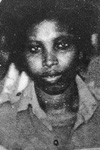
ዝኽሪ ጅግና ሓርበኛ ስውእቲ ሓረጉ ገረዝጊሄር
ሓርበኛ ስውእቲ ሓርጉ መራሓቲ ሓይሊ ኣብ ብ/69
ብ19/05/1981 ብጅግንነት ኣብ ኢዳምር ተስዊኣ ጅግና ሓረጉ ቆራጽ ናይ ውግእ መራሒትን ጅግንነት
ደቀ ኣንስቲዮ ዘመስክርተ ውፍይቲ በጽይቲ ኔራ
ጎቦ ዱታ ድፋኣት ጥሊያን ባርንቱ ይምሰከሩ
ዘለአለማዊ ዘክሪ ንስውአትና.
Hassi Mogos ጋል ገረዝግሄር ጎቦ ዱታ ጥራይ ኣይኮናን ዝምስክራ. ጎላጉል ዓረት. ታባታት ቆሓይቶ ጎቦታት እምባሶይራን ስመጃናን ውን ኣብ 75 ምስ ዕሳባት 68 ኮይና ውን ዘይሕለል ጅግንነት ዝገበረት ሓየት ተቓላሲት ከምዝነበረት ናይ ዓይኒ መሳኻኽር ኣሎና። ጋል ገረዝግሄር መንግስተ ሰማይ የዋርስኪ ሓወልትኺ ኣብ ድግሳ ክህነጽ እዩ
Alem Tsegai
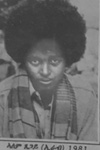
ኣለም ጸጋይ (ኢራብ) ምስሊ ትብዓት፡ ጅግንነት፡ ተወፋይነትን ጽንዓትን ናይተን ድርብ ቃልሲ ዘካየዳ ጀጋኑ ኤርትራውያን ደቂኣንስትዮ እያ!
“ኢራብ ኣቐዲማ ዕጥቃ ዓጢቓ ጫማኣ ክትወዲ ሃሰውሰው እንተበለት ጫማኣ ሽታ ማይ ኮና። ምስ ስኣነተን ከኣ ሓዚና። ጥራይ እግራ ምንቅስቓስ ከጸግማ ምዃኑ’ኳ እንተፈለጠት ብሕልና ግን ተቐቢላቶ’ያ። ንዂናት ብዘይጫማ ጥራይ ዘይኰነ ብዘይ እግሪ ብምርኩስ ክንኣቱ ኢና ኢሎም ወጠጥ ዝብሉ ተጋደልቲ ርእያ’ያ. . .። ኣብ ከባቢኣ ቁርጽራጽ ጫማ ኮዮ ወተሃደራት ደርግ ስለዝረኸበት ግን ነቲ ሶል (ናይ ታሕቲ ምንጻፍ) ቀዲዳ ካብ ሓኪም ጋንታኦም ጽጌረዳ ኢላስቲክ ባንደጅ ወሲዳ ነቲ ሶል ምስ እግራ ብምጅናን ንግዜኡ ከስርሓ ዝኽእል ጫማ ሰሪሓ ንዂናትነቐለት።...እቲኲናት ሓዊ ዝዀነ ኲናት’ዩ ነይሩ። ጸላኢ ነቲ ገዛኢ ታባታት ስለዝተቘጻጸሮ ኩሉ ምንቅስቓሳት ኣብ ትሕተኡ’ዩ። ኣጽዋር እልቢ የብሉን። ዳርጋ ነፍሲ ወከፍ ስጒምቲ ብመዳፍዕ ተፈሓሒሩ’ዩ። ኢራብ ከኣ ኣብዚ ረመጽ’ዚ እያ ትዘልል ነይራ። ጽጌረዳ ተስፋእዝጊ ነቲ ሃዋሁ ክትገልጾ እንከላ፡ “ምስ ኢራብ ካብ ነዊሕ ግዜ ኢና ንፋለጥ፡ ብፍላይ ኣብ 1983 ኣብ ሓደ ኣሃዱ ኢና ነይርና። ኩሉ ምንቅስቓስ ኣለም ምስ ኲናት ዝተኣሳሰረ ይመስለኒ። ተዂሲ ምስተጀመረ መትሓዚ የብላን። ኣብ ማእቶት’ውን ከምኡ’ያ። “ኲናት ላባ ከቢድ ነይሩ። ጠያይት ስለዝወዳእና ሰዓት ሓደ ናይ ለይቲ ዑቕባጋብርን ኣምፊብያንን ጥይት ከምጽኡ ምስ ተላእኩ ኣይተመልሱናን። ፈንጂ ረጊጾም ተሰዊኦም። ኣማራጺ ስለዘይነበረ መራሕ ጋንታና ወዲ የማኑ፡ ፍረወይኒ (ፋንቶም)፡ ሓሊቦ፡ ኣነን ኢራብን ንሓንቲ ቦታ ንሃጅማ። ካብ ብርጌድ 51 ኸኣ ገለ መሳርዕ ይድረባና። ሽዑ ሕውስውስ ይኸውን. . . ሓኪም ጋንታ ስለዝነበርኩ የማነጸጋም እንቀሳቐስ ነይረ። ሽዑ ኢራብ ተሃሪማ ኢሎም ጸዊዖምኒ። ብሸፋሽፍቲ ዓይና ዝኣተወት ጥራይ’ያ ኣውዲቓታ። ምስታ ጽብቕቲ ቁምጣኣ፡ ጋምባለኣ ምስታ ፈውሲ ክሻፋ ኢላ ኣብ ርእሳ ዘጥለቐታ ናይ ብላይ ጃኬት ቆብዓ፡ ምስተን ክንዲ ጫማ ዘገልገለኣ ሶልን ባንደጅን ጥንቅልዒት ወዲቓ ረኺበያ። ግን ኣየምለሰትን። ካላሽና ኣብ ሰለፋ ኣጋዲማ ዘልኣለማዊ ድቃስ ደቂሳ፡ ተሰዊኣ”
ምንጪ ጽጌሬዳ ተዝፋዝጊ ጋዜጣ ሓዳስ ኤርትራ 09/10/1996
Abeba Haile sang to honor Martry Alem Tsegai. Not only her fast & magic moves, her eyes says alot.
እንታይ ክደርፈላ፥ መን'የ ክብላ
ቅጽል ዘይተፈጥረ ንተግባራ
ክትዘልል'ዮ ርእዮማ ኢራብ ኢሎማ
ንኣለም ኣለመይ
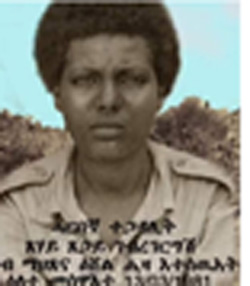
Zaid
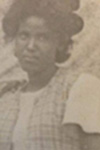
Hiwot Ogbamariam
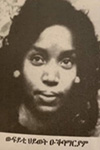
Hiwot Ogbamariam written in-depth detail by the one and only
Yohannes Ferdinando Drar
Happy Independence month-May 24 2020. During this month we have to remember our Martyrs- thousands of freedom fighters and civilians died in the 30 years of independence war. 35% of the liberation army were women. Hiwot Ogbamariam was a member of the EPLF secret underground network. In March 1984 she was assigned to bomb the electric station of Keren with her friend, unfortunately when she was on her way to the station the timebomb went off and she sacrificed her life for the nation. Her life history is now documented in a new book titled “Gedli Dekanistiyo”. She comes from a well respected family in Keren. Her brother, Dr. Andom (RIP) was a well known medical doctor in the EPLF, he died after independence. Hiwot is the cousin of the well known EPLF founder and leader Ermias Debasai Papayo who is currently incarcerated with his sister, Senait Debasai. Many families sacrificed their lives to attain the independence of Eritrea and hopefully soon Eritrea will be a stable, united and democratic nation under the rule of law. Eternal Glory to our Martyrs.
ስውእቲ ወይኒ አብራሀ
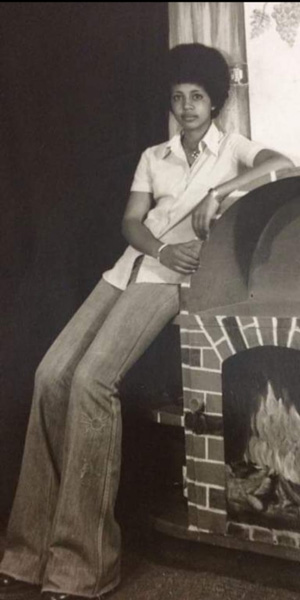
ስውእቲ ወይኒ አብራሀ*** ምሐዛይ መማህርተይ**
ወይኒ ሽኮር አብቲ ጥዑም ጊዝየ ንእስነትኪ
ኬድኪ ንበረካ ናይ ከተማ ስራሕኪ ምሰላሰልኪ
ጸላኢ ፈሊጡ ስርዕቲ ከምዝነበርኪ
እድል አይረከበን ክሞቅሕ ንዓኪ
ቻው ከይበልኪ ወጺኪ ንኩሎም ምሐዙትኪ
ዝፈልጥ አይነበረን ዋላ ሐደ ምስጢር ናትኪ
አብ ፎቶ ጅፈንቱስ ክንርእዬ ስእልኪ
አይንጸግቦን ኔርና ቁንጅና መልክዕኪ
ወይኒ ሐለፈት ክትብሀል ምስ መልክእዕ ቁመናአ
ማንካ ዘየልዓለትላ ነዛ ዓለም እዚአ
አብ ንዑስ ዕድሜአ ንበረካ ወጺአ
አይተመልሰትን ወይኒ ብክብሪ ተሰዊአ
ወይኒ ጽብቅቲ መማህርተይ ኩልና ክንሐልፍ ኢና ከነርክበኪ
ቅሰኒ እቲ ዝተለምኪዬ ዕላማ አተግቢርና ከነዘንትወልኪ.
ክብሪን ሞጎስን ንኩሎም በጃ ዝሐለፊ ስውአት. Solo Grande
Tsega Gaim
It was in 1970s early 1972, in 1973, 74, I was in high school, and there was opposition of students to the government on different issues... Ethiopian government...I was in Asmera in at that time it was called Prince Mekonnen High School, I have been there as a high school student... the Ethiopian regime during that time was arresting different students from our school and other schools, so there was a lot of opposition and I remember 1973 the whole year we didn'y go to school, schools were closed, and we lost one year, you know. Tsega had a long term plan to join the university, but because of all the disruption she decided to join the TTI instead:
I couldn't decide to join the teacher's training school because I wanted to continue to university, but the school was not running in a good way because of the situation of the Ethiopian regime, then I decided to join the TTI and I learned one year TTI, so when I joined the teachers training school(...) it was so strange for me, you know, because most of the students in that school were Ethiopians, they came from Ethiopia, for example in my class, we were 36 students, 31 of them were Ethiopians only 5 Eritreans, this was so strange for me, I didn't know such a situtation( ) in the whole school in the TTI out of around 500 students I think we were only 16 Eritreans, and we were insteaded to speak in Amharic, because all our classmates are Amhara, so we the 16 Eritreans were' we come together in the discussion about our country, we didn't know anything but the boys[out of the 16 Eritreans 12 were men and 4 women] were telling us oh the fighters are doing this doing that
After Tsega finished her one year course at the TTI she , toget with another women from her batch, was assigned to work in Afabet as a teacher. She was already very politicised when they arrived in Afabet and both women joined the field within two months:
It was so easy to join the struggle[from Afabet] because fighters were around and we had curiosity to see the fighters so both of us one day , the teachers, the health workers and other, they came together one day, and we were looking at their movement, we were the only two girls, others were boys, then we understood' they are wanting to go and join and we asked them and they said please, we will go but you have to wait here, we asked them why you are girls, and it is so difficult to go to the field, so please wait here, let us first go there, then we will see how the situation is, then we will tell you we will come back, but in Afabet during that time all the soldiers, so many soldiers, you know the commands, the Ethiopians, there were so many in Afabet during that time [so we told them] what do you you think, when you leave Afabet, we are going to be arrested, do you think we can live? they will ask us we have to give this information, and we also want to join the EPLF, to join the struggle we heard during that time there were women who joined the struggle, so we said women are with them, and we have to fight also, the same as them ....and we even went back to our house and just cut our hair and told them now we are ready to go.... then we decided to go with them..... there was one teacher from Amhara and he cried, he told us "I have to go with you" I can go to the Sudan if you don't want me" but we decided you are not an Eritrean, so we went and the soldiers arrested him ... after we went and walked for eight hours and for the first time, we were a little bit tired, and the boys went to the people and the people asked us oh these ladies, where are you going ? they are going with us to join the struggle[the boys replied] so wait we are bringing for them camels, please we are giving these two camels for these two ladies until the training centre and it was our first time with a camelMuller, Tanja R 2005 pp73-74]
Letebrehan Haile
1958-1980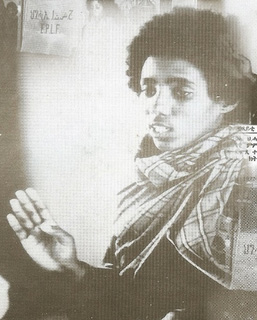
Letebrehan Haile-The Embodiment of the Eritrean Woman Freedom Fighter
Letebirhan was born in 1958 in Asmara, Eritrea in the Idaga Hamus neighborhood, to her father Mr. Haile Obgbalidet, and her mother Tsigheweini Mehari. She attended Itege Menen (now Adulis) Elementary School, grades 1-6, grades 7 & 8 at Geza Kenisha School, and 9th grade at John F. Kennedy School. She came from a middle income family and was an exceptional student, known for her creativity and astuteness. It was in 1974 that Letebirhan, very mature at her tender age, established contacts with members of the Eritrean Peoples’ Liberation Army operating in and around Asmara, the Eritrean capital.
When the situation in Asmara worsened in 1975, her family, like many families at the time, decided to leave Asmara and take refuge in the village of Ademizmat. While her older and younger siblings were taken out of Asmara, Letebirhan was left behind by her parents who feared her move to the village would encourage easier and further contacts with members of the Eritrean Peoples’ Liberation Army (EPLF). They feared that she would leave to join the liberation front. But leaving her in Asmara did not deter her burning nationalist desire and not long after her family’s departure from Asmara, in 1975 Letebirhan joined the (EPLA) and undertook her initial military training at Adi Gin.
Letebirhan at first served with the fighting forces of Battalion 8 and then at the end of 1975 when the Public Administration Department was established, she was pulled from the fighting forces and transferred to Zagher to serve under Alem Haile (Martyred fighter) to conduct awareness and education campaigns amongst the population at large. It is there that Tegadalay Habte met her. Up until the liberation of Keren in 1977, she continued to work and travel, diligently and selflessly, throughout the areas surrounding Karneshim (ካርነሽም) and Dimbezan (ዽምበዛን) organizing, raising the awareness, and arming the population.
Letebirhan understood the importance of organization, and worked tirelessly to accomplish organizational goals with great attention to detail and commitment, never complaining, always helping others addressing and correcting mistakes, shortcoming, as she went along. Ready, willing and wanting to learn from her comrades, while also sharing her knowledge with them, to enhance theirs, she was a consummate fighter-one much admired accepted and respected by her peers, and the population she worked with.
Considering her exemplary character and comradeship, in 1977 she was chosen/elected with the greatest number of votes, by her peers in the Department of Public Administration, to participate in the 1st Congress of the EPLF which took place in Nakfa on 23-31 January 1977 and formally set out the policies of the Eritrean People’s Liberation Front (EPLF). A program adopted at this first Congress specifically targeted a liberalization of women’s rights as well as a broad educational policy for maintaining every language and improving literacy. It was also set out that the boundaries of a liberated Eritrean state would be based on the colonial treaties of Italy. READ MORE
ዘኑባ ሃሽም ዓሊ ናህሪ፡
ብ ኣበድ ተስፋይ 141221
ዘኑባ ሃሽም ዓሊ ናህሪ፡ኣብ ምጽዋዕ ካብ ርኹባት ብንግዲ ዝነባበሩ ናይ ዓረብ መበቆል ዝነበሮም ስድራ-ቤት እያ ተወሊዳ።ወደብ ምጽዋዕ ናይ ዓረብ ህንዲ ግሪኽ ጣልያን ኩርድን ኢትዮጵያውያን መበቆል ዝነበሮም፡ብንግድን ብስራሕን ዝነባበሩ ተቐማጦን ካላኦትን ነበርዋ።ጓል ናህሪ ካብ ናይ ዓረብ መበቀል ዝነበራ ኤርትራዊት ስድራቤት ዝተወልደት እያ ዝነበረት።ኣብ ምጽዋዕ ክሳብ 8ይ ክፍሊ ተማሂራ፡ኣብ ኣጋ መወዳእታ 1976 ኣብ ህዝባዊ ሓይልታት ሓርነት ኤርትራ ተሰሊፋ።ኣብ ፋሕ ድሕሪ ምዕላም ኣብ ክፍሊ ቁጠባ ጨንፈር ኢደ-ስርሓት ኣብ ጽገና ብረት ተመደበት።ዕድሚኣ 17 ዓመት ኣቢሉ ኔሩ።እቲ እዋንቲ ነቶም ኣብኡ ንሰርሕ ዝነበርና ተጋደልቲ መሪር ኣዩ ነይሩ፣እንጀራ ወዲ ዓከር ኣብ ጮው ዝኣተዎ ማይ ፈትፊትካ ቅያር ዘይብላ ንዓመታት ሓሊፍናዮ።ኣይካብ ጽሩይ ማይ ኣይካብ መግቢ።እቲ ዘሐጉስ ኪኖ እዚ ሽግር ዝጥምት ክንዕወት ኢና ዝብል ዕላማ ምንባሩ እዩ።ካብ ሓይልታት ሬድዮያት ሰዓትን ብረትን ከዐርዩ ይምጹና ነበሩ።ካብቲ ማይ ጨው ምስ ሰተዩ ቀልቀሎም ካትራመ ክመስል ምስ ርኣዩ ሓሚምና ኢሎም ናብቲ ክሊኒክና ይኸዱ እሞ፡ሓኪም ናይጮው ኣዩ፡ንሓድሽ ሰብ ድማ ከምዩ ዝገብር ኢሉ ኣረዲኡ የፋንዎም ነበረ። ዘኑባ ጓል ናህሪ ድማ ብሓዳሳ ከምኡ ኣጋጢሙዋ ሓሚመ ኢላ ናብ ክሊኒክ ከደት።ስለዚ ሓኪም ኣብ ክንዲ መድሃኒት ጽሩይ ማይ ክእዝዝ ኣለዎ ማለት ኣዩ።ንሳውን ተመኺራ ከደት። ዘኑባ ብሕንቃቐን ብኽልተ ሰራሕተኛታት እናተኣልየት ዝዓብየት ነቲ ማይ ከምሰባ ደኣ ለመደቶ።ሽዑ እዋን እቶም ኣብ ብሊቓት ዝነበርና ተጋደልቲ እቲ ዝኸፋኣ ናብራ ዝነብሮም ንባሃል ነበርና፡ኣሽንኳይ ንሕንቁቓት ንዝኾነ ሰብ እዩ ዝመሮ።ሞራልና ግን ሰማይ ጠቀስ ነበረ።ዝተረፈ ንረድኢ መሓሪ(ኣለና) ይገድፎ፡ ካብቶም ንማይጮው ጽቡቕ ገሮም ዝሓንፈፍዎ ሓደ እዩ ነይሩ። ጓል ናህሪ ድሕሪ ምሕራር ኣፍዓበት 1977 ከቲታ ናብ ተዋጋኢ ሰራዊት ተጸምቢራ።ጋምባለን ቁምጣ ስረን ድማ ገጥ ኣበልትሉ።እቲ ሉምሉም ኣካላታ እናተረረ እቲ ቀይሕ ወጅሃ ድምቀቱ እናነከየ ፡ናይ ነባር ተጋዳላይ ወጅሂ ለቢሳ ንኩማንድስን ጦር ሶራዊትን ብኣንስታይ ኣጸዋውዓ ክትጽውዖም ጀመረት፡ነዝን ሙሽሙሽት ኩማንድስ ካብ ኣፍዓበት ዝሃደማ ብዃሌታአን ክንሕዝን ኢና፡እንተተሰዋእና ድማ ድራር ለይቲ(ስረሌል)ምስጢር ለይቲ ኣይትኽልኡና ትብል ከም ዝነበረት ብጾተ ኣዕሊሎሙና። ጓል ናህሪ፡ክትጽበያ ዝጸንሐት ኲናት ከረን ጠበሽ በለት።ከረን ብጎቦታት ዝተሓጽረት ክትከላከለላ እምበር ከተጥቅዓላ ምጭእቲ ኣይኮነትን።1941 እንግሊዛውያን ዝመርሕዎ ሓይልታት ኪዳን
ነቲ ሓያል ዕርዲ ኢጣልያውያን ሴርካ ንምቁጽጻራ ሓደ ወርሒ ወሲዳትሎም።ህዝባዊ ሓይልታት ሓርነት ኢርትራ ናቕፋ 6 ወርሒ ካብ ወሰደትሎም ከረን ደኣ ብዓመት እኳ እንተሒዞማ ተባህለ።ናቕፋ ግን ኲናትና መዓልቲታት ጥራይ ክኸውን ከምዘልዎ ምሂራ ኣያ።እንተኾነ መጥቃዕቲ ከረን ኣብ ውሽጢ መረርቲ ናይ 3 መዓልቲታት ውግእ እዩ ተዛዚሙ።ጓል ናህሪ ምስቶም ሰንጠቕቲ ውሽጢ ከተማ ኣትዮም ንፎርቶን ንብሪገድ ዝባሃል መዓስከር ከባቢ ገዛባንዳ ዘጥቅዑ እያ ዝነበረት።ዘኑባ የማኣነይቲ ኢዳ ቡምባ ጸጋመይቲ ክላሽን ኣዋዲዳ ንብርጌድ እናገስገሰት ኣብ ቅድሚ ቢትምህርቲ ኣዋልድ ኣፍልባ ተሃሪማ ሹዑ-ንሽዑ ብጅግንነት ሓሊፋ።ከረን ምስቲ ሽዑ ዝነበረና ዋሕዲ ኣጽዋር ከቢድ መስዋእቲ ተኸፊሉዋ ኣዩ።ጓል ናህርን ብጾታን ተሰዊኦም ድማ ናጻ ኣውጽእዋ።እቲ ሓያል ስትራተጂኣ ድማ ብትብዓትን ብቕልጣፈን ምትቕጽጻፍን ተጋዳላይን ብዘይእመን ኩነታት ተሰብረ።
Eritrean Merhaba Interview with Disabled Tegadelit Akberet
Eritrean Merhaba Interview with Bisrat About Her Martyr Father Andeberhan
Saliha Omar
Saliha Omar joined Eritrea Peoples Liberation Front (EPLF) in 1977, her story one of many Eritrea's strong women fighters watch this video to know more abour her[ source video ]
Eritrean Patriot civiliant Mama Zeynab

Eritrean Patriot Mama Zeynab – Mama Zeynab was born in Afabet in 1918. Joined EPLF in 1977 and died in 2005 at the age of 87.
Mama Zeinab worked on the front-line. Her role in the Eritrean national memory was so significant that the Ministry of Information documented all her works and presented her publicly as a 'strong, sprited woman, who wasn't held back by tradition.'- source thttp://www.dehai.org/archives/dehai_news_archive/jan-may11/0468.html
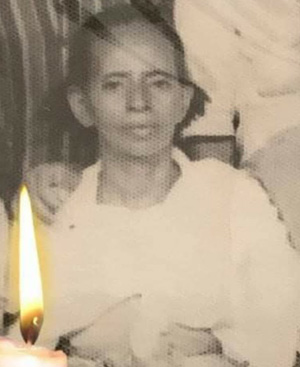
ፋና ተዛረ ዖቅባ ጋብር ትባሃል ትውልዲ ዓዳ ወኪ ኾይኑ ባዓል ቤታ ድማ ዛግር ኣቶ ገብረዝጊ ክፍለ ይብሃል ንሳ ሓንቲ ካብተን ብዙሓት ሃገራውያን ጀጋኑ ኤርትራውያን ደቐንስትዮ ን'ሜዳ ኤርትራ ናጽነትን ማሕበራዊ ፍትሕን ከምጽኣ ዝወፈራ እያ።
ፋና ኣብ ብረታዊ ቓልሲ ኾብረት ኢያ ትፍለጥ ዝነበረት ።ፋና ከኣ ትበሃል።
ምስ ኣብ ዛግር ዝነብር ኣቶ ገብረዝጊ ክፍለ ዝተባህለ ሰብ ተመርዕያ ኣደ 7 ቖልዑት ክትከውን ድማ በቒዓ """"
ፋና ስድራኣ ብምጥርናፍ ኣብ 1978 እያ ናብ ሜዳ ኤርትራ ተጸምቢራ።ብሙሉኦም ደቓ ድማ ነቲ ገድሊ ኤርትራ ምስኣ ሓቢሮም ተጸንቢሮሞ።
ፋና ቕድሚ ንሳሕል ምውራዳ ስድራቤታ እንዳተኸናኸነት እያ ሰውራዊ ምስጢራዊ ስራሓት ኣብ ምስልሳል ተጸሚዳ ዝነበረት።ኣብ ገጠራት ንዝነብራ ደቐንስትዮ ኣንጻር'ቲ ደርጋዊ ናይ ኢትዮጵያ መግዛእታዊ ሓይሊ ንኽልዓላ ብምጉስጓስ ሰውራዊ እጃማ ኣበርኪታ።ብተወሳኺ ናጽነት ኤርትራ ንምቕልጣፍ ሰውራውያን ተጋደልቲ ጽልዎኦምን ሰፊሕ ድጋፍ ብተቐማጦ እተን ዓድታት ንምርካብ ዝውደቡ ምስጢራውያን ኣኼባታት ኣብ ምስላጥን ምውዳብን ውን ዕዙዝ ተራ ተጻዊታ።
ላዕለዎት ካድራትን መራሕትን ሰውራ ኤርትራ ኣብ ገዝኣ ዝግባእ እንግዶት ናይ መግብን መስተን ኣብ ምቕራብ ውን ሓደ ካብቶም ተሰላስሎም ዝነበረት ዕዮታታ እዮም """++
ፋና ብ' 1978 እያ 7 ደቓን ኢያ ንሜዳ ዝተጸንበረት በዓል ቤታ ገዲፋ ነቲ ኣብ ጎቦታት ሳሕል ደጀኑ ጌሩ ዝቓለስ ዝነበረ ገድሊ ን' ናጽነት ኤርትራ ብኣካል ዝተጸንበረቶ።
እቲ ፋና ኾብረት ዝብል ሳጓ ድማ እትገብሮ ዝነበረት ናይ ቅብጥሮት ብ'ተጋደልቲ ጠቢቕዋ።
ፋና ኣብ ከባቢኣ በቲ ተሰላስሎ ዝነበረት ምቕልጣፍ ናጽነት ኤርትራ ዕላማ ዝገበረ ስራሓታ፥ ብፍላይ ከኣ ኣብ ምዝርጋሕ ዕላማ ገድሊን ምምልማል ሓፋሽ ውድባትን ኣዝያ ጸላዊት ሰብ' ያ ኔራ።
ን'ሜዳ ኤርትራ ምስ ተጸንበረቶ ኣብ ጎቦታት ሳሕል ነቲ ናይ ምጉስጓስን ንቕሓት ኣዴታት ሰብ ሓዳር ክብ ኣብ ምባልን ፥ህዝባውያን ርክባት ብምምራሕን እተን ደቐንስትዮ ንሰውራ ኤርትራ ከበርክታሉ ዝኽእላ ሜላታት ኣብ ምስራሕ ዓቢ እጃም'ያ ኣበርኪታ።
ኪኖ ሳሕል ፋና ኣብ መዓስከራት ስደተኛታት ሱዳን ንዝርከቡ ኤርትራውያን ከም ካድር ናይ ህዝባዊ ግንባር ብምዃን ልቢ መንእሰያት ክትሰልብ ውን ኣየሸገራን። ኣብ ክንዲ ኣርሒቕካ ምስዳድ፥ ናብ ሜዳ ኤርትራ ተሰሊፍካ ንጸላኢኻ ካብ መሬትካ ኣውጺኻ ኣብ ሃገርካ ምንባር ከም ዝሓይሽ ኣእሚና ንሜዳ ኤርትራ ዘለለፈቶም መንእሰያት ብዙሓት'ዮም። ኣብ 27/08/1990 ኣብ ናቅፋ ብክብርን ጅግንነትን ተሰውአት ነዛ ኤርትራ መን ኢዩ ኮን ዘይደከመላ ግን ኣይተነግረን ጥራይ ኢልካ ምሕላፍ ይሓይሽ """"""'1 ኣንገሰት ዝተባህለት ካብ ከርሳ ዝወጻ ውሉዳ ግን በጃ ናጽነት ኤርትራ ብመስዋእቲ ተፈልያ """"
ፋና ሓደ ካብ ቑልፊ ዕማማት ናይ ህዝባዊ ግንባር ዝኾኑ ስለያዊ ስራሓት ኣብ ምስራሕን ንቕሓት ደቐንስትዮ ኣብ ምብራኽን፥ ሓደ ካብ ኣዝዮም ተኣፈፍቲ ዝኾኑ ምእንጋድ ላዕለዎት ሓለፍቲ ውድብን ካብ ቐንዲ ሰውራውያን ስራሓታ'ዮም። readmore
Luel Asrat
I went to the field in 1977, I was ninth grade student at that time in Asmera... I was 17 at that time and the political situation at that time forced us. The students were very active about the struggle, and I was influenced by these students, even though I was young, I didn't understand a lot, I was influenced by the students (...) and the fighters were coming to the village, to Embadhero[Luel went to school in Asmera at that time but her family comes from Embadhero, a village about ten kilometers from Asmera on the road to Keren], the fighters were coming frequently to the village... at that time the fighters were telling us about the struggle, and we knew we are under colonialisation and that forced me to go to join... the situation, the figters were giving us education about the struggle(...) that we should struggle for independence, that influenced me to go [pp-74-75]
Asmeret Abraha
I was between 15 and 16, at that time the colonial power exercised high repression many people were imprisoned, this oppression... specially the youth were imprisoned and killed without justification(... ) I was in Asmera... in school in eighth grade (...) before I joined, some of the children of my neighbours, boys and girls, joined... at that tme, in fact, no one knew about the fighters, what was their aim,[we only knew] what the Ethiopian government said, they are doing pirate, robbers, not political fighters for independence, they gave them different names (...) but the EPLF they were having sucesses, and we were hearing about them, and my desire to decolonise made me to join others and end our suffering ( some of my cousins also jointed, my aunt's daughter, everyone... at that time from each family people were going, there was no family not participating [Muller, Tanja R 2005 p 75]
Gedey
In 1973 may students joined the EPLF. But really it was very difficult to differentiate between the EPLF and ELF; we received pamphlets from both and joined whichever one happened to be nearer. In 972 with all tensions around her, Gedey failed her matriculation, Gedey left Decemhare and went to Addis for work. Gedey got a job teaching in a private school. I taught for two years. In this phrase the oppression was more visible and I felt it more because I had become actuely politically conscious-I felt I was a foreigner in Addis. In 1975 after the overthrow of Haile Selassie I joined the ELF. With the nationalistic urge and the desire to fight pushing me forward. I did not choose the ELF and EPLF. I simply wanted an opportunity to express my feelings. I took a bus to Adigrate in Tigray then went on foot to the border. When I crossed the broder the ELF met me. I was registered and taken to the rear areas; there I found many other women also waiting to join. Eventually we were told that because the number who wanted to join was too high, we would not be aloowed to join. But we insisted we really insisted and in the end , 60 women were taken to a training camp south west of Asmera in Serai province. Thousands of young people were joining so there was only one month of military training. Between January and April 1975 7000 joined the ELF alone When I was joined about 300 girls were receeiving training, the oldest were about 23. After our training was over I was assigned to the security department in the highlands around Asmera. My job was identifying spies because the enemy was also sending students to join the ELF.
Since there was no political training, the attitude of man to women was unchanged; it was exactly as it was in socitey in general. On the one hand we were assigned with men to carry guns but on the other hand it was very difficult to work if you were a women. For example when you gave your report it would not carry the same weight as that from a man.
Again, although sexual contact was forbidden on pain of death because of poor discipline, there were case of sexual harrassment. Because there was no political education we also had no base for future. Most leaders were intellectual they did not know the peasant cadres, they didn't understand the problems of the masses and the people did not understand them. After about a year, however, they decided to start some political education. I was transferred to the political department, given some very quick political training, and asked to go round teaching politics in the training camps. This was something new for the ELF at that point. This was when they also started mass organisationa linked to the ELF. It was called the Eritrean Womens Association. I never joined this organisations, and I was not alone. There were many women who did not accepted it although the leadership tried to force it upon us.
All this was happening between 1976-1977. At this time there was also a lot of conflict within the ELF over other issues, particularly that of unity with the EPLF. A large section of us ordinary fighters wanted unity but a reactionary leadership refused. In 1977 there were military battle in Senhit.the leadership and their faction encircled us and started attacking us. I was wounded with bullets in both legs. Comrades carried me for five hours carrying their guns and me. They took me to the EPLF, I was treated in the Central Hospital. It took eight months to cure Source Wilson, Amrit (1991 pp.59-61)
 |
Ruth Simon was a student at Lycee Gibra Mariyam (French School) Addis Ababa . In 1978 she joined the EPLFwith her two brothers and a sister called Hanna Simon who is currently Eritrea Ambasodor to France . During the liberation struggle Ruth was responsible for the clandestine publications of the Eritrean People's Liberation Front during the war for independence from Ethiopia. After the liberation she was the editor in chief of BANA. She is the first journalist to be arrested in Eritrea since it became a state in 1993. Afewerki personally ordered Simon's imprisonment for "publishing false information."Simon is married and the mother of two children, the youngest of whom was six months old at the time of her arrest. She was arrested on April 1997 and in November of that year, Simon was awarded a CPJ International Press Freedom Award in absentia, the first Eritrean to win the award.On 29 December 1998, Simon was released without ever having been tried..source CJP |
Foaza Hashim
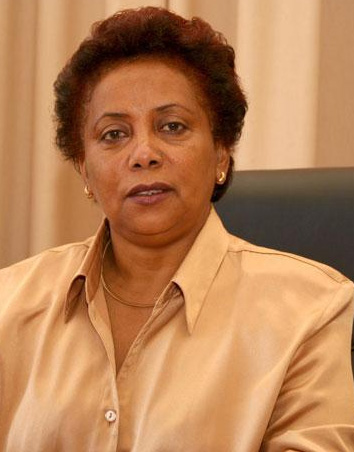
When I first joined the political movement, frankly I was not ... you know aware of ... understanding the political situation, but I have the general motivation, because of friends, and it was at my age, at that time, it was in 1969, I have a friend there, her brother was in the armed struggle, and she was agitating people to get some book for him, and she was talking of what was happening in the country, so at that time I was doing, you know [embroidering] a flag in the handkerchirf, and you know, raising small amount of money, like a quarter of a dollar, and in that way it developed, I was in Asmera and at that time I was in middle school, and at that time one of our teachers was imprisoned for political reason (...) and his family were out of Asmera, so I was trying to take him some cigarettes, some food, so gradually I came into understanding what's happening, hoe people are involved in politcs, and in 1973 I became a full member in the mass organisation of the Asmera division of the EPLF, then I was taking the political classes in the secretive and I joined the field in 1975. [source p74]
Luul Gebreab
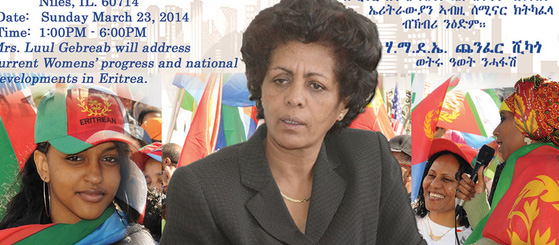
I joined the liberation front in 1976, at that time it was... of hot issue all over Eritrea, atrocities of the Ethiopian soldiers was very high, people were rounded off, put to prisons, being butuchered on the streets in the 1975, so most youngesters at that time were either mobilised or organised underground or joined the field. I was in Asmera, so I was part of the mobilised group from 75 in Asmera, then joined. I was studying at that time in high school, but because of there was a kind of social mobilisation by the Derg at that time, schools were not functioning, so more or less I was not going to school, especially in 1976 [sourceMuller, Tanja R 2005 p72]
Maryam Ghimbi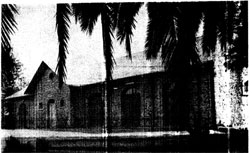
[Eritrea, Asmera the torture prison Maryam Gimbi of Derg 1991 P1[video]
“In the second half of the sixties opposition to the state was stronger, repression was harsher, and Haile Selassie started attacking women too. This was the turning point, after this men and women were treated the same” Worku Zerai [Wilson 44]
The imprisonment and torture of women got much worse from 1975. This section will provide brief information on the imprisonment and torture of women at Maryam Ghimbi prison in Asmara which was most notorious political prison from 1975 to 1991. The building of Maryam Ghimbi , was used by the Derg from 1978-1991 to torture and execute Eritrean civilians accused of collaborating with the liberation fronts. This building used to be a large family house that the Dergue confiscated from its owners. It is big like a castle and has many underground rooms. There is also a servants' house where the family kept their pigs. The Dergue used the castle for the office and the pig house for the prisoners [Wilson 1992 77pp
Earlier, in the 1970s, as was mentioned before, due to atrocities, imprisonment and killings by the Ethiopian security and armed forces many women from rural and urban areas became actively involved in the liberation struggle. Some of them joined the ELF and EPLF military wings, others started to work either with the ELF or EPLF underground called cell members [Clandestine Group of Seven]. Each cell had seven members and formed part of the urban guerrilla work. According to Wilson (1992: 75) among the most risky tasks was recruitment of soldiers from the Ethiopian army. Other tasks were to supply commodities and information... Green (1994 cited Dines (1988:150-151) reports women undergoing torture in Ethiopian occupied territories throughout the war years, especially when suspected of supporting or sympathising with the EPLF. Regarding this, Saba Asier recounted her experiences in her eleven months of imprisonment:
I was arrested in 1982 on suspicious of being an EPLF member, I was imprisoned in Mariam Gumbi, for each arrested person there are seven to eight interrogators. They tie your big toes and your hands together, your arms round your legs. Then they put a stick under your knees; this is called the number 8 because your body is in the shape of an eight. They make a ball from the clothes and vomit of prisoners and put it in your mouth. They turn you upside down and then they start beating the bottom of your feet. You hang from the stick which they lay with its end on two tables. Seven or eight people take turns beating you. When one gets tired, another takes over. On the first night they beat me all night from 5.30 pm to 4 o'clock the next morning. They wanted the names of my friends before they could flee from their homes as soon as the curfew was lifted at 6 in the morning. The second day at 8.30 in the morning they called me again. They beat me from 8.30 till 12 0'clock. One hour of number 8 and then number 9. In number 9 my big toes were tied together and while I was lying on my belly they stood at the sides of my head and pulled my toes over my back. One man stands on your back. Your hands are tied, they hit your feet with stick made of leather. As they beat you their hands turn red and sometimes start bleeding. So you can imagine it hurts them that much, how much it hurts the person that is being tortured
Tsegat Wind survived a prison sentence of three years. She too had been an urban guerrilla in Asmara. At the end of 1980 I was arrested and sentenced for three years under suspicion. Regarding the method of tortures used by the interrogators Tsegat also mentions torture number 8 and 9, furthermore she mentions another torture where they tie you up and insert your face down into a bowl of water. The water is very dirty with blood and vomit. The torturers were men. When you are tortured there is always menstrual flow and it doesn't stop. They do not give you sanitary towels and there is not enough water to wash. There is also psychological torture. The door is made of iron and it has a chain. When they open it, it rattles so every prisoner thinks she is going to be called because being called means being tortured (Wilson 1992 pp.77-79 )
Sila Tekle who was imprisoned in Mariam Ghimbi described the method of tortures used by the interrogators in the prison. There is a link to her full interview with Radio Voice of Eritrea on an Eritrean imprisoned and tortured by the Ethiopian security forces.
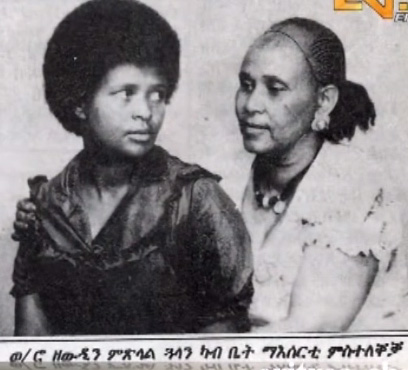
Eritrea Merhaba A sad story of an mother and daughter in Hazhaz [Part-1] [Part-2
Mebrat
a women teacher
In 1980 a women teacher named Mebrat was executed with other 10 teachers, Memhir Tuku her husband herad this tragic news over the radio. Regarding the excution of this women teacher Ararat Iyob descibed in the following :....."a teacher named Zerai (I do not remember his father’s name) asked questions. Sometime later Zerai was picked up by the security, and a few weeks later, he and about 10 teachers, one of them a woman, were executed and the news was sent over the radio. The „goat song “(yefiel wetete) was sung during the announcement the most notorious political prision
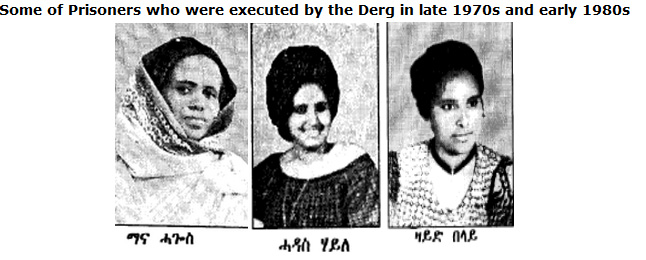
ዝኽሪ ስዉእ ብርሃነ ተስፋማሪያም (ወዲ ባሊላ)
ኣብ 1978 ኣብ ኣዝዩ ኣሰቃቒ መርመራ ናይ ስርዓት ደርግ (ኣብ ግቢ ኣስመራ) ናይ ዝተሰውአ ጅግና ውሽጣዊ ኣባል ህግሓኤ፡ ብርሃነ ተስፋማሪያም (ጸጋማይ ስእሊ) ታሪኹን ዝኽሪን ብበዓልቲ ቤቱ (ኪኪ ጸጋይ) ከምኡ’ውን ብ’መሳርሕቱ ፈዳይን ዝነበሩን (ከም ሕድራይ ፍስሃን- ካልኦትን http://www.snitna.com/…/ckdu_Voice_of_Eritrea_Naz_Yemane_pr…
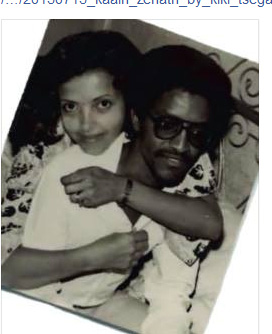
KAAL N ZENAAT N (ByKiki Tsegai (Martyr
Berhane Tesfamariam’s wife)ብ’()15 July 2015 37 years to the day
I gave you a promise Berhane That our kids will be raised with pride, and never be hungry. READ MORE http://www.snitna.com/…/20150715_kaaln_zenatn_by_kiki_tsega…
Nebiet Mebrhatu
Nebiet was in prison twice. Once when the ELF suspected her of working with EPLF they reported her to the police. She was in prison for a month then, and again later when they suspected all bar-women of hiding bandits
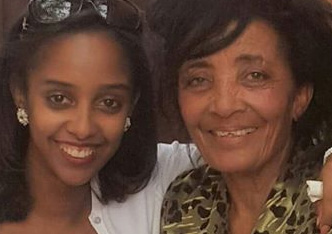
Nebiat's story with Amrit Wilson author of the book The Challenge Road Women and the Eritrean Revolution.Nebiat told Amrit
I was born and brought up in Asmara and I went to school there till grade six. My father died when I was very young. My parents had not been married and my mother had no job. Eventually she got married to another man. When I was about fourteen my mother arranged my marriage to an Eritrean living in Ethiopia-in fact my husband's stepmother was an Ethiopian. They were a rich family.My mother and my in-law agreed that they would take me to Ethiopia but not make me sleep with my husband for a few years. It was all done without my consent and without even my opinion. I was really too young to understand fully what was happening. For one year they kept their promise, then my mother-in-law started telling me to go and sleep with my husband. But I always refused. Then one day my mother-in-law and a friend of hers decided to make me drunk and when I was drunk they gave me to my husband. After that I started sleeping with him. But my life became a life of crying. I felt afraid all the time and I used to cry all the time.
I wanted to run away but I had no place to go. If I had I would have run away the very next day. I kept asking them to send me back to my mother.....But they wouldn't send me back. My father in law was kind to me and so in a way was my husband, but my mother-in-law was jealeous, I think, and she started abusing me. Eventually my father-in law took me back to Asmara to my mother and I refused to return with him. I kept refusing to go back for almost a year and finally they divorced me.
I used to love my mother very very much but after she started being very harsh to me. She used to make me sleep on the floor and would not let me go out anywhere. But there was a man who used to see me. We were attracted to each other and got involved. He asked my mother for my hand. My mother refused permission. Shesaid: You have to obey my orders, it is I who knows who is good or bad for you. In a meantime I got pregnant and my mother discovered it. She started to abuse me and beat me and accused me of disgracing the family. She used to make me work very hard, so hard that I got ill. I always had to sleep on the floor. Finally I gave birth to my child but even up to that point her abuses did not stop. After that she made it impossible for me to stay on in the house. The father of my child rented a small house for me and used to help me with food. Then suddenly right in the middle of all this trouble I was going through, he got marroed to another women. After that I hated to be dependent on him.
I took my child and went from place to place looking for a job office work.... anything. But it was not possible because you need influence to get a job. Then I decided to start buying drinks like beer and selling them in my house. I started getting to know people. Then the problems started. Men would come and expect me to go to bed with them. I hated it. I had a series of conflicts. I began to feel very frightened and insecure and after some time I decided that it might be safer to work in a bar. The next few years when I was working in the bar I tried my best to save money. When I had enough I open my own bar and later a bigger bar. I became totally involved in this work.
Nebiet In this period 1974 to 1976 I started secretly working with the fighters who were entering town-buying commodities for the field and distributing political pamphlets.
Nebiet's friend- Nebiet was in prison twice. Once when the ELF suspected her of working with EPLF they reported her to the police. She was in prison for a month then, and again later when they suspected all bar-women of hiding bandits.
Nebiet : at this time there was a powerful Ethiopian colonel The EPLF wanted to kill him.
Nebiet friend: This colonel was really giving the EPLF hard time. He would go to the battlefield and fill his soldiers with strong fighting morale. When he led a battle the Ethiopian soldiers would fight to the bitter end. He would wald ahead of them, his pistol at the ready, giving them courage.... The Ethiopian colonial like Nebiat. He used to go to her bar and ask when he could meet her. But she always refused because she hate soldiers especially Ethiopian soldiers.
Nebiet: The EPLF asked me to help get rid of him. To do my assignment I forced myself and started dating him. He was always very careful; he alaways had guard around him.
Nebiat's friend: Nebiet would be called to his car and then taken somewhere. He was always surrounded by Ethiopians; the government was taking special care of him.... But with time he started to trust her[and] he would be in the car in front of the bar but with no guard around him. Sometimes he would take her to his house.
Nrbiet It took me six months of study to carry out my task
Nebiet's friend: One day after he came back from the battle field he called her on the phone and told her he would send a car to bring her to his house. She went, stayed with him for a while and then said she would like to invite him to her bar for a special welcome, celebrating his success on the battlefield. She told him not to come with his guards and he agreed.
Nebiet : After this study of six months I succeeded in trapping him in my bar and the fighters liquated him. I had made all the preparation. I had told the EPLF the time and place, sold some of my belongings and got my car ready to escape. On Sunday afternoon, he came to my bar and I brought him some drinks. We sat for a while; then I said I would bring a casette and play some music. I went into the bar and told the EPLF men waiting there that everything was ready-they could follow me. They came out and shot him. After that I could not stay on in Asmera. I took my son and I left to the field.
Nebiet's friend: When she came to the field she was asked if she wanted to go abroad. She answered No I want to stay and fight with my brothers and sisters
Source Amrit Wilson : The Challenge Road Women and the Eritrean Revolution pages83-86
In 19878 Nebiet told Amrit the story of her struggle and later when Amrit visited Eritrea in 1989, a closed friend of Nebiety fron the National Union of Eritrean Women discussed Nebiet'story with Amirit Wilson.
ዶክተር ላይነሽ ገብረህይወት ኣብ "ህዝባዊ ግንባር" እታ ቀዳመይቲ ሓኪም ስኒ : ገጽን መንጋጋን ከም ተወሳኺ መምህርን ኣማሓዳሪትን ዝኾነት ዋዕሮ።
ኣብ ውግእ ብከቢድ ተሃሪሞም ንዝመጹ ውጉኣት ተጋደልቲ ብፍላይ ምስ መንጋጋ ስኒ ገጽ ብዝተሓሓዝ ኣብ ምሕካምን ንካልኦት ኣብቲ ሞያ ኣብ ምስልጣንን ካብተን ብኣብነት ዝጥቀሳ ክኢላ ሓኪም ሓንቲ እያ Readmore
2.1 An Overview
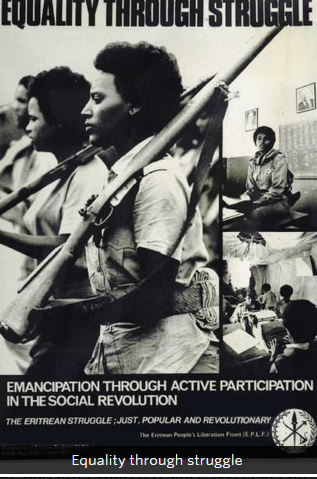 Fig courtesy Rahel Weldeab
Fig courtesy Rahel Weldeab
Gender equality should be more than just a slogan . Did the EPLF kept its promise in post liberation to ensure gender equality ?
Fetsum in his article,"Tegadalit Ab Wushate " wrote Eritrea has always been a deeply rooted male chauvinistic society. Added the burden of colonialism to this, the Eritrean women were circumstantially conditioned to suffer from two distinct forms of oppression: Domestic Male domination and colonialism triggered national oppression similar to any other Eritreans in general. The Eritrean struggle for independence, therefore offered a unique opportunity for Eritrean women to resolve the two oppressions through equal participation in the liberation army. [ Fetsum Abraham, 2013].
. Gender equality is a central feature of sustainable human development because equal recognition for women is a sign of just society (Gebremedhin, 2002 p 24). During the liberation struggle the EPLF to some extent contributed to change the status of Eritrean women in the semi-fedual society, this was through encouraging them to participate equally with men not only in the battlefield but also in social production and public adminstration which was an indispensible requirment for their liberation. To make its objective into reality the EPLF put a lot of effort in eradicating illiteracy and laying down an infra-structure or statelike institutions to provide social walfare, education and medical care etc from 1975 to 1991. The Literacy campaign among members of the Front and these state like institutions opened a good path for women to acquire new skills through work-based training. As can be seen from table 1 the EPLF opened up many new types of occupations for women, most of these occupations previously dominated entirely by men.
However most of these occupations were occupied by these 15% of the total women membership of the EPLF who joined in 1970s and were students or urban workers. Furthermore to ensure the equality of gender in the public adminstrationas there was also a minmus quotes for women representation in local and regional election, as can be seen from table 1 there was high percentage of women participated in public administration which encouraged for other women fighters to participate actively in various emplyoment units.
| Employment type | Participation of women |
Combatants |
23.0 35.0 29.5 25.9 55.2 19.6 19.8 25.0 1.7 9.5 33.1 |
Generally during the liberation struggle the Eritrean women fighters work very hard in laying a foundation for the future generation to see the bright future of them .. However their dream won't turn into reality after the liberation, in fact the circumstance of most ex-fighters women and civilian women getting much worse during the border conflict and after 2002 when the “Warsai Yikaalo Development Campaign” introduced as an extention of the national service.
Following the proclamation of independenc, the Eritrean government discharged about half its fighters in cluding 12, 000 women . . Of some 12, 000 women fighters demobilzed since independence more than half are reported to have divorced. Regarding the demobilization of ex-Eritrean female ex-combatants Hale describes: Hale describes:
“A great number of demobilized combatants were women, mostly from rural areas. They had changed so much that it was impossible for many of them to return to their villages. Of the 12,000 demobilized women fighters, half had divorced, a status that could have very negative social consequences. They did not have much money, no work and little or no education. Not only did they no longer have a place in their rural villages many also found themselves ‘unmarriageable’ (1999).source page 39
Victoria Berna(1996) adds that the marriages and divorces of women ex-fighters were big topics of discussion in Asmara during 1995–96. At that time, there was a wide- spread perception among men and women that women fighters were being divorced by their fighter husbands in favor of civilian brides. Discussing why women fighters were not sought after as mates and were even being divorced by their husbands, Saba and her ex-fighter husband
Kidane attributed much of the blame to pressure from families.
“We came back from the field and instead of us pulling them for-
ward, they are trying to pull us back. . . . We had changed, but the
society had not changed.”
Saba, woman ex-fighter
There was also a report on the hard life of women fighter after liberation by the New York Times reporter James McKinley who met met ex-fighter, Nuria Mohammed Saleh in 1996. Nuria Mohammed Saleh was one of many combatants who actually found herself missing the war. She didn’t not long for the fear and the death, but she missed being “treated like a man.” Like most women EPLF veterans, she found it hard to return to the deeply patriarchal society she left behind as a teenager. In 1990 she was firing away at the enemy but six years later she was sweeping the floor of an office building in Asmara for a dollar a day. Employers were reluctant to hire her for a skilled job despite her military service and EPLF training. “The kind of life we were pursuing in the field was quite different. [Now] we don’t get that respect, that prestige,” says Saleh [source ]
Furthermore Ruth who is an ex-fighter and the editor in chief of BANA, the publication of the Association for the Reintegration of Eritrean Women Guerrilla Fighters, also states that, " The former male fighters are worse than the civilans" At lease, the civilans respect us. Today, not one fighter wants to marry a women fighters Ruth adds that when they came back to the cities after liberation, the government did not concern itself with the emancipation of women and men fell back into the old way of thinking. Ruth is very bitter at the treatment of former women fighters says. “At least, the civilans respect us. Today, not one fighter wants to marry a woman fighter. We are too strong”.. Ruth was the first an award-winning Eritrean journalist who was arrested by the government in 1997.
Azeb in her interview with Tanja R Muller also said that "I thought the liberation movement would open a door for women in this country but it did not as much as I hoped it would" Tanja R. MüllerTanja R. Müller.
To sum up , inequalities between women and men violate fundamental rights, despite this fact in the post-liberation period all the EPLF’s promises looked empty in keeping gender equality, the next section on education to see the gender gap in education in Eritre
Sheikh Abdulkader Kebire(1902 - 1949 ) became controversy by calling for the education of women, something, which was a taboo in those days.

He also believed that only through education and unity can a people be masters of their own destiny.
.
Education is a cornerstone for women’s empowerment and a means to guarantee their equality in society. Brixiova ( 1994:9) states that women’s education is particularly important for raising the quality of life, improving health and labour productivity in both paid and household production. Education also has a key role in achieving sustainability and democratization in a future Eritrea
Lack of education has become the main hindrance in the socio-economic development of the Eritrean people and particularly for Eritrean women to be able to participate equally with men in all aspects of social, political and economic activity.
The aim this section is to provide background information on the gender gap in educational attainment pre and post liberation which is useful for identifying the cause of the widening gender gap in education and for exploring the solution to narrowing the gap.
2.3 Historical background on girls education pre- liberation
Gender differentials in skills training and educational levels have a long history going back to Italian colonization and Ethiopian occupation which left a legacy even after liberation.
Traditional formal education in Eritrea was established for religious purposes, secular education was given as informal and non formal education. Kidane, Eyob (2004) states that churches and mosques planted the first seeds of formal education in Eritrea. When we closely look into the historical background of education in Eritrea, it was heavily religious-oriented whether Christian or Islamic. The objective of religious education was mainly to educate males for religious vocations. Since women at that time were shut out of the ecclesiastical hierarchy and of the governance duties, religious education for girls was not seen as important (Stefanos, 1997, p. 3 cited by Kifle 2002)
Kidane, Eyob (2002) adds that church education in Christendom, was designed primarily for training for the priesthood, but served also to diffuse and preserve all aspects of Christian culture. Generally, children went to two essentially different types of church schools, the first, which may be considered as elementary schools, were small village establishments, usually run by a single priest and the second, which were fewer in number, were larger and academically more advanced, institutions where a number of teachers who were either priests or monks specialised in different subjects. Many men within their communities successfully completed their course for the different levels in the clerical hierarchy to graduate as Deacons, Halekas and Keshies.
Regarding the Islamic education, according Kidane, the first formal Islamic school was established in Eritrea by the Ottomans in Tewalet in 1870. Islamic education was the only source of formal education for Eritrean Muslims. The earliest forms of Islamic schools in Eritrea were known as the Katatib or Khalwah and were established both in the urban and rural areas. Mosques always play a crucial role in the teaching and learning of Islamic education as well as in how to perform prayers and enhance the pupil’s Islamic knowledge. These institutions mainly taught the Holy Quran and the other foundations of Islam.
These Quran schools gradually evolved and developed into Islamic Institutes known as Ma’ahed that have similar organisational structure and design to the modern schools. Many men within their communities successfully completed their courses in different clergy hierarchies and graduated as Shieks and following vast experiences were recognised and promoted to Quadies and Mufties. Traditionally, however women among Muslim communities in Eritrea were not encouraged to get education.
As a result of the traditional education system and other factors, a large number of Eritrean women remained illiterate until the opening of schools by the Sewdish Evangelican Missionaries (SEM) in 1907.
The first Swedish Evangelical missionaries arrived in Eritrea in 1866. They initially started to preach Christianity in the highlands and lowlands of Eritrea. However, they encountered resistance from the locals and were forced to move and establish themselves in the Gash Barka region where they taught the Kunama people. They further encountered more fierce resistance and as a result three of their eleven missionaries were killed. Furthermore, the Catholic Lazarists Missionaries opened the first school in Keren in 1872. This school had enrolled 500-day students and additional 158 boarding students of which 80 were boys and 78 of them were girls. Some of the subjects taught were languages, woodwork, metalwork, tailoring, agriculture and printing. After Eritrea became an Italian colony in 1890, the Lazarist who were French citizen were forced to leave Eritrea in 1896 because France opposed the Italian colonial expansion in the region.
The Swedish missionaries moved the school in Menkulu to Beleza in 1890 and taught subjects like Tigrinya, Italian, threading, textile and home economics. In 1889, a boys’ school was opened in Gheleb and a new girl’s school was later opened in Adi-weghri in 1890. Other schools soon opened in Asmara, Tse-Azegha, Keren, Gheleb, Kuluko, Awsa and Kunama area. A very small percentage of the school age population children were lucky to benefit from the Mission schools and by 1905, the total number of students in Eritrea was only 100. [Kidane Eyob, 2002]
In the first decade of the Italian colonization, Ferdinando Martini, governor from 1897 to 1907, restricted Eritrean access to primary education, which was viewed as a significant threat; this was quite a common belief among the colonisers.
Conversely, his successor Marquis Giuseppe Salvago Raggi (1907–1915) believed that the purpose of education was to train a local elite for posts in the colonial administration. A school for the children of Muslim leaders and notables was therefore established in Keren in 1911 to train students for employment in the telegraph and mail services (Negash 1987, 68–70; Smith-Simonsen 1997, 55–88). In 1921, a Regio Decreto established an educational system for the Eritrean population which consisted of primary schools, schools teaching craft skills, and a type of technical secondary school in Asmara (Ventura 2007, 6 cited in Pretelli (2011)*
This gave a good opportunity to the Swedish Evangelical Missionaries (SEM) to open schools for girls and boys in Gheleb and Keren, providing access to education for girls for the first time. According to Gottesman, Les, (1998) in 1907 there were two Swedish missionary societies which established nine schools in eight centers, and the total number of students rose to 1,100 in the late 1920s. The SEM gave opportunities for girls as can be seen from the table below. However, by 1932, with the introduction of apartheid rules the number of students, boys and girls, declined as a direct consequence of Italian colonialism’s educational policy.
During the Italian colonization, Ferdinando Martini, governor from 1897 to 1907, restricted Eritrean access to primary education, which was viewed as a significant threat; this was aquite common belief among the colonisers.According Negash (1987, p68) Martini saw a threat to colonialism from educated Eritreans, and the undermining effect of education on colonialism. His negative policy towards native schools was based on the belief that an educated population could challenge the basis of colonialism.
Conversely, his successor Marquis GiuseppeSalvago Raggi (1907–1915) believed that the purpose of education was to train a local elitefor posts in the colonial administration. A school for the children of Muslim leaders andnotables was therefore established in Keren in 1911 to train students for employment inthe telegraph and mail services (Negash 1987, 68–70; Smith-Simonsen 1997, 55–88). In1921, a Regio Decreto established an educational system for the Eritrean population whic hconsisted of primary schools, schools teaching craft skills, and a type of technical secondary school in Asmara (Ventura 2007, 6 cited in Pretelli (2011)*

Table 1a(Adopted from The Roots and Development of the Evangelical Church of Eritrea[p.406)
Ephrem (2007: 62) in his thesis mentions that state missionary educational facilities in Eritrea was, by 1930, severely limited in their distribution and accessing them was inequitable in terms of gender and religious denomination. For example, out of the total student population of 2234, female students were only 36 percent. . His research clearly show that there were disparities in missionary educational provision, which is considered to be the major cause of the current inequality between the different ethnic and religious groups. [It is beyond the scope of this compilation to examine this in depth]
Later, from 1932 to 1941, with the development of apartheid racial laws by order of the Italian government no Eritrean was allowed to be promoted beyond the 5th elementary class and after 1936 beyond the 3rd grade (Taye, 1991: 43).
In contrast to men, Eritrean women in the Italian colonial regime did not take part in education. Even male Eritreans could have education only up to fourth grade. Because the Italians associated higher education with an anti colonial outlook, post primary education for men was minimal in Eritrea. As a result as Stefanos writes (Stefanos, 1997, p. 4 cited by Kifle 2002).), only a small, predominately male segment of the population could claim rudimentary schooling after almost sixty years of Italian colonialism. By 1939, the total number enrolled in Eritrea was 4,177 students. This shockingly small number had further declined by 1941 because of the segregationist policy.
The curriculum was including history, geography, language, hygiene, and arts and crafts and by the end of the Italian colonial era there were about 25 schools in Eritrea. However, only one out of five students remained in these schools until the end of the school year and girls were not permitted to enrol schools for most of this era and until 1934. Even then, the schools only taught girls domestic skills and reinforced their household and spousal roles. (Kidane, Eyob 2002)
The segregation and restriction of education beyond the 4th grade came to an end with the defeat of the Italians in 1942. Unlike Italians, the British were less restricting of educational opportunities. They expanded schools in villages and towns. As a result, the desire for education increased very rapidly. However, the relative increase in educational opportunities was overwhelmingly reserved for males
From 1942 to 1952 the British administration played a significant role in introducing modern education and building schools. As a legacy of the British Military Adminstration (BMA) there was a drastic increase in the student population and in the number of schools. Between 1943 and 1951 the students’ number increased from 2,045 to 13,240 respectively (Taye, 1991).
Enrollment in Eritrean primary schools by gender 1943-1950 |
||
| Year | Boys | Girls |
| 1943 | 2330 | 75 |
| 1944 | 2670 | 430 |
| 1945 | 3457 | 610 |
| 1946 | 3659 | 712 |
| 1947 | 3984 | 922 |
| 1948 | 4140 | 1254 |
| 1949 | 5675 | 1774 |
| 1950 | 6658 | 9131 |
As shown in the above table girls’ enrolment in schools during 1943 was a mere 3 percent. This was the legacy of Italian colonization, however, during subsequent years girls’ enrolment showed a tremendous increase. For example, in 1944 it rose to 13.8 percent. By 1950 the percentage of girls again rose to 27 percent. Though the percentage of girls’ enrolment during the BMA showed a steep increase, it remained low compared to boys (Ephrem 2007).
According Ephrem in the Federation period (1952-1962) education expanded significantly. For the first time schools extended to the rural areas and girls started to join schools in large numbers.
Parents and the general public provided building materials, labour and other donations and contributions towards school building.
Taye (1991) in his book also mentions the devotion of the Eritrean people to education when referring to Sylvia, Pankurst
“The British Director of Education, Mr. Kynaston Snell, endeavoured with the modest means placed at his disposal to reverse the Italian imperial policy of debarring Eritrea from Education and to commence by establishing elementary schools on a sound basis. He lacked the financial resources to erect them but the people were eager for their children to be educated so he promised to supply a teacher for any village whose inhabitants built a school and a house for the teacher. At the same time he advertised for young Eritreans who would be willing to teach. There was a great response from the villagers; many schools and teachers’ houses were built. By 1947, no fewer than 59 villages had erected their own schools. Poor people sent a pig, a sheep or a cow to the market in order to provide a share in the cost of hiring builders who had adequate tools, experienced quarrymen and masons to quarry the good, grey stone of the mountains". (Taye, 1991: 59) The villagers not only funded the building of new schools but also paid the salaries of the teachers
Furthermore Taye (1992) states that as many as 82 schools were built in Eritrea during this period and a major leap was achieved in the numbers of pupils and teachers. Table below shows governmental and private schools and pupil numbers from 1952 to 1961School Year
|
Teachers | Pupils | Schools | ||
| Male | Female | Male | Female | ||
| 1952-53 | 314 | 43 | 10072 | 2891 | 90 |
| 1953-54 | 339 | 59 | 11826 | 3252 | 103 |
| 1954-55 | 441 | 68 | 13529 | 3233 | 108 |
| 1955-56 | 442 | 83 | 15190 | 3584 | 111 |
| 1956-57 | 486 | 99 | 15715 | 4327 | 115 |
| 1957-58 | 507 | 109 | 16729 | 4741 | 121 |
| 1958-59 | 486 | 113 | 15776 | 5125 | 133 |
| 1959-60 | 552 | 120 | 19647 | 6351 | 140 |
| 1960-61 | 586 | 129 |
12440 | 8039 | 144 |
Source: Short history of Eritrean educational development 1984 (Amharic) cited in Ephrem 2007:78
During the Federation with Ethiopia, the education system practised was similar to that introduced by the British Administration. All three levels of general education (elementary, middle and secondary) were for four years each and the academic year was composed of three terms of about three months each. The language of instruction at elementary level was also Tigrinya in the highlands and Arabic in the lowlands as was during the British Administration era. English was taught as a subject in elementary schools and was maintained as the language of instruction from middle school up to higher education. For the first time in Eritrea, schools were opened in rural areas during this era and by the end of the Federal era in 1962, there were 145 elementary schools, 14 middle schools and 2 secondary schools nationwide. [Kidane, Eyob 2002]
By the late 1950s and through the 1960s there was strong Eritrean student enrolment for higher education in Ethiopia. One of those students was Abnet Embaye who joined nursing school in Addis Ababa in the 1960s. Here is her brief biography,excrepted from from “The Story of A Strong Eritrean Mother”.
 |
The Story of A Strong Eritrean Mother was written by her daughter Salem Solomonon May 12, 2013. My mother, Abnet Embaye, was born in Dekemhare.My mother grew up at a time when Ethiopia forcefully annexed Eritrea and attempted to undermine the intellectual strength of the country by shifting all higher education to its capital in Addis Ababa. The goal was to co-opt the energy and intelligence of the best and the brightest of the country. During this time, Haile Selasie, the emperor of Ethiopia, held campaigns calling all high school students to migrate to Ethiopia. Advertisements on radio and newspapers targeted young students and provided opportunities in Ethiopia. Amharic, the official language in Ethiopia, was forcefully introduced in the curriculum in Eritrean high schools. As a teenager, my mother vaguely remembers this phenomenon but surprisingly recalls the time with a wistful smile when she talks about it. One day, she said a neatly dressed nurse named Sister Meqdes Worq-yegzaw came to the Red Sea high school where my mother was studying commerce to recruit girls to join nursing school in Addis Ababa. The sight of this nurse and her dazzling white outfit mesmerized my mother. The nurse came to deliver a message from the emperor; it was a big deal and everyone knew about it. The mission was to recruit girls from Keren and Massawa and bring them to St. Paul’s School of Nursing in Ethiopia. This opportunity was open for high school students as young as 14 and my mom was determined to go. read more |
As can be seen from the figure 1, in the 1960s and 1970s many Eritreans started migrating to Ethiopia to seek for work, to reunite with families, to obtain opportunities for further education like Mebrat and to establish businesses

Eritreans migrating to Ethiopia between 1957 and 1998. Source: from the statement by the delegation of the State of Eritrea to the UNHRC, 4th August 1998.
.Most Eritrean who arrived between 1957 and 1975 in Ethiopia succeeded in securing jobs in road construction, transportation service and in the food and textile manufacturing industries, the reason being that they had already acquired skills such as welding, driving, installing electricity, constructing dams and other various building and manual abilities. Erlich (1983), who was lecturer at the University of Addis Ababa, observed that the proportion of Eritreans at this University was higher than of Ethiopians in the early 1970s, which might be attributed to the higher standard of education in Eritrea during the federation period.. Most of them secured better jobs in the private and public sectors. Many modern organisations employed a disproportionate number of Eritreans in jobs such as the Ethiopian Airlines, Telecommunications, Ethiopia Electric Light Power and Authority (EELPA), Air Force, banks, hospitals, and other public health sectors. Erlich pointed out that one factor of the considerable socio‑economic development in Ethiopia was the growing participation of Eritreans in Ethiopian national life, which was able to supply Ethiopia with the necessary manpower (1950‑1960s and early 1970s). Therefore, one would assume the building of modern Ethiopia could not have succeeded without the participation of skilled workers and other intelligentsia from Eritrea.
As mentioned earlier, during the colonial period and the Ethiopian occupation education was available only to a small number of girls from rich families or middle class generally resident in urban areas. In the rural areas the illiteracy rate amongst women was extremely high and by consequence illiterate women generally faced hardship as can be seen from the biography of Fekadu Woldemariam who was born probably between 1941 and 1945. Fekadu lost her mother and father and at the age 5 or 7 she moved to Senafi and started to work as a domestic maid for just 1 Ethiopian birr per month. Her full biography had been written by Daniel Tesfai in Tigriyna in 2015
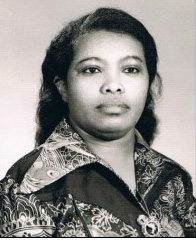 |
ኣብ ዓዲ ቀይሕ እንዳ ሓንቲ ሰበይቲ ከም ተሓዚት ቈልዓን ናይ ቤት ከዳሚትን ብሓንቲ ቅርሺ ንወርሒ ሰራሕኩ። ድሕሪ ገለ ኣዋርሕ ከኣ ናብ ደቀምሓረ ቀጸኩ። ኣብ ደቀምሓረ፡ ኣብ ሓደ ቤተ ሰብ ሓደ ሓላው ኣእራብ በዓል ዓዲ ዃላ ብክልተ ቅርሺ ንወርሒ ንዘይዝክሮ እዋን ሰሪሐ። ብድሕሪ’ዚ ንሰንዓፈ ተመለስኩ። [ክልተ ስጕምቲ ንቕድሚት ሓደ ስጕምቲ ንድሕሪት! እያሱ።] ኣብ ዓዲ ቀይሕ ከኣ ምስ ሓደ ጀበሊ (የመናዊ) ብሽዱሽተ ቅርሺ ንወርሒ ስራሕ ጀመርኩ። ስርሐይ ካብ ንበረኻ ወፊርካ ዕንጸይትን ማይን ምጉራት ጀሚርካ ክሳብ ቤት ምጽራይን ክዳውንቲ ምሕጻብን ይበጽሕ። ድሕሪ እዋን ከኣ ዓደይ ናፊቐ ናብ ክሳድ እምባ ተመለስኩ። እንተኾነ ኵለን መሓዙተይ ተመርዕየን ጸመወኒ። እቲ ናብራ ዓዲ ኣይማእማኣንን። ሓትኖይ እውን ማንቲለስ ዘሊላ ዘሊላ ናብ መሬት እንዳበለት ኣንከላበተትኒ’ሞ፡ ደጊመ፡ ኣብ መገዲ ከየላገስኩ፡ ብቐጥታ ናብ ኣስመራ ኮብለልኩ። ካብ ሰንዓፈ ክሳብ ኣስመራ ንኣውቶቡስ ሓንቲ ቅርሺ ከፊለ። ኣበስመራ ከኣ ኣብ’ቲ ኣብ እምባጋልያኖ ዝነበረ መደበር ፖሊስ፡ ምስ ሓደ ቤተሰብ ፖሊስ ብክልተ ቅርሺ ንወርሒ ስራሕ ጀመርኩ። ነዊሕ ከይጸናሕኩ ከኣ፡ ኣብ እምባጋልያኖ፡ ኣብ ጥቃ’ቲ ቤተ ክርስትያን ኪዳነ ምሕረት ትነብር ምስ ዝነበረት ሓንቲ ሰይቲ ጣልያን ዝነበረት ጓል ጻዕዳ ክርስትያን ስራሕ ጀመርኩ። እቲ ጣልያን ክልተ ቈልዑትን፡ ሓደ ጽቡቕ ቤትን ድሓን መነባብሮን ሓዲጉላ ሞይቱ። ድሕሪ ሞት’ቲ ጣልያን ከኣ ካብ ሓደ ሓበሻ ሓንቲ ቈልዓ ሰሊሳ። እታ ጎረበትና ዝነበረት በዓልቲ ሰራዬ እያ ኔራ ጓል ምዕልታ ከኣ ኣብ’ቲ ገዛ ትሰርሕ ኔራ። ምስ’ታ ቈልዓ ጽቡቕ ተፋሊጥና ከኣ ንባጽዕ ክኸይድ ከም ዝደሊ ምስ ነገርኩዋ ዓሰርተ ቅርሺ ሂባትኒ ንባጽዕ ተሃንፈፍኩ። ኣብ ባጽዕ ከኣ ምስ ሓደ ኣብ ጥዋለት መደበር ባሕሪ ዝሰርሕ ዝነበረ ሰብኣይ ስራሕ ጀመርኩ። ንሰለስተ ዓመታት ከኣ ምስኡ ሰራሕኩ። ንዕኡ ሓዲገ ከኣ ምስ ሓደ ጣልያን ንሰለስተ ዓመታት ሰሪሐ። ። Read more |
During the liberation war a high proposition of illiterate people was to be found in the rural areas where the EPLF recruited most of its forces. Even though small in number, the Eritrean People’s Liberation Front [EPLF] had established schools and adult literacy programs in the liberated areas of the country [ Ministry of Education, 2008). The illiteracy rate amongst women prior to the revolution was extremely high, access to education was seen by the EPLF as a vital constituent of social transformation
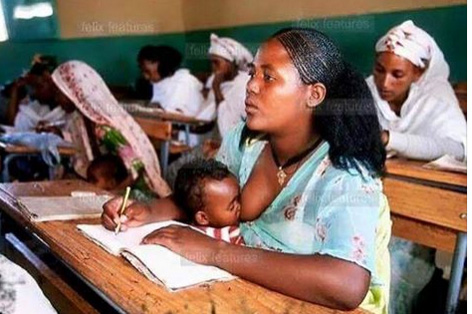
The EPLF also believe that literacy is basic to all human activity and fulfilment. In Eritrea everyone is learning to read and write. In the villages, peasant women attend classes under the trees, [Dines,Mary 1978]
During the liberation struggle girls and women participation in education radically changed as a result of the EPLF’s educational policy of promoting equal opportunities. The EPLF fostered the greatest change in women’s education and the crucial roles they played in the struggle for liberation and independence. The EPLF recognised the need to include women in its struggle, and the role of education in mobilising them (Kidane, Eyob 2002)
Kidane adds that in 1983, large- scale literacy campaign was introduced in the liberated zones, The students of the revolutionary schools played a pivotal role in educating adults during the literacy campaign. As a result of their active participation, more than 150,000 adults became beneficiaries of this literacy campaign.
Green (1994, 35) also states that in the early 1980s, in the first year of the adult campaign alone 13,704 women registered for classes and 67 percent completed the course
By 1989, illiteracy rates fell on average by between 50-70 percent in these areas (ibid). Leonard (1988:127) argues that the attempts of the EPLF to encourage equality in accessing education represented an advance in women’s status. [http://www.bridge.ids.ac.uk/sites/bridge.ids.ac.uk/files/reports/re22c.pdf]
Wubnesh W. Selassie asserts: “Through education many women in the EPLF-administered areas developed their ability to analyze the real causes of their marginalization and learned skills that facilitated their involvement in traditionally segregated work areas. Many women came to realize that equality could not be achieved as long as they [were] seen as marginal to men, society and development ( 1992, 68 cited by Sørensen1992).).
Despite the Government’s commitment to free compulsory primary education for all children, it is doubtful whether disparities in male and female school attendance will disappear in the near future.
2.4 Girls education in post liberation
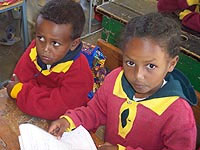
43% of girls and 51% of
boys are in primary school
A positive attitude towards women and education became to be realised during the national liberation struggle. Accepting the value and importance of the inclusion of women in the struggle, the Eritrean People’s Liberation Front (EPLF) committed itself to establish gender equality in education(Smith, 2001 pp. 5-6)...
Education in Eritrea started to encounter challenges and thereby take new dimensions in the 60s to 80s. After the annexation of Eritrea in 1962, the Ethiopian government waged war and created mayhem in order to put-off Eritrean people’s resistance to occupation. As a result of chaos that followed, many Eritreans either joined the resistance or fled into neighbouring countries such as the Sudan. Moreover, many of the schools were changed in to military garrison and others were destroyed due to war
Between 1941 and 1961 there was good progress in education in Eritrea but with the launch of the armed struggle in 1961 the student population started to decline due to young people joining the Fronts, atrocities committed by the Ethiopian government, persecutions carried out by the ELF and EPLF and many of them fled to Sudan. . Consequently, by 1988, only 20% of the school age population were schooling in Eritrea..(Kidane, Eyob 2002)
Furthermore Kidane states that the educational system in Eritrea shows all the symptoms of prolonged neglect under conditions of colonialism and war. At the time of independence in 1991, 84 per cent of the existing 190 schools were rated to be in serious disrepair. The remaining 16 per cent were far from providing a satisfactory learning environment. Disparity in the geographical distribution of schools was sharply marked. For instance, the number of secondary schools and students in the highlands were much higher than those in the lowlands areas of Eritrea.
After independence in 1991, education was among the top priorities of the Provisional Government of Eritrea (PGE), and the PGE announced the specific 15-year targets to included raising the elementary school enrollment rates to 80 %. (Brixiova, 1994:1). Based on this policy more than 375, 000 students, or 40% of the school-age population, were by 1998, enrolled in more than 829 government and non-government schools; however, most of these schools need a lot of improvement, expansion and/or replacement. (Kidane, Eyob).
Furthermore, as Ephraim in his survey (2007) states, since independence, there are a substantial number of school age children out of school. Ten years after independence in 2001/2002, about 270,000 school age children (53.98%) have still not enrolled in primary schools, which presents a major challenge to the government (Eritrea, Essential Education Indicators, 2002 cited by Ephrem, 2007)
According the UNSEF report on the gender gap in education, in Comoros (75 percent/71 percent), Eritrea (50 percent/43 percent), Mozambique (82 percent/80 percent) and Somalia (25 percent/21 percent), showing net enrolment of boys to be higher than that of girls. At secondary level, girls’ enrolment remains lower than that of boys. The gap is significant in countries such as Angola (22 percent for boys/20 percent for girls), Eritrea (30 percent/20 percent), Ethiopia (30 percent/23 percent), Malawi (25/23), Somalia (9/5), Zambia (38/35) and Zimbabwe. [http://www.unicef.org/esaro/7310_Gender_and_education.html]
The According to the World Bank report) states that the gender gap began to widen soon after independence in 1991, the ratio of female -to male enrollment (for primarily and secondary education fell against the background of rapid increase in total enrolment (Brixiova, 1994:4) . Gruber (1998) also states that the gender gap is prevalent in the area of basic education, at the primary school level, girls have lower enrollment rates and higher-grade repetition rates than boys. Only 13 per cent of eligible girls attend secondary school. With regard to the enrolment of girls, there was an increase of 17.7 percent between 1991/92 and 2000/01. However, 49.5 percent of all school-age girls are still out of school. With respect to boys 38.8 percent have no access to primary schooling as yet. From this, we can conclude that primary schooling access in Eritrea is still very low and that girls suffer considerably from inequitable access (Ephraim 2007:115).
Rena argued that in Eritrean education, disparities persist in enrolment rates between boys and girls at primary, secondary and higher levels. based on information he obtained from Ministry of Education statistics in 2002, in nursery or kindergartens, there were 47.4 per cent girls and 52.6 per cent boys; in the elementary schools, there were 44.3 per cent girls and 55.7 per cent boys; in the middle schools, there were 40 per cent girls and 60 per cent boys; in the secondary schools, there were 33 per cent girls and 66.6 per cent boys and in vocational and technical schools, there were 15.4 per cent girls and 84.6 per cent boy[ Ravinder Rena[2005]
Additionally, Asmara Commercial College (which is located in the Red Sea School campus), graduated a total of 672 students between 1996 and 2004. Of these 206 are females and constitute 30 per cent in total. Halhale College, which is a branch of the University of Asmara, graduated 434 students in 2003. Of these 80 are females and constitute 18 per cent.
Furthermore the Teachers Training Institute (TTI) has trained 3,637 between 1991 and 2003. Of these 637 are females and constitute 18 per cent. Finally, it is reported that female students’ population in the University of Asmara was 14 per cent in 2002. The similar trend is been observed in the technical and vocational education . .It is also to be noted that the students’ population has significantly increased by about 250 per cent between 1991 and 2003 but the increase in female to male students ratio is not proportional, as can be seen from table 3
| Table 3.Technical and Vocational Education: enrolment by gender and year | ||||||
| Levels | 2000-01 |
2003-04 |
2006-07 |
|||
Tot |
F | Tot | F | Tot | F | |
| Advance | 359 | 110 | 160 | 32 | 208 | 93 |
| Intermediate Technical | 1014 | 228 | 1210 | 333 | 1085 | 481 |
Intermediate Agricultural |
292 | 66 | 495 | 148 | 195 | 101 |
Records indicate that a total of 2,084 students, over 700 of whom are females, have so far graduated from Hagaz Agriculture and Technical School. [Source http://www.shabait.com/news/local-news/19898-65-students-graduate-from-hagaz-agriculture-and-technical-school-with-certificate-]
Table 4: Enrolment of Students, by Gender and Type of Course from 1991/92 to 2002/03
Students' Enrolment in University of Asmara |
||||||||||||
Academic |
Degree |
Diploma |
Certificate |
Total |
||||||||
F |
M |
T |
F |
M |
T |
F |
M |
T |
F |
M |
T |
|
1991/92 |
223 |
1619 |
1842 |
224 |
551 |
775 |
- |
- |
- |
447 |
2170 |
2617 |
1992/93 |
348 |
1248 |
1596 |
173 |
391 |
564 |
- |
- |
- |
521 |
1639 |
2160 |
1993/94 |
252 |
1824 |
2076 |
113 |
249 |
362 |
- |
- |
- |
365 |
2073 |
2438 |
1994/95 |
338 |
2496 |
2834 |
59 |
186 |
245 |
- |
- |
- |
397 |
2682 |
3079 |
1995/96 |
317 |
2526 |
2843 |
29 |
81 |
110 |
- |
- |
- |
346 |
2607 |
2953 |
1996/97 |
252 |
2474 |
2726 |
37 |
329 |
366 |
15 |
52 |
67 |
304 |
2855 |
3159 |
1997/98 |
360 |
2304 |
2664 |
29 |
343 |
372 |
5 |
55 |
60 |
394 |
2702 |
3096 |
1998/99 |
471 |
2832 |
3249 |
32 |
537 |
569 |
37 |
139 |
176 |
540 |
3490 |
3994 |
1999/00 |
519 |
3074 |
3593 |
31 |
386 |
417 |
42 |
83 |
125 |
592 |
3543 |
4135 |
2000/01 |
596 |
3407 |
4003 |
20 |
422 |
442 |
45 |
138 |
183 |
661 |
3967 |
4628 |
2001/02 |
636 |
3897 |
4533 |
19 |
505 |
524 |
84 |
365 |
449 |
739 |
4767 |
5506 |
2002/03 |
613 |
4201 |
4814 |
74 |
515 |
589 |
86 |
445 |
531 |
773 |
5161 |
5934 |
Ravinder Rena: Source: University of Asmara – Different Records
Generally from the academic year 1992/1993 until the academic year 2002/2003, the number of students enrolled in day classes grew despite the outbreak of the war between Eritrea and Ethiopia, from 1998 to 2000. Since then and even more after the crackdown on the reformist movement in 2001, the government has been apprehensive of the University of Asmara students. In order to prevent further student protest the government closed all 12th grade classes and opened a new high school at Sawa[19]. It is now the only high school which provides a 12th grade completion course. Until recently the school system ended at grade 11. According to the government, the rationale for opening grade 12 in Sawa is that the government does not have the money to expand secondary schools around the country.
Since the opening of this school, as soon as students complete their 11th grade class they are transferred to the Sawa high school. There,after completing their 12th grade those who pass the examination are transferred to the new technical college in Mai Nefi whereas those who fail are immediately transferred to the Army and spend the most productive years of their life in uncertainty.
It is to be noted that Eritrea has a serious problem of high dropouts of female students from secondary schools so as to avoid going to Sawa, where all 12thgrade classes have been carried out since the introduction of the new education system in the academic year 2002-2003. Reports indicated that, although the number of students who passed the matriculation exam was 27 per cent both for the year 2003 and 2004, the GPAhas shown improvement. [Rena
The Mai Nefi college was constructed with collaboration between the Ministry of Education and the Ministry of Defense. Colonel Ezira who was a former administrator of Sawa administered this college. Because of this military administration students at Mai Nefi Technical Institute are not allowed to choose what subject they study. The institute in Mai Nefi didn't have a standard library, laboratory and qualified staff , because it was opened without proper planning. Zega (2004)documented it as follows.
"......Prefabricated Houses were imported from abroad, about 400 Indian teachers were recruited and all the students who did their last year of high school in Sawa were all put in the yet unfinished new “institute.”
In 2003 the first batch of students who completed their 12th grade at the Sawa High School were transferred to Mai Nafi Technical Institute. The University of Asmara did not enroll any freshmen students in the academic year 2003/2004. In 2004 the university was again informed that all the students who were finishing high school in Sawa would be sent only to Mai Nefi. In regard to this, Isays Afeworki made clear during a visit to the university of Asmara in 2005 that the staff should not be surprised if they don’t get any fresh students in the coming 4-5 years. The reason, he expalined, is that “ we are in a transition period".
Majority of the departments in the University of Asmara are near termination with no more students and a very few staff. For example, the Marine sciences department has now only a laboratory technician and a graduate assistant. The research facility of the Marine sciences department in Massawa was taken by the security agents of the government. By contrast the government has opened a college of nursing and a college of medicine in Asmara, an agricultural Colleges at Hal Hale and Hagaz, a technical school in Massawa, a teacher traing insitute at Adi Keih, and the Eritrean Institute of Technology at Mai Nefh. All this while the University Asmara was told that in the coming 4-5 year they would not receive fresh students. In 2005. a Cabinet Ministers meeting, underlined the need to strengthen the colleges of science and technology in the country, (Habtemariam, 2005) but expressed no concern over the future of Asmara University. Why is the government not interested in the development of Asmara University, parallel with the development of other colleges? What is the government motivation?
In 1966, during theCultural Revolution all universities in China were closed to ensure military control over warring student factions. In 1965, no new students were admitted to university, no classes were held and nobody graduated with a degree. The university entrance examination were cancelled in June 1966. [pages 268]. By the fall of 1968, Chinese university and high school student populations neither continued their education nor embarked on carriers. Most universities didn't reopen until 1972, the first entering classes made their way to College Campuses still under the control of Maoist propaganda teams. In 1972 enrollments were lower than in 1966 and didn't return to previous levels until 1977... From 1966 to 1976 more than 18 million urban youth were sent to the countryside. During these years only 720, 000 youth were able to attend universities .Vulnerable young females who were living independently and far from their families were subjected to sexual harassment and even sexual assaults at the hand of rural cadres.source pp 267-270
A year after the start of the Cultural Revolution Isaias and other members of the ELF went for training to China,

The above picture of Isaias and other member of the ELF were taken at the Nanjing Military College in China, 1967. Standing L-R: 5th Isaias Afwerki, 6th Mahmoud Ibrahim Chekini/Cecchini, martyred 1972, 7th Ramadan Mohammed Nur, 9th Ahmed Adem Omer. Sitting L-R: 3rd Ahmed Ibrahim Ahmed
Isayas who was in China during the Cultural Revolution adopted the experience of the Chinese Community Party to crack down on the reformist movement in 2001. Asmara University's Students were channelled into a summer work programme. This programme compelled 40,000 students to repair roads, plant trees and work on construction. The intention behind the programme was to divert the students from focusing on democratization and instead engage them in labour. But the summer work program provoked protests and the students called it slave labour. In the end the PFDJ ruling party suppressed the protest and the protesters were taken to an exceedingly hot place called Wia, 30 kilometres from port of Massawa. The temperature there was 49 degrees centigrade (120 degrees Fahrenheit). Since then the University of Asmara became target and in 2006 was closed in order to control any further students’ protest.
Journey to the Detention Camp
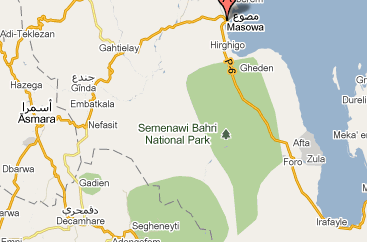
Excrept from The event that I will never forget as long as I live by S.Y. Jan. 2011
"....We travelled all the way to Massawa and passed Massawa and headed to the Massawa-Assab road. Finally, we arrived in a place called “WiA”, a name that I have never heard of, between 9:30 and 10:00pm. We spent the night at the front gate of the “Military Training Center of the 35th Division”. I didn’t know until the early morning that we were encircled by soldiers with machine guns." Readmore
Following , a summer work program of 2001, 12th grade classes started at SAWA in 2002; it is able to train more than 13,000 students. It is observed th at in the first batch (2002-2003), 5,131 out of which 21 per cent were females. These students were in the process of carrying out their national service nationwide when they were selected to enrol the 12thgrade classes in Sawa. In second batch (2003-2004), there were 8,400 students. It was reported that, on the 1stof July 2004, out of the 8,400 students who took the 12thgrade Eritrean Secondary Education Certificate Examinations (ESECE) national examination in Sawa (between 2ndand 5thJuly 2004) girls were 22 per cent. In other words, 1848 girls and 6,552 boys attended 12th grade classes in Sawa during the academic year 2003-2004. Some of these students are now pursuing their studies at the Eritrea Institute of Technology -Mai-Nefhi and other colleges in the country[Rena]
The main contributory factors for the low education level among girls are: household responsibilities, early marriage, poverty and traditional attitudes toward girl’s education, which was mentioned briefly earlier.
Regarding household responsibilities impeding girls’ education, Smith (2001:7 ) states that as girls get older, they take on more and more responsibility in the household. Estimates place the time spent on daily work for those between ten- to fifteen-year-olds at six to seven hours. These chores begin to impinge on the time needed for schooling. Smith adds that girls often married at a young age and families often viewed school as a corrupting influence, one that girls should be kept away from to maintain their purity. Once a woman was married, she was considered to have become the property of her husband. She was expected to take on the domestic duties in his household. At household and community level poverty is a major factor in undermining girls’ right to education.
Poverty also plays a huge role in girls’ inability to continue school. Of the girls who dropped out of school nearly 50 per cent listed financial reasons as the main reason. The picture bekow shows that the life of young girls selling of cigarettes and chewing gums on the street of Asmara to support their parents financially
Pregnancy was the second most common reason girls gave for leaving school. . (By Dr. Kirsten Stoebenau, 2015... Committee on the Elimination of Discrimination against Women on 6 March 2015 also reported many girls drop out of school, become pregnant or marry, or flee the country to avoid enrolling at the Sawa Centre. (http://tbinternet.ohchr.org/Treaties/CEDAW/Shared%20Documents/ERI/CEDAW_C_ERI_CO_5_19528_E.doc.)
According to the Ministry of Education (2008: page 17), enrolment disparities prevail along urban-rural and gender lines. In urban areas, girls have equal enrolment rates as boys, but girls’ proportion slide down with increase of grade level. Girls are more likely to drop out than boys at the higher levels of education. In predominantly rural and remote regions of the country, although educational opportunities have been provided, girls do not access them as much as the boys
According Brixiova(1994) in rural areas parents have returned to the customary property and marriage laws, thus putting women in serious disadvantage as far as their access to employment opportunities is concerned and reducing incentives for parents to invest in girls’ education. ( Becker, 1933 cited Brixiova ( 1994:16)
Some parents view schools as places that negatively influence girls’ purity and undermine the role of girls to be a wife and mother. Such attitudes reduce parents’ willingness to invest in their daughters’ human capital. Marriage considered to be very important in the Eritrea society and many girls get married rather than continue their schooling. According Rena 38 per cent of girls leave school due to marriage and another 10 per cent leave to stay home and care for siblings or work in the home. Often these girls are not dropping out by choice or because of academic failure, but because their parents are decide that further education is not necessary for their future roles. This is also confirmed by Elmi who in 2006 was a fourth year graduate student at the University of Asmara. In her interview she recounts:
“The people in Eritrea they think that girls must marry… if you want to participate in the society, you have to marry… the society thinks marriage is the most important… you want to be respected by the society, like that, so you have to think about it. Because of this in fourth year, all the girls now think about getting married. p195.
Luel Asrat , then mayor of Adi Qualia , also states that the society considers women to have to be at home, to wash, clean and prepare food for the men, they have that perception of women. Zahra Jaber, then mayor of Keren, states:
“… Our men sometimes have a low opinion about the women, how the women become a mayor…. Our society it is still…. We need a lot of time to accept many things about women”P157/ {bits missing here]
Besides, Eritrea faces generations of tradition that reinforce the belief in early marriage and keeping women in the home. The same traditions disregard wife beating and female genital mutilation – all of which deny basic individual human rights to women. It is therefore; the parents who have to be influenced, in order to improve the situationn[Rena 2005]
Msigana in her interview with Muller states that at the elementary school level there were many [girls] and in the high school when you promote from class to class, especially women they are victims of failure (...) they get married, most of the time not boys, but girls, during our high school, especially high school, they were getting married very early [ Muller p127] [This paragraph needs to be looked at again. It doesn’t make sense]
Generally all the factors mentioned directly or indirectly contribute to widening the educational gap between male and female pupils which then impacts in low economic growth and on the prospects for poverty eradication .( also states19 ) Persistent gender inequality in education are likely to endanger the goal of poverty eradication. The picture below shows how poverty hamper girls' access to education which becomes one of the contributor factors in widening the gender gap in education and exacerbate male–female income disparity
Depriving women of access to education is likely to limit the efficiency of education, health and family planning programmes. Countries with large gender gaps are likely to end up in a perpetual circle of low per capital income, high fertility, and little human capital investment (Brixiova, 1994)
Poverty and domestic responsibilities of girls and women are one of the major factors that contribute to children dropping out of school at the elementary level. About
50 percent of Eritrean children drop out of school
at the elementary level.. In the rural areas this contributes to there being a high proportion of illiterate women. In the rural areas girls are still considered as a person born to perform domestic duties and agricultural labour (Stefanos, 1997, p. 7) and parents have economic reasons for not sending them to school. Female enrolment was consistently much higher in nongovernment schools than in government ones. In nongovernment elementary schools the girls comprised consistently around 52-53 percent of total enrolment, while in government schools their share in enrolment declined from a peak of 49 percent in 1990-91 to below 45 percent in 1997( Brixiova ( 1994:9)
Since 2002 the main cause of the decrease in female to male ratio in higher education is due to University entrance exams at the Sawa military camp.
According to Brixiova(1994: 9) at the secondary school level, the female enrolment declined in both nongovernmental and governmental schools- over the 1990/91-1997/98 period- from about 54 percent to 43 percent in the former, and from 48 percent to 38 percent in the latter ( Brixiova, 1994:9). As a result of this the gap between male and female students has gone up from just 4 per cent in 1991 to 33 percent in 2003.
Early marriages and pregnancies, especially in rural areas, are self-explanatory because the correlation between early marriages and pregnancies and female enrolment is always inverse. In Eritrea, the combined effect of female dropout rates and early marriage hinder female participation in education. According to Brixiova, Bulir and Comments (2001, p.16) one of the reasons for the widening of the gender gap in education, especially at secondary level, in Eritrea is the high fertility rate of women in the secondary school age bracket. Families prepare Eritrean girls for marriage. They are taught to be obedient and quiet, to respect the leading roles played by males and to take on responsibility for bearing and rearing children, and this responsibility not only hinders them in attending school but also precludes them from external jobs (Smith, 2001, p. 7).
Lack of academic culture is one of the biggest obstacles to girls’ social status. The widening gender gap affects the long -term rate of growth while higher female education levels are associated with lower fertility rates, better nutritional status of children, a lesser prevalence of female genital mutilation, and increased use of family planning and AIDS prevention.
Women with some primary school education have 40 percent lower fertility rate than those with no education and their children are twice as likely to be well fed. Improvements are even greater for women with secondary school education ( Brixiova ( 1994:18). Kifle (2002: 42) found that 33.5% of women (aged 15-19) with no education were mothers, whereas it was only 6.6% for those women who completed primary education.
Concerning teenage pregnancy, 8.1% of women aged 15-19 with no education and 1.3% of women with primary complete were pregnant with first child.
Generally the educational futures of girls in Eritrea have become militarized. “If girls make it to 12th grade they must pass the National Exam and score high enough to be admitted to the University. Many girls do not want to complete their National Service and are getting married...or they say they are getting married to avoid going to Sawa. If they do not take the exam or fulfill their National Service they cannot go to the University. We cannot bend these rules. The female students that do attend the University are very successful, but they are few in number”. (author’s interview July 28, 2004]
Reasons for Gender Gap in Eritrea: [excerpt from Gender Disparity in Education [An Eritrean Perspective]
There are many factors that contribute to the gender gap in Eri trean education. Studies show that girls are put to work, helping their mothers fetch water and firewood, mainly in the rural areas; work load at home (domestic chores) such as caring for younger children, sweeping and cooking. These are social problems associated with theeconomy of the families. Another constraint is school distance. Lack of transportation facilities for students is a
problem.
Children in the rural areas face difficulties to travel long distances to schools, which cause tiredness and absenteeism. It is to be noted that in some
of the areas the students walk (one-way) 10-18 Km to reach their schools. This is worse when students are needed at home for work. And, no doubt, girls are prone to such burdens. A related issue is a matter of safety for girls on their way to school or home.
Moreover, a mix of traditional mores (i.e. norms and beliefs), crippling poverty, lack of parental interest, support and encouragement, and pastoral or nomadic lifestyles of some of the students are among the main factors inhibiting greater female participation in the school system Many other factors conspire against girls’ education as well as, most notably, the practice of early marriage, though in this regard there is an improving trend. Lack of sanitary system and availability of clean water in schools can also pose a sense of discomfort.
In addition, war and conflict over the years have been contributing to regional and gender imbalances as regards access to education. War has shuttered many schools and has caused the destruction of infrastructure besides causing displace ment particularly in the border areas. This has aggravated the situation in the country [Rena ]
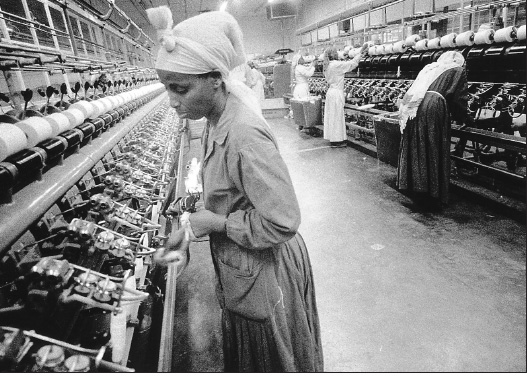
This section looks briefly at women’s employment in post liberation. ,
According to Worku Zerai ‘Economic dependency and unemployment is sending many women ex-combatant s back to their villages, and to a traditional lifestyle, dominated by the patriarchy “ Women in urban centres where much of the Eritrean’s industry is based face precarious working conditions and low pay. According to prelimnary study by Zerai , the majority of women workers (75.2%) earned an income of between 100-400 Birr (10-40 pound per month ) well below the average income perhead. These women unskilled and found manily in textile, leather and chemical factories and according Zerai ‘s research , the majority of these workers(88.3%) have never had access to any form additional training skills development in their jobs Lieshout, 1997,
The EPLF’s promises looked anything but empty in preserving gender equality. It is surprising to see that unequal payment of male and female for similarly skilled work. The EPLF had promised to ensure gender and employment equality and this was written in the National Democratic Programme of 1977 and 1987.
According to Reva women are concentrated in low-skill, low-paying jobs and earn only 50-80 per cent of what their male colleagues earn (Green, 1994) Even where men worked alongside women in unskilled occupations, they consistently received wages 50 percent higher than their female counterparts (Selassie, 1992:67) This is in contradiction to the EPLF principles during the liberation which was to eliminate unequal payment between men and women. In addition, women’s enterprises are concentrated in areas with limited growth, such as simple food processing and small tailor workshops [Rena, 2007]
According to the 2002 Eritrea Demographic and Health Survey (EDHS) in 2002 only 16 per cent of women above the age of 15 are employed compared to 69 per cent of men; 52 per cent of women are illiterate compared to 39 per cent of men .However, it is observed that the gender inequality is very high in the country. This is also shows that the impact of education on employment opportunities for women. Geberemedhin, Tesfa G (2002:150) also states that job opportunities for women in the formal labor market tens to be limited because of lack of basic education, technical skills and traning, and gender stereotyping. Furthermore the percentage of women with manufacturing establishing is 10 percentage compared to 90 percent for men.
The low education level or no education among girls and women inevitably have a negative influence on their income-earning capabilities and on their access to economic opportunities. Tsegga Giam, head of the NUEW’s Social Services and Rehabilitation Department in her interview states: “The most disadvantaged in Eritrea are women with no education. We try to sensitize whole communities to the importance of girls having an education. We support these ideas with programs that make girls confident (author’s interview,July 13, 2004: 43)
Meintjes notes that in general, men tend to find employment more quickly than women in skilled or semi-skilled work. Since women and men were trained in the same skill areas under the EPLF, female ex-fighters had to compete with their male counterparts for jobs after demobilization. The Liberation Army may have been integrated, but the market-driven productive enterprises of reconstruction society were not. Job market segregation presented one of the largest reintegration hurdles for female ex-fighters sh attering what appeared to have been the gender-transformative process of the EPLF (2001,69). Although female fighters had been trained in skill areas that were in demand for reconstruction, the society’s gender role stereotypes determined that they would not be hired over a male veteran. Female ex-fighters’ mobility and income generating chances were further restricted when the women found themselves alone with the burden of raising several children. Thus we see the effects of two of the EPLF’s major social reforms: the outcomes of relaxed marriage customs could not be overcome by the education and training that female combatants had received because society still saw them primarily in the role of wivesNuria Mohammed Sale
Women in the Eritrean People’s Liberation Front (EPLF) expressed the view that they had felt respected and equal during wartime, but that this was lost as their country began to shift to a normal civilian structure(Robin Arnett)
Worku Zerai also states that unemployment is sending many women ex-combatant s back to their villages, and to a traditional lifestyle, dominated by the patriarchy. For women ex-combatants with little access to income in the cities, returning to the village may prove traumatic. With their dramatically different experiences and life styles during the combat, they may well be estranged from their families. During the armed struggle, the EPLF supported equal rights and responsibilities but according to comprehensive German study “Once back home, the family often expects the women undertake their traditional task and to obey their parents and their husbands Lieshout, 1997,
Mother Eritrea and her new born baby marching for freedom
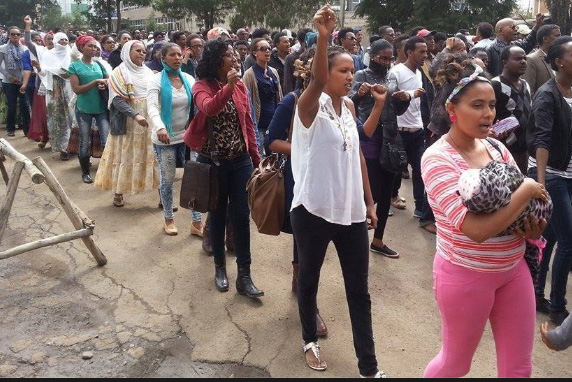

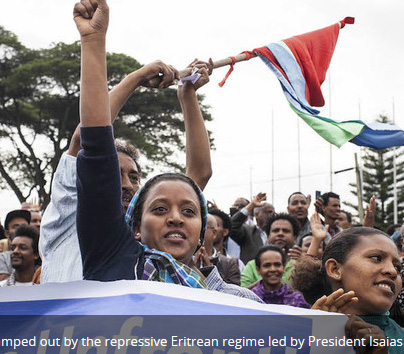
"My country is part of me-part of my tears, part of my pain, my hope for the future and my children's future" (Wilson 1991: 69)
At the second Congress of the Eritrean People's Liberation Front (EPLF) which was held after 8 years in 1987, the EPLF leadership pledged not to repeat the mistakes of the past by postponing elections from 1979 to 1987. They promised to hold the next election in 1989 and would not be postponed under any military circumstances. However, the EPLF leadership didn’t keep their promise and again the election was postponed under the pretext of military operation at Massawa, this disappointed many of the former EPLF fighters. In reaction to this, on the 20th May 1993[[ምንቅስቓስ ተጋደልቲ 20 ግንቦት 1993 four days before Eritrea's official declaration of independence, there was aspontaneous protest by the former EPLF fighters against the leaders for being in the leadership for more than 2 years and other economical issues. A few days later the protester leaders were arrested and some are either still in jail or have totally disappeared. .Read more. The question should be raised here: What is the difference between the ex-fighters imprisoned in 1993 for opposing the EPLF leadership’s policy of postponing the 1990 election and the G15 who opposes the policy of President Isaias Afewerki for postponing elections in 2001?
Forgotten prisoners who protested against the EPLF's leadership in 1993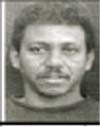
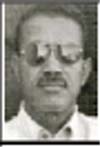
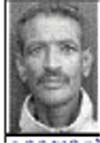
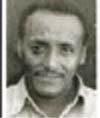
![]()
![]()
Subsequent to this spontaneous uprising, around 10, 000 fighters who joined the EPLF in 1990 were demobilised, to return to civilian life out of fearing that similar protests might occur. During that year the Eritrea Provisional Government also sent several young people including these demobilized fighters to Arab countries to work as maids in Arab households or in the construction industry.
The picture below shows that a gathering of the young people for registering and processing was recorded at the Labour Office Asmara in 1993 [but it is no longer available on YouTube.]
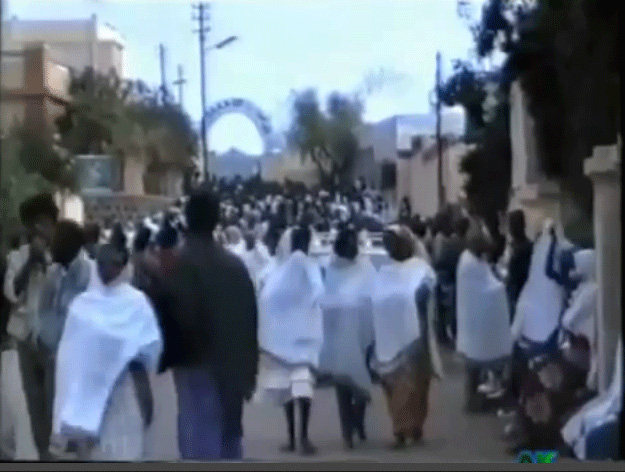
The PFDJ leaders learned from the 1993 uprising how to prevent protests and control the participation of young people should an uprising occur. In July 1994 the PFDJ leaders announced the National Service programme (NS) to disperse the young people from main cities and other urban areas in order to prevent their participation in any protest on the model of 1993 or the Arab spring.
Under this programme (NS ) everyone between the ages of 18 and 40 must take training at the Sawa Military Camp for 6 months ( compulsory military service ) followed by 12 months of work on national reconstruction projects such as in building roads, planting trees etc.
Initially the National Service was limited to 18 months and the Eritrea Government gave hope to young people that after completing their national service they will have an opportunity to gain employment. Which turned out to be untrue. Regarding this Lula in her testimony was published in ‘Violence against women’ on 27th of November 2013 stated that: “The government’s propaganda promises jobs to the youth completing the obligatory military service. But they prevent us from studying and by doing so they steal from us the capacity to have and realize our dreams”.
Consequently, many young women who completed their National Service Programme either migrated to the Arab countries to work as maids or got married. Regarding this Rahel in her interview with Muller briefly mentioned what was happened to her sister after completing the National Service in 1994...
....Rahel's sister did three years of National Service, at first the referedum on Eritrea's independence, then with the Ministry of Labour and Human Welfare, and then in 1994 she was among the first round who went to Sawa for obligatory military service, after she returned from that service, there was no work in Eritrea and when she saw a job advertised in Lebanon as a housemaid she decided to go there and earn some money--and to this day she is still working there, she does not like it and plan somewhere in the future to shift to another country where she eventually can continue her education. According to Rahel , her sister was good at education, she was studying, she trying to join the Asmera University but during that time when she was eleveth grade, there was the revolution that the EPLF was coming toward Asmera 1991.. [ source from the making of elit women by Muller, Tanja R 2005. 97]
Rahel in her interview with Muller also states that when she grew up one of her older sisters was a role model for her. Rahel would sit down and study with her whenever she studied and her sister was very intelligent and good at education.. Like Rahel's sister there are many young people keen on education and intelligent have their futures blighted by the National Service Programme and Forced military drafting.
Since 2002 the period of national service has been extended indefinitely which is known as the “Warsai-Yikalo Development Campaign” .Additionally, in 2003, the government announced that the final year of secondary education, Year 12, must be performed at the Sawa Military Training Camp in western Eritrea near the border with Sudan. This was to prevent increasing evasion of national service by school leavers, those who attend grade 12 in Sawa and matriculate will have the chance to pursue further educational opportunities. For those who choose not to go - their national service begins when they turn 18 and that usually starts with training in Sawa's military camp. readmore. The number of youths who went to Sawa Military Training Camp could be estimated at over 100, 000, between 1994 and 2015. For example, in the twenty-first round of the national military service programme that took place between August 2007 and February 2008 there were 3,510 young people in this round. source.
Sawa is not only a place for a military traning camp and the final years of secondary education but it is also a place of torture for prisoners and sexual abuse for young conscripted women.
In 2015 the UN Commission of inquiry on Eritrea (COI) heard from a man speaking on behalf of his niece, a former conscript who was too traumatised by her experience in military training to speak herself. The young woman was continually pursued by her unit leader for sexual activity. Her consistent refusal resulted in regular beatings and being held in a torture position. Officer asked her to prepare coffee which she reluctantly did, but insisted that she should be treated the same as everyone else. She refused his sexual advances. He used some of the soldiers to beat her with Char’a (a thorny branch from an Acacia tree) and tie her hands behind her. She still has marks from the spikes of the branches and tie marks on her upper arms from being bound so tightly often. In front of him she did not want to show she was in pain, but afterwards cried with pain. She was constantly being tortured, tied, beaten and insulted.
The Commission of inquiry on Eritrea (COI) also received reports of young women and girls fearing punishment if they did not submit to orders to serve officials in their private quarters or submit to sexual attacks by officials. According the COI reports women and girls being subjected to physical and mental punishment, often amounting to torture for failure to submit to a servile status or sexual abuse. Persons who try to assist young women to evade an officer’s demands, or assist them during punishment for refusing sexual requests are also punished.
Bisrat Habte Michael who was born in 1981 in her testimony described the life in SAW Military training as follows “
We were forced to take part in military exercises until we were completely exhausted. They did not care whether you would die or not. She also mentioned that Many girls were raped. There were girls who adapted themselves to the situation and made advances to officers out of their own initiative. Those who didn't comply, who rejected the men were given the worst work or sent into the war readmore
There is also similar testimony from Lula, Elsa &others about life in Sawa which is excerpted from Violence against women w published on 27th of November, 2013
I was 20 years old. After 6 months I realized the soldiers were expecting from me a different kind of ‘service’. My 17 years-old companion and I were made to settle in a house already occupied by male solders”, whispers Elsa. “In practice we had become theirs slaves. As a matter of fact, during the day we had to work for them for 12 hours and by night we were raped. It was simply an unbearable torment. I was fortunate enough to be chosen by an unmarried man. At the beginning I was happy, but he sent me back home in Asmara when I got pregnant. Luckily, this had happened 2 months before the burst of the war. Otherwise I would have been killed at the war front. The officer wrote to me a letter to disown the fatherhood of the child I was about to deliver. I know that in the meantime he had married another girl. A lot of my companions suffer from AIDS. We know about the existence of this disease, but I personally do not know well how one gets it”.
Lula another conscripted women who started attending Sawa in January 2001. For Lula the six months spent in that bloody camp are still a nightmare. She recalls: “At the beginning it was simply a torture. In silence, I put up with enervating marches in the desert, amid spiders and snakes, under a blinding sun that breaks your legs. I wanted to demonstrate to the “bosses“ that I am a good patriot. The suffering started 4 months later, when I was too tired to rebel. Everyday, at the sunset, the male officers used to enter bossily inside our tents to choose one of us in order to spend the night with her. These officers, although duly married, considered it normal to go to bed every night with a different female
Furthermore when Lula started attending Sawa in January 2001, she is just 17 years old and has left school in 1998 in order to look after her younger sister. Abandoned by the husband, her mother is a cardiopathic. It is now two years since she last heard from her two elder brothers. Most probably they perished, like the other 19 thousand youth (officially) declared dead, during the foolish war waged against Ethiopia in 1998. source Read mor
In 2015 the UN Commission of inquiry on Eritrea (COI) in the report also mentioned that officers at the training camps select the young women they find attractive when the new conscripts first arrive at the military training centre. They then have the young women allocated to their service or training team, placing the young women under their control. Furthermore A personal assistant to an official at Wi’a training camp confirmed “Officer chose some women for house labour and for sexual intercourse. He would take them to Massawa. I was ordered to bring girls to commanders’ rooms. They would give me their names and I would go and collect them. They would ask me to do this anytime of the day. I also had the responsibility to take them back. If they had sexual intercourse with them, the girls would get favours such as being given milk. I was ordered to give them something such as milk, oil and water. I can roughly estimate that there were about 1,200 women in three years. During the one year I was at Wi’a, I brought about one to two girls in a day for a period of five months.”
Furthermore a former trainer in a military camp in the 1990s also confirmed that the leaders “selected the most beautiful girls. They are chosen and then assigned to someone.” He further noted the subjectivity of beauty and the preference of particular leaders: “officers abused lots of teenagers.”
According to a report by the Commission (CIO) “Over 70 per cent of the girls were violated like that,Students are not allowed to go to the officers’ rooms, but sometimes the officers ask them to come to their house. The girls cannot say no because they know what will happen in training if they say no. When they enter the room, the officers tell them to take off their clothes and they abuse them. The girls do not report it
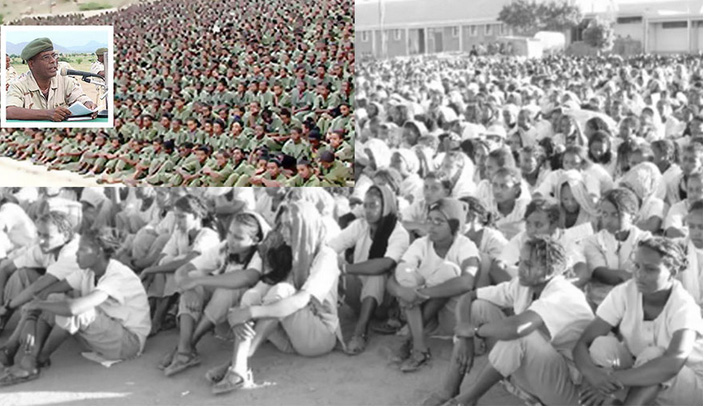
The Commission also reported that a former trainer confirmed the practice of punishing the young women who refused the sexual advances of leaders in the training centres. “If the girl is not willing, they will send her to do hard work, as punishment. … For example, there was one Christian girl named XX … Officer asked her to be his ‘friend’ and she refused so he sent her to ‘Ruba Sawa’, another camp which is very harsh. She was forced to work hard. When she came back … she was told that she spoiled her age and her beauty by being a Christian. They treat girls very badly.
Regarding this the UN in its report uncovering rape and the sexual slavery of young female conscripts in Eritrea, states that female conscripts, some away from their home and family for the very first time are recruited into the indefinite so called national service programme at the tender age of 16 which makes them extremely vulnerable to rape and sexual exploitation.
In addition Dr David Binozzini in his presentation at the Federal Office for Migration on the 26th Feb., 2012 said that women are afraid of going to Sawa, because of the high risk of being raped. readmore. Sexual abuse of young female Eritreans reported by various reliable organisations USAID in 2008, SIHA in 2011 and CIO in 2015
Sexual abuse of young female Eritreans excerpt from 2015 the UN Commission of inquiry on Eritrea (COI)
In 2015 the UN Commission of inquiry on Eritrea (COI) also received a large number of testimonies and submissions relating to the rape and sexual abuse of young women conscripts in military training centres.
Source UN report uncovers Rape and Sexual Slavery of young female conscripts in Eritrea Written by FithiNews
There are many unreported stories of women abused and the inequalities they face in the front line and at the SAWA military training which was inherited from the Eritrea Revolution era (Gedli legacy). Regarding this Zekre Lebona in his article an ‘Eritrean story: a late apology to a spinster sister’, wrote: ‘The abject status of women and girls (prostitution is now so rampant in the land that its victims have stopped venturing far to hide their "shame") is not an isolated phenomenon or anomaly from the "golden age" of The Eritrea Revolution (ghedli), an alleged honor attained by them during their participation in the Eritrean insurgency’.
As was mentioned earlier, in 1975 there were reports of atrocities and massacres in the urban and rural areas of Eritrea, this encouraged many young women to join the Fronts to fight against Ethiopia’s brutal regime. With more women joining the ELF and the EPLF in the 1970s and 1980s, a large number of issues about women’s liberation and equality was raised and debated in both Fronts. According Gedey who joined the ELF in 1975, since there was no political training, the attitude of man to women was unchanged; it was exactly as it was in socitey in general. On the one hand we were assigned with men to carry guns but on the other hand it was very difficult to work if you were a women. For example when you gave your report it would not carry the same weight as that from a man. Again, although sexual contact was forbidden on pain of death because of poor discipline, there were case of sexual harrassment. Because there was no political education we also had no base for futureWilson, Amrit (1991 pp.59-61)
An ex-combatant woman, a nurse, who completed six months military training with the ELF and subsequently worked in a large clinic, revealed:
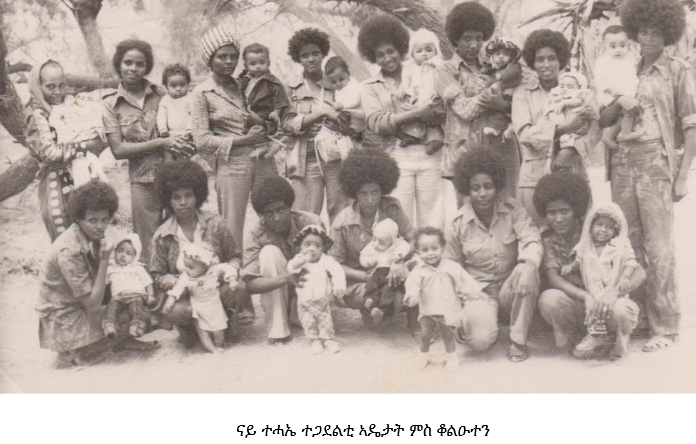 |
There was a problem with high ranking men seeking sexual relations with women in the Front. If a woman refused, the man could make trouble for her, often in subtle ways’. [[ Read more] which has left a legacy for the officers in Sawa.. Regarding this in 2011 the Strategic Initiative for Women in the Horn of Africa (SIHA) states that many women have also reported different kinds of abuse ranging from being used as a personal servant by the officials to actually being forced to be involved in relationships with them. Those who refuse to entertain such offers have been victims of unfair treatment, transferred to remote areas or have missed out on some of the privileges and rights their colleagues have enjoyed . Another women ex-combatant from the ELF explained the following problems in the field: ‘On a general level, relations between men and women in the ELF were good. But, I always felt there was a tendency among some high-ranking ELF cadres in the field to leave the beautiful women behind when an attack was launched. They didn’t want them to fight and be wounded or killed. They wanted them in the camp – to look at or admire, and hopefully seduce’. This has left a trace on the post-liberation period. According the COI report a woman conscripted in an early round of military training described the practice of trainers selecting those they found attractive as existing back then. “Each trainer, pretty much, had a girl serving him. …
|
To some extent the senior of ELF cadres and military leaders abused the genuine comradeship which existed between women and men fighters within the Front, as can be seen from the above. These young women fighters who joined the ELF became mothers in their teens which was against their dream. [source of the picture taken from http://emnetu.com/
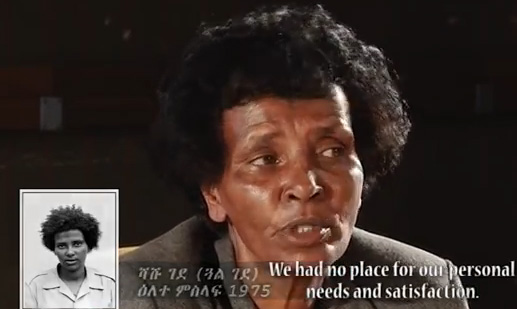 |
Regarding the EPLF women, in the 1970s when many young females had joined the EPLF one of its slogans was for equality for women and another declared that women’s bodies were not commodities for men’s pleasure. In 1975 and 1976, the EPLF forbade sexual relations among fighters; this was confirmed by Genet Meharena when she talked about her time with EPLF in the Eritrean independence struggle. Shasu in her interviewee said "We had no place for our personal needs and satisfaction. Melete also said you only think of how to be martyred heriorical. To listen their interview visit this link: The Fighter Mother -The Fighter Mother - (Official EPLF Documentary video] |
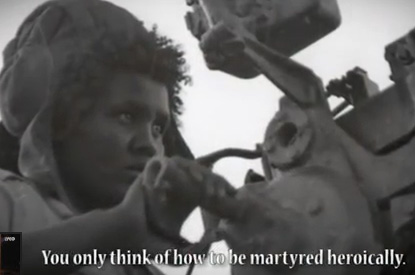 |
In the mid-1970s young female fighters in the ELF were exploited by high-ranking ELF cadres, this provided a good opportunity for the EPLF leaders to campaign against ELF leaders' womanizing. During this period sexual relation was restricted or taboo within the EPLF. At first EPLF required its members to be celibate, forbidding fighters to have sexual relations with civilians and, after women joined the Front, forbidding sex between fighters. Generally speaking in the 1970s the Front’s approach to issues of sexual relations was an attempt to suppress them. To an extent this was an attempt by the EPLF leadership to give women greater opportunity to participate equally with men in all aspects of the Front. Evidence for this can be seen from the text below. However this turned out to be mere hypocrisy in the 1980s. Indeed the high-ranking commanders and senior cadres of the EPLF were also not innocent from abusing young women fighters. From 1981 after the ELF was defeated by the EPLF, sexual abuse of younger female fighters became common within EPLF ranks. Regarding this in 1986 there was a seminar on womanizing and other related issues presented by Issayas Afeworki.
Stefanos Temolso ህዝቢ ኤርትራ ወርዲኡዎ ዝውሕጦ ውድብ ኣይፈጠረ፡ ኣይየዕበየ። ስለ ናጽነትን ፍትሕን ኢሉ ተማእዚዙ ይኸይድ ስለ ዝነበረ ዓወት ተረኺቡ። እቶም ኣብ ህግሓኤ መራሕቲ ዝነበሩ ግን ወላ ከም ኵሉ ውድባት ጕድለታት ይንበሮም ንሓርነት ይቃለሱ ንዝነበሩ ውድባት ብደማዊ ውግእ ኣጥፊኦም ንሜዳ ኤርትራ ምስ በሓቱዎ፡ ኦኣማ ከምዚ እዮም ዝገብሩ፡ እንቋቕሖ ይበልዑ፡ ደርሆ ይደግሙ ወዘተ ይብሉ ከም ዘይነበሩ፡ ደርሁ ዒፍ ኢለንኦም ስጋ ኣባጊዕን በሊዖም ብድሙ ድሙን ዊስኪን ምስ ኣውረዱዎ፡ ስለ ናጽነት ክጋደላ ንዝመጽኣ መሳኪን ኣታሊሎም መርወዪ ወሲባዊ ባህጎም ይገብሩወን ነይሮም። ነተን ሓዳር ዘይነበረንስ ደሓን፡ ንተራ ተጋደልቲ ምስ እከሊት ተራኺብካ ኢሎም ይቐጽዑዎም ከም ዘይነበሩ ንሰብ ሓዳር ኣብ ልዕሊ ሰብኡተን ኣባዕሊጎም ሓዳር ይገብሩለን ነይሮም። ስለዚ፡ መራሕቲ ሻዕብያ እዮም ነቲ ዓማጺ መሪሕነት ከም ቅኑዕ ገይሮም ብምቕራብ ንህዝብን ተጋደልትን ኣታሊሎሞ'ምበር ህዝብስ ኣይብኢዱ ኣይብእግሩ። ንናጽነትን ንፍትሕን ይቃለስ ከም ዝነበረ እዩ ዝርድኦ ነይሩ። ተተሊሙ ግን።
https://www.facebook.com/jelal.yassin/posts/10155793303662447
|
Yordanose in her interview also said that many young female fighters became victims of rape and unwanted pregnancy. Crimes of rape and sexual abuse tended to be committed by high ranking men as had been the case in the ELF... Confirmations for this can be gleaned from the personal testimony of Yordanos Hailemichael interview with assenna.com. Yordanos Hailemichael says "I was raped". She was an underage girl in the Revolutionary School of EPLF (ቤት ትምህርቲ ሰውራ) and then at the age of 14 she was assigned to the mechanized Brigade 74 and became the victim of sexual abuse and abortion when she was in a combat force. Listen to her full story.Listen her full story. This was contrary to the EPLF’s principle in the 1970s that had encouraged many women in exile to join the EPLF Women’s Association. ብጀብሃ ዜተጀመረ ስካሕኽሕ ግፋ፣ ኣብ ልዕሊ ዯቂ-ኣንስትዮ ዜፍጸም ዜነበረ ጾታዊ ዓመጽ (ብፍላይ በቶም ብልሽዋት ካዴራትን ወተሃዯራዊያን ሓለፍትን)፣ ለበዲዊ ብልሽውና መሪሕነትን ወ..ተረፈን። ኩሎም እዙኦም ሕንኹ ፍጻሜታትን ተግባራትን ቅዴም ኢሎም ብጀብሃ ዜጠረዩ ተመክሮታት ኮይኖም፡ ጸኒሑ ሻዕብያ ከም ውርሻ ተቐቢሉ ብዜበለጸ ኣገባብ ዜተራቐቐሎም እዮም። source ንጀብሃ ካብ ገበን ሓራ ምግባር:ምቅንጃው ገዴሊ] |
|
Luul Gebreab, chairperson of National Union of Eritrean Women, and Foaza Hashim Minster of Justice both joined the EPLF in the mid - 1970s because of many people that were being rounded up, put in to prisons and killed by the Ethiopian military. How must they be feeling now with Eritrea becoming a "giant prison", where many people including their close friend Aster Fissehatsion [member of G-15] have been imprisoned without charge? . Amnesty International has also received many reports of deaths in detention as a result of torture, appalling conditions, or suicide. These include accounts of prisoners dying of treatable diseases such as malaria and illnesses caused by excessive heat. Amnesty International believes that at least 10,000 political prisoners have been imprisoned since Isaias Afewerki came to power. source AI. |
|
Here are 15 torture methods briefly described in the report.
1/ Beatings
During the beatings victims are usually tied, including with cuffs, and water is sometimes poured over the body, before or during the beatings. Witnesses reported being beaten with sticks (plastic, wooden, metal, square, with nails, etc.), clubs, handles of guns, plastic rods (with wires inside), whips, electric or rubber wires, leather straps, plastic tubes, water pipes, ropes, chains, branches, thorny sticks, etc. They are also punched, slapped and kicked all over the body, including in their face, head, ribs, genitals and on the soles of the feet. In detention, victims are often beaten at night, some on a regular basis and during several months.
Some of the witnesses were beaten by several persons at the same time and many said the beatings were so harsh that the stick used for that purpose broke. Many victims fainted in the course of the beatings and several reported severe injuries such as broken bones and teeth, open wounds and bruises. The Commission also received reports of deaths due to the beatings and long-term effects such as spinal damage (some resulting in paralysis), hearing impairment and memory loss. A witness was beaten so much on the soles of her feet that the skin came off in one piece. She explained that for years her feet remained sore and she could not walk properly. Another witness reported that a conscript was beaten so hard during the training in Sawa that he sustained leg injuries and is dependent on crutches; and another one developed a mental illness after he was kicked on his face until he fell and violently hit his head.
Tying’ methods described below are either used as a stand-alone punishment or accompanied with beatings before, during or after the tying.
2/ Helicopter
The hands and the feet of victims are tied behind their back and they are made to lie on the ground, face down, or suspended in the air. Some witnesses said they were tied with metal strings or plastic ropes. Victims are often beaten or kicked while being tied or suspended in the helicopter position. Testimonies reveal that milk or sugared water is sometimes poured over the body of the victims to attract insects so that they are bitten but cannot relieve their itch.
Victims may be tied for days outside, exposed to extreme temperatures. Witnesses said they are generally only released two or three times a day for meals and to relieve themselves.
Witnesses explained that their arms and legs were wounded and bleeding by the ropes, which were generally placed on the same wounds day after day. After a while, the upper and lower limbs would swell and feel numb and the blood flow was blocked. This sometimes resulted in gangrene and ultimately led to amputations.
3/ Otto
Witnesses described having their arms tied behind their back, face down and lying on the ground. In this position the elbows are brought together. The ties are sometimes made of metal cords. A witness explained a variant consisting in placing two pens between the shoulder blades and tying the victim tight so that the pens penetrate into the flesh.
Even years later, several witnesses displayed scars on the arms and the wrists due to the ropes. Several said victims had their blood circulation blocked by the ropes and they had to undergo an amputation because gangrene had started. A victim also explained that the bones in his chest broke because the torturer pushed his back with his feet while pulling his arms backwards.
In the army, conscripts are often tied up outside of working hours, to ensure that the punishment does not interfere with their work assignments.
4/ Jesus Christ /Crucifixion
Witnesses described having their arms spread out and their wrists tied on the branches of a tree, sometimes with electrical cords, and being left hanging in such a way that they touch the ground only slightly with their toes. Former conscripts reported that in some military units, soldiers were tied in this position to the cannon of a tank. A witness reported being left in Jesus Christ position for 24 hours; another one explained he was only untied when foam started to come out of his mouth. A former soldier described that the hands of conscripts would swell in this position because the blood could not circulate, noting that as a consequence one of his comrades had his hand amputated.
A variant consists of hanging the victim with the wrists tied together to the ceiling of the torture room or the branch of a tree. A witness also explained that onion powder was sprayed in his eyes while he was tied up in the Jesus Christ position.
5/ Almaz (diamond)
The almaz or diamond method is a variant of the Jesus Christ position described above. Victims are generally hung to a tree with their elbows tied behind their back and are forced to stand on tiptoes. A witness said this punishment can last up to 12 hours.
Several victims fainted after a while and witnesses described severe pain in their arms, even months after the torture, and sometimes long-term paralysis of the upper limbs. A witness explained that the arm of a victim had swollen to bursting point after being hung from a tree in the almaz position for six hours. The pain was so intense, he could be heard screaming “Ciao, I am dying” all night.
6/ Torch
Many witnesses described having their hands and sometimes legs, tied or handcuffed, a stick placed under the knees, and being hung upside down and beaten, especially on the soles of the feet.
7/ Ferro
Several testimonies refer to the use of ferro during interrogations. They described ‘special’ iron handcuffs with bolts that can be screwed from underneath to tighten them (“the metal goes inside the flesh”). This creates severe pain with every move and stops the blood flow. Depending on the replies given to the questions of the interrogator, the ferro are tightened or loosened.
Witnesses described severe pain, numbness in the hands which swelled and bled and temporary paralysis due to these ‘special’ handcuffs. One said the paralysis lasted for three months, the pain six months, and six years later he still suffers from neurologic problems and feels pain in his arms. Some victims displayed scars on the wrists from the iron pin.
8/ Electric shocks
Several witnesses reported the use of electric shocks on their body during interrogation. A witness reported losing consciousness after having received electric shocks on his fingers and toes.
9/ Gomma and some variants
A victim reported being tied in the otto position and placed inside five rubber tyres, head upside-down. His legs and his feet were then beaten.
Another victim reported a variant, whereby he was tied up in the helicopter position with eyes and mouth shut, and forced to lie down on his chest in a narrow barrel in a very uncomfortable and extremely painful position.
A witness described detainees having to take a small container to the top of a hill several times, then being forced to enter into it and being pushed down the hill. Due to this torture, several detainees reportedly become mentally deranged.
10/ Mock drowning
Witnesses described the victims’ head being submerged in water – sometimes dirty – so that they believe they will drown. While most testimonies refer to a barrel or a container full of water in the interrogation room, one reported that the victim was tied to a tree trunk and put all day into a partially empty well.
11/ Buried alive, death threats and mock executions
The Commission received several testimonies describing detainees being forced to dig a hole into the ground, “like a grave” and threatened to be buried inside. Some witnesses were forced to enter into the hole, had dirt piled in it up to their neck and were then threatened with execution or scared with bullets shot next to them. Another said a hammer and a shovel were hung on the door of the interrogation room and he was ordered to tell the truth, otherwise he would be killed with the hammer and buried with the shovel.
Several witnesses told the Commission the interrogators pointed a rifle or a gun to their face and threatened them with death.
12/ Staring at the sun and being exposed to the scorching sun
Several witnesses described a punishment method consisting of being forced to stare at the sun for several hours, and often during several days, when the sun is at its brightest. Victims are reportedly beaten if they close their eyes or move their head away.
Testimonies also reveal that victims are otherwise exposed to the sun during the hottest hours of the day. Witnesses were for instance tied up and forced to lie down or to roll on the hot sand or on iron tanks under scorching sun for several hours, sometimes day after day; or forced to walk barefoot on burning ground. A witness reported for example being chained and left outside, under the sun, from 8 am to 6 pm for forty days. During military training, witnesses were forced to sleep on the hot sand, at temperatures between 35 to 40 degrees, some of them over a period of up to two weeks.
13/ Cold water
Water is poured on the ground and victims are asked to roll on the wet and muddy ground. They are then left dirty, lying on the wet ground and in cold weather (in the highlands) without possibility to wash, sometimes for several weeks.
14/ Use of human waste
The Commission heard two testimonies describing the use of human waste as a form of punishment. In the first, victims tied in the helicopter position were covered with pillows previously soaked in the barrel used by detainees to relieve themselves. The second witness explained that soldiers were asked to pee on the detainees tied up in the otto position and attached to the lid of an oil tank.
15/ Sexual torture
Rape and other forms of ill-treatment and torture targeting victims’ sexual and reproductive organs were documented by the Commission
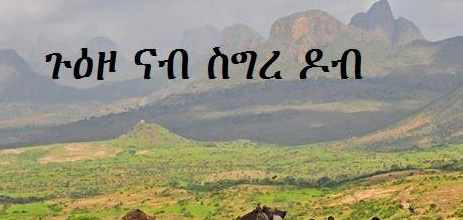
“I want to serve my country, but not forever,” said one young man, who has served four years "
Eritrea, despite its small population, is the second highest refugee producing country in the World. By and large more than 200,000 Eritreans left their country between 1993 and 2012 because of long conscription, excessive militarization and human rights abuses. Regarding the National Service Programme, Professor Gaim Kibreab , in a paper prepared for the October 2014 EASO Practical Cooperation Meeting on Eritrea, explained that ‘In May 2002, the government introduced the Warsai Yekalo Development Campaign (WYDC, (WYDC, which required those who were in the ENS [Eritrean National Service] to carry on serving indefinitely
The 2008 World Bank Report also states that many young E+-ritreans say they are frustrated with having to spend years doing national service and only making around $20 per month. Some have even begun fleeing the Red Sea state. Up to 25,000 Eritreans leave illegally each year. source as a result of indefinite extensions to National Service, the final year of secondary education at Sawa Military Training Camp, conscription, ethnic and religious persecution. source. The UNHCR estimates in January 2012, there were 251,954 Eritrean refugees and 14,172 asylum seekers spread across the Horn of Africa. [sourcee letter] During the first ten months of 2014, the number of asylum-seekers in Europe from Eritrea has tripled. In 2014, nearly 37,000 Eritreans have sought refuge in Europe, compared to almost 13,000 during the same period last year By and large there are over 300,000 Eritrean refugees – and thousands more seeking asylum – across the world: a significant proportion of people from a country whose population is only around six million. Source:The Malta Independentource
Furthermore according to the British Home Office in the year ending March 2015, the largest number of asylum applications (main applicants) came from nationals of Eritrea (3,552), followed by Pakistan (2,421) and Syria (2,222). Grant rates for asylum, humanitarian protection, discretionary leave or other grants of stay vary between nationalities.
Generally as a result of ill treatment and sexual violence at the Sawa military training camp thousands of young Eritreans are leaving the country every month. Below is an excerpt from Young and Astray reason for flight
There are some differences between boys and girls as to why they decide to emigrate, with more girls expressing some concern about sexual exploitation (both in the home, with regard to early or forced marriage, and more often while completing military training).
Some females also explained their physical restrictions, particularly concerning enforced military conscription, as is explained below. Greater discrepancies appeared between age groups in both Ethiopia and Sudan; while children of any age flee from Eritrea for reasons of family reunification, sponsorship and economic burdens or religion, older adolescents and young adults were more likely to cite the perceived threat of forced conscription and of limited future prospects in Eritrea
Aster*, an Eritrean refugee women in Malta, recounted to UNHCR Malta her experience of living in Eritrea: "I was so worried about being taken for national service that I stopped school when I was 16 and hid at home with my mother. I dreaded the day that I would receive a letter from the authorities sending me to the Military Training Camp but eventually it came."
"I remember thinking that I would never see my home again or be able to start my own family. I was also very worried that my family would be ashamed of me for being associated with military activity. So I decided that the only solution would be to escape Eritrea" she told UNHCR Malta. Eritrea today constitutes the second largest, after Somalia, refugee community in Malta.
Over 20% of those granted international protection in Malta hail from Eritrea UNHCR figures also showf that close to half of the refugees in recent years have been women and men under the age of 25 fleeing the indefinite national service. Many recruits report to being subjected to violence and ill-treatment for alleged ‘defiance’ or following a failed escape attempt. Although many women are ambivalent about reporting it, recruits say it is well known that many women are subjected to sexual violence from military commanders ((source Stop National Slavery, 2014).
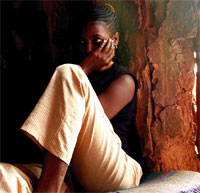
Over the past 5 years the number of Eritrean refugees has increased sharply in Ethiopia which became the second largest country of asylum with 106,89 Eritrean refugees. For example, during the month of October 2014 alone, more than 5,000 Eritreans crossed into Ethiopia compared to the average of some 2,000 arrivals per month since the beginning of the 2014. This number has considerably increased in 2015.
For many refugees the main reason for crossing the border to Sudan or Ethiopia is for protection and to find a better life. Based on a report of COI “90 per cent of the girls destroyed their own dream and don’t even dream about a better life in Eritrea”. Unfortunately, for most of these refugees their misery continues after they cross the border. Various reports mention that girls who cross over to Ethiopia fear sexual harassment by young male Eritrean refugees. Regarding this Asmara Zewere, a refugee said that: "Men beat us, and threw stones … after she rejected his advances.”When a guy asks you for sex, if you say OK, he will leave you after he enjoys himself. If you say no, he's going to stone you.""(Jason McLure, 2007). .
Furthermore Lula Kahassa, 20 says: "We encounter sexual harassment," she says. "There's also a lot of unwanted pregnancy." Sexually transmitted diseases have become a problem. An HIV/AIDS counselor at the camp says that one in eight women refugees is HIV-positive. And there is little health treatment for women, says Terhasse Tesfo, a 22-year-old woman who fled Eritrea after 12th grade to avoid conscription in a country that drafts both men and women into the military. "Men want casual sex," she says. "The major problem is we are living together with [so many] men."source By Jason McLure
Apart from the above problems mentioned, Eritrean refugees who are located in the refugee camps in Ethiopia have also a restriction of movement.. Stefania (2014) also states that in Ethiopia, refugees do not enjoy freedom of movement. The government allows people with serious health problems to live in a town and provides opportunities for a small number of young people to study. . Only some 300 actually benefit, which is 0.3% of the 100,000 refugees on the bookss( Stefania Summermatter, 2014)
The opposition group used a handful of refugees from Eritrea who graduated from various colleges and universities in Ethiopia just for propaganda but they have kept silent about the young Eritrean women who are suffering in various refugee camps in the northern part of Ethiopia. Regarding this Getachew Reda, editor of Ethiopian Semay weblog and the periodical Amharic magazine, in his article “Call on behalf of Eritreans young women/girls in Ethiopian refugee camps"...mentions that most of the Eritrean refugees in Ethiopia enjoy freedom of movement.
Furthermore he highlights the refugees’ living conditions in the refugee’s camp. Here is the excerpt from his comment written in Tigrinya. ኣብ ኢትዮጵያ/ትግራይ ዘለዋ ኤርትራዊያን ደቂ ኣንስትዮ ስደተኛታት ኣዋልድ ዝረኽበ ኦ ዘለዋ ጸገም . Getachew Reda asks why the Eritrean Women’s Associations which has affiliations with the opposition groups never raised the issue of the young Eritrean girl refugees located in the refugee camps in Ethiopia. Here is an excerpt translated from his comments in Tigrinya:
ዝገረመኒ ግና ፤ ካብዞም ኩሎም ዝተ ሰነዱ ጹሑፋትን፤ቪዲዮታትን ኮነ ብመደረ ዝተፈነው ተዘክሮታት ፤ “ዋላ እኳ ሓንቲ !” ኣብ ኢትዮጵያ “ኣብ መዑቆቢ ስደተኛታት” ናብ ዝኾነ ይዅን ቦታ ‘ከይወጻ ተዓጊተን’ ከም እንሰሳ ዘገዳም ተዳጒነን፤ “መእተዊ ማሃያ ሰራሕተኛታት’ ኰይነን“ ብቱዃን፤ብቑኝጪ፤ ብዕንቅርቢትን፤ብሳሬትን ” እንዳተነድፋ ‘ዳረን’ ዝርእያ ዘለዋ ብዕድመ ኣዚየን ኣናእሽቱ ዝኾናን፤ ካብኡ ሓሊፉ ገሊኤን ኣብ ምውላድ ዝበጽሓ ኣናእሽቱ ኣዋልድ ክርስትያንን ኣስላምን ኤርትራዊያን ደቂ ኣንስትዮ ብዝምልከት ዘሕልፈኦ ዘለዋ ስቅያትን፤ ነቲ መከራ ፍታሕ ንምእላሽ ዝተገብረን ክግበር ዘለዎን ጠመተ ከይተገብረሉ ምሕላፉ ኣዝዩ ኣ ገሪሙኒ አሎ readmore
ማሕበራት ደቂ ኣንስትዮን ፤ ፖለቲካ ተቓወምቲ ውድባትን፤ ብዛዕባ ኣብ ሃገር ዘለዋ ደቂ ኣንስትዮ ኣማዕዲኻ መደረ ካብ ምግባር ኣብ ስደት ዝርከባ ደቂ ኣንሰርዮ፤ብሕልፊ “ኣክሰስ” ክርከብ ኣብ ዝካኣል ሀገር ከም ኢትዮጵያ ዝበላ ሃገራት ዘለዋ “ስደተኛታት ደቂ ኣንስትዮ ዘጓንፈን ዘሎ ጸገም “ፎከስ/ጠመተ” ምግባር ዶ ኣይነሓሸን? source from Getachew Reda who is the editor of Ethiopian Semay weblog and the periodical Amharic magazine
‘On March 8th each year both the leader of the opposition groups and the exiled women associations accuse the PFDJ of abusing females in the SAWA military training centres. But they remain silent about what was happened to women fighters under the ELF and EPLF during the liberation war and in the refugee camps in the Northern Ethiopia after liberation. Similarly the PFDJ's Eritrea National Women Association never says anything on March 8 about all abusive , imprisonments and executions of young females and women inside or outside Eritrea.’
It is worth mentioning that young Eritrean refugees who have crossed the border of Ethiopia and currently live in refugee camps also became victims of the opposition groups trying to recruit them. According the Women’s Refugee Commission report Children in Mai-Aini camp explained explained [ Mai Aini camp is one of the refugee camps] over the past 18 months they had witnessed an increase in the number of youths approached by members of the Eritrean opposition, offering them possibilities for education and employment outside of the camp if they join the opposition groups.
The Women’s Refugee Commission described how several children who had been tempted by such offers have since returned to the camp, having escaped from military training in a location close to Shire where they had been taken to train and would then be sent to patrol the Ethiopian border with Eritrea. . The Administration for Refugee and Returnee Affairs (ARRA) agreed that this had been a concern in the past year, but denied claims that the threat of recruitment had grown over the past six months.
ARRA assures that actions have been taken to prevent political opposition groups from entering the camps. The children participating in this researchsaid that they had no interest in joining any political group within Ethiopia; they worried that others might be tempted by false promises, and insisted that UNHCR, IRC and ARRA ensure that children’s focus remain on education and self-development, rather than potentially dangerous political options unaccompanied minors and separated children (UASC). [Excerpts from Young and Astray:]
ኣብ ከባቢታት መተማ ናይ ሱዳንን ስግር ተከዘ ናይ ኢትዮጵያን፡ ካብን ናብን ኣብ ልዕሊ ዝሰግራ ኤርትራውያን ስደተኛታት ደቂ-ኣንስትዮ ዝወርድ ዘሎ ጭውያን ዓመጽን ኣብዛ ሒዝናያ ዘለና ዓመት ብልዑል ናህሪ ይብርኽ ምህላዉ ምንጭታት ድምጺ መድረኽ ካብ’ቶም ከባቢታት ኣቃሊሖም። readmore
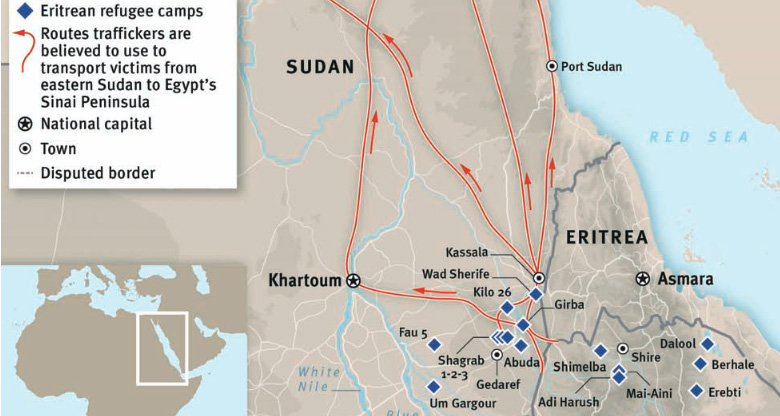
Eritrean women refugees face not only executions, forced labour, imprisonment etc., by the PFDJ but many of them who fled the country face further horrifying experiences. They are routinely raped or held hostage by Bedouin groups in the Sinai, or go missing after fleeing the country.
Zekre Lebon describes the circumstance of Eritrean teenagers: “women and many teenagers in their thousands are forcibly recruited and separated from their families in the camp with little chance of surviving the demands of the tegadeliti officers in the camp, and to a lesser extent the solicitations of their fellow male recruits. If they are lucky and make it across the border, they fall victims to the Bedouin, Sudanese, and Eritrean human traffickers, who exploit their bodies “
According to the UNHCR spokeswoman Melissa Fleming “Over the last two years we have seen people disappearing from the Shagarab camps – some of them kidnapped, and others believed (to be) paying to be smuggled elsewhere,” The United Nations refugee agency (UNHCR) acknowledges the problem but says it does not have the power to stop the kidnappings., “source Traffickers attacking Eritrean refugees in Sudan - rights groups
Kate McIntosh (2013 (2013) reports: "Eritrean women face threat of abuse even after they leave". She states that Eritrean women fleeing their country’s oppressive regime are increasingly finding themselves the repeat victims of abuse, exploitation and violence once outside their homeland, a new report by a women’s rights group has found.” read more .
On the evening of March 10, 2012, 15 Eritrean refugees -all female have been arbitrarily arrested and taken to the notorious UMDURMAN PRISON, in KHARTOUM ,SUDAN. Up to the time of this alert being issued, they have not been charged and are therefore unlikely to be brought to court anytime soon. As recently as last month a young Eritrean girl who was randomly picked up by the police in the streets of Khartoum was raped while her hands were tied up by rope to an iron bar. Source [ICER]
Furthermore in 2012, six Eritrean women, between the ages of 20 to 32, were kidnapped from the streets of Cairo, by men wearing police uniforms. In each case, the victim got into a white taxi, which was then stopped by the men in police uniforms. The ‘policemen’ opened the taxi door and sprayed something in the victim’s face, causing them to lose consciousness. Source assessna.
Our brothers and sisters, for many reasons, left Eritrea and were taken to Sinai. Many suffered there, many were killed in the desert, and some have disappeared. We need to remember them - each and every one. Help us collect the names of our victims so they are no forgotten. Please share the information you have about those who perished by filling in the form below in English or in Tigrinya. Let us Remember our Victims in Sinai |
|
||||||||||||
2010 |
2012 |
2000? |
2008 |
2004 |
2009 |
2009 |
2012 |
2012 |
2012 |
2006 |
2012 |
||
2008 |
2012 |
2004 |
2006 |
2009 |
2005 |
2008 |
2012 |
2012 |
2014 |
2012 |
1992 |
||
ካብን ናብን ኢትዮጵያን ሱዳንን ኣብ ልዕሊ ዝሰግራ ኤርትራውያን ስደተኛታት ደቂ-ኣንስትዮ ዝወርድ ዘሎ ጭውያን ዓመጽን ብልዑል ናህሪ ይብርኽ ምህላዉ ተሓቢሩ።ብፍላይ ካብ ኢትዮጵያ ናብ ሱዳን ዘምርሓ ኤርትራውያን ስደተኛታት በቶም ኣብ መተሓላለፊ ከባቢታት መተማን ተከዘን ሳዕሪሮም ዘለዉ ኣሰጋገርትን ኣብ ገበናት ኢዶም ዝሕውሱ ኣባላት ጸጥታን ዝተፈላልዩ በደላት ከም ዝወርደን ዘተሓስሰቡ ምንጭታትና፥ ግዳያት እቲ በደል ዝኾና ዜጋታትና ጉዳየን ፍታሕ ክናደየሉን ድሕነተን ክወሓሰለንን ዝብገስ ኣካል ዛጊት ብዘይምህላዉ እቲ ተርእዮታት እናተዓጻጸፈ ይኸይድ ምህላዉ ኣገንዚቦም።
ኣብ’ቶም ከባቢታት ዝርከባ ተሓለቕቲ ሰብኣውነት ዝኾና ትካላት ብሓፈሻ ጨናፍር ላዕለዋይ ወኪል ስደተኛታት ውድብ ሕቡራት ሃገራት ድማ ብፍላይ ንኩነታትን ድሕነትን እተን ስደተኛታት ከይሰርሓን ከይጣበቓን ብላዕለዎት ሓለፍቲ ጸጥታ መንግስቲ ሱዳን ዝተራቀቐ ተጽዕኖታት ይካየደልን ምህላዉ ክፍለጥ እንከሎ፥ እዚ ጉዳይ እዚ ኣብ ዝሓጸረ እዋን ፍታሕ ክናደየሉ እንተዘይተጌሩ ኣብ ልዕሊ ኤርትራውያን ሰደተኛታት ዝዉሰዱ ስጒምትታት እናተሓላለዂ ክመጹ ከም ዝኽእሉ ዝተፈላለዩ ወገናት የጠንቅቚ ኣለው።
ዝበዝሓ ካብ’ተን ጾታዊ ዓመጽ ዝወረደን ኤርትራውያን ደቂ-ኣንስትዮ ኣብ ክሊ ዕድመ 12 ክሳዕብ 17 ዝርከባ ጎራዙት ከም ዝኾና ወሲኾም ዘመልከቱ ምንጭታትና፥ ግዳያት እዚ ጽዩፍ ተግባር ዝኾና ወገናትና ኣብ ኣሰካፊ ኣካልውን ስነ-ኣምሮኣውን ጸገማት ወዲቐን ከም ዝርከባ የተንብሁ።
ኣሰጋገርትን ጨወይትን ምስ ላዕለዎት ሰበ-ስልጣን መንግስቲ ሱዳን እናተጻግዑ ኣብ ልዕሊ ስደተኛታት ክባደሉን ልዑል መጠን ገንዘብ ከኻዕብቱን ምርኣይ ልሙድ ኮይኑ ምህላዉ ዝግለጽ ኮይኑ፥ ኣብ ኣብይተ-ጽሕፈት ላዕለዋይ ወኪል ጉዳይ ስደተኛታት ውድብ ሕቡራት ሃገራት ዝርከቡ ስራሕተኛታት’ውን ኣብ ዝተዋሸጠ ብልሽዉና ኣትዮም ብምህላዎም፡ ኤርትራውያን ስደተኛታት ጸግዒ ዘይብሎም ተሪፎም ከም ዘለው’ዩ ዝንገር። ተመሳሰልቲ ዓመጻት በቶም ኣብ ሓለዋ ዶባት ዝርከቡ ኤርትራውያን ሚሊሻታት - ዶብ ኣብ ልዕሊ ዝሰግራ ዜጋታትና ይፍጸም ከም ዘሎ’ዉን ወሲኾም ዘቃልዑ ምንጭታት ድምጺ መድረኽ፥ እዚ ተግባራት እዚ ብስርዓት ህግደፍ ደገፍ ተገይሩሉ ክዛይድ ይርአ ምህላዉ ኣተሓሳሲቦም።
Escaping military service and kidnap, one Eritrean woman’s Ordeal
The stories presented here are nine of fifteen that were collected during the primary research. They were drawn from women currently situated in Sudan, Uganda, and Kenya. The selection set out to emphasise the three key aspects of the issue at hand; the backdrop as to why they left Eritrea, the journey leaving Eritrea and their experiences once outside Eritrea, in their host country as refugees. Many of the stories reflect the situations or abuses that were common to many of accounts and testimonies given to SIHA
Medhin
Medhinbelong to the Pentecostal church, which is not registered in Eritrea and is subject
to persecution. I was arrested the first time in 2003, when I gathered with some other young people to pray, even though we were in a private house. A group of paramilitary police raided the house and arrested everyone there. I was held in May Srwa prison for two weeks and only released on condition that I leave the Pentecostal church. I agreed to the terms, but I would not really leave my church. I got married in early 2005 – my husband is in the same church. Not long after our marriage we attended the wedding of a fellow Pentecostal. The government forces raided the wedding and arrested all of the guests, including me and my husband. We were put in a prison camp called Camp No. 5 and were held there for
two months. They put us under great pressure to leave our church. After two months we were transferred to AdiAbeito prison, about (less than 10)
kilometers from Asmara, where we were kept for another month. From there we were still not released, and were instead transferred to Wia, the hottest place in Eritrea. Here they made us stay for two months before bringing us back to AdiAbeito prison again. Finally we were released, but they took my husband away and put him back into military service, even though he had already served since 1998. He escaped the military shortly afterwards and, to avoid another arrest, we decided to leave the Asmara area. In mid2006 our first son was born, but he developed several health problems. My
husband could not work, due to problems with his back and legs. We decided we had to leave Eritrea for Sudan. We used family connections to find people to smuggle us to Khartoum. While in Khartoum I gave birth to our daughter.However we had no papers in Khartoum so we decided to go to Shegereb camp. Here, life was very difficult – it was overcrowded, there was not enough food, we feared
being taken hostage by Rashaida, and UNHCR did not help us, even with my sons health problems. Finally we returned to Khartoum with a bigger group. Although my husband still cannot work, I have found work as a washwoman in peoples houses and as a hair braider. Sometimes people try to convert me to Islam but, generally, people accept my Christianity
Tsega
Iam the only child in my family. I left school early to help my mother, and both of my parents were very worried that I would have to leave the home to
do national service. The police came to search for me several times, but I always hid at my friends house. My father said he would die if they took me to do
national service.So in August 2011 I decided I had to leave. Our neighbors’son told me that he could get me to Sudan, so I agreed to go with him. I did not tell my parents, but when I escaped they were both arrested in my place. They will not be released until someone can pay a 50,000 Nakfa fine It was in September 2011 that I left home with the neighbors son. We and four others – two men and two women – shared a car from Hagaz to Barentu. From Barentu we walked for four nights to reach Sudan. After crossing the border the group separated; we were told to each go by ourselves to Shegareb camp. I went with the neighbors son, and when we arrived at our camp he told me I had to pay him 12,000 Sudanese Pounds (SDG
)37 to cover his expenses. I explained that I had no money and nobody to pay for me, and that he hadn't said before that I would need to pay. I have no idea if the others had paid. He just said nothing in life comes for free and gave me to a group of Eritrean boys; I dont know if they paid him for me. At first they kept me in shackles. They gave me drugs, partly because I was suffering a lot of pain from the abuse they were inflicting on me. But then I started to
pretend that I would stay with them of my own free will, so they released me. But they still kept me locked in a house, usually with a scarf wrapped tightly
around my head. After about two months, a small local boy noticed me in the hut where I was kept.
One day I was only guarded by one of the kidnappers, so when he went to the bathroom I locked him inside and escaped with the help of the local boy. I went to the UNHCR office; the kidnappers followed me there but I’d met some people
Kedusan
I got married in 2006, while my husband was doing his military service. In 2010 my husband escaped to Ethiopia, leaving me at home with our two year old daughter. He had told his superiors that he was going on holiday to see his wife and child, so when he disappeared they came to my house and accused me of assisting him. That was the first I heard about his escape. They put me in prison for a month until I paid a fine of 50,000 Nakfa After this my husband contacted me through his family, and I also decided to escape, but I would go to Sudan. I left with two of my husband ’s friends. We went to Tessenei, where I was handed over to a Sudanese man, an Eritrean man and two Adarob who would take me and my daughter to Kassala. We paid them 30,000 Nakfa We walked at night through the forests from Tessenei towards Kassala, until we reached Qulsa, a border village. The two Adarob left to find water and the Sudanese man went to bring a car, leaving me and my daughter with the Eritrean. This man raped me in the forest. I tried to fight him but he was too strong. He blindfolded me with my scarf and didnt care about the screams of my terrified daughter. After he raped me he left. An hour later the Sudanese man returned with the car to find me crying, but I couldn ‘t tell him what had happened. In Kassala I was taken to a Sudanese family home, where they gave me food and a room. The Sudanese man told me he would take me to the refugee camp, but that I couldnt go there with my Eritrean ID, cell phone, money or my bag. He took them and said he would keep them for me, and then left. I waited a week but he never returned. An Eritrean lady in the neighborhood translated my story for the Sudanese people and they said the man would not return. The next day I was taken to Shegerab.
I spent two and a half months in Shegerab. I reported my case to UNHCR but they Didn’t seem to care. I was pregnant from the rape but UNHCR did nothing except give me a refugee card. Luckily some Eritrean families I stayed with paid my costs to take me and my daughter to Khartoum. I reached Khartoum and found some work, and then my husband came to find me there. By that stage I was three months pregnant from the rape in the forest. My
husband abandoned me after he found out about the rape and the pregnancy. I was shocked, and I became very sick and weak. The people who brought me to Khartoum contacted my father, who came to see me. My father asked my husband to support me, he explained that I am the victim in
this situation, but my husband refused and demanded a divorce. I was still weak and unwell, and needed a blood transfusion. My father stayed with me until I
had recovered. In March 2012 I gave birth to a beautiful and healthy baby boy. He had all his vaccination shots on time. I loved him very much; he had suffered so much with me and was completely innocent. One day in September he started wheezing and had a fever, so I treated him with
some sesame oil. The next day he was still unwell so I took him to the hospital. Suddenly he lost consciousness due to a sharp drop in his blood circulation, and he died. I was devastated. I was desperate to give my baby a good life. My husband never supported me or asked after me. I don’t want to stay in Sudan, but I haven’t found a way out. I am so upset about my baby son, but now I must focus
all of my energy on my daughter. I only want for her to be healthy and smart
Asli
When I was in 11th grade at high school my family arranged my marriage. In our tradition a girl should not be unmarried in her 20s. I was married within three months of the day I was told about the wedding.Early in our marriage, while pregnant with our first child, my husband was called to join the military due to the border conflict with Ethiopia. At that time everyone joined the military, even my younger brother was there at the front. The conflict dragged on and life was tough, constantly waiting for money from my husband, which was too little in any case. I couldnt support my children on my husbands salary alone – just 500 Nakfa to pay for rent, food and clothing. It was impossible. We moved back in with my family but I couldn’t bear to see myself unable to support my kids and my mother. I became angry and depressed, I cried for days. Then I heard through my neighbour about jobs in Arab countries that paid well that would allow me to support my family. Using a loan from one of my relatives, I organised the people to take me there, a sponsor, money for my medical check up, an air ticket and a contract fee for the agent. My mother tried to stop me but I had to go. I sent a letter to my husband and my brother telling them I was leaving, and without waiting for their reply I left. Leaving my children and mother behind was the hardest decision of my life, but I went to Saudi Arabia in March 2005 to start working as a maid in a family home. I had to wake up at 4am every day, earlier during Ramadan, and wouldn t finish until 1am. The days were incredibly long, and I was only allowed to have a day off once a month. My monthly salary was $100. At first things were okay in the job but after a while I became very upset at the way they all treated me and with the workload. In the second year of the job
the wife of the family didn’t send my wages to my family. I challenged her over it but she said she d sent it. After that she began to nag me and throw things
at me. She was always angry and would shout at me, saying she would have me put in jail and that I would rot in prison. I knew no one and had no rights there; I didn’t know where to turn. I became depressed and just wanted to die. Then one day I received a call – it was my husband saying he had escaped to Sudan and that he was going to head for Italy. He asked me to send him $500 so he could get to Libya then cross the Mediterranean. He let me know he had arrived safely in Libya and had found a place in a boat, and that in a week he would be in Italy. I heard nothing for a month. Then one day I received a call from someone I didn’t know in Italy. He told me he had been with my husband in Libya, and that the
boat my husband had been on had sunk. Everyone aboard drowned. I was out of my mind with grief.
Askalu
When I left school I worked as a cleaner in a chicken farm. There I started a relationship with a co-worker who said he wanted to marry me, but when I got
pregnant he left me. My family also threw me out of the home when they found this out. After the birth of my daughter in March 2005 I went to Asmara and took a job as a domestic worker. I was treated badly by the family and was scared that I would be called for national service, so I decided to leave. I went to the border town of Tessenei and worked selling water at the bus station. The money was barely enough for me and my daughter to survive, and I could not save anything.So in August 2010 I left on foot for Sudan, carrying my daughter on my back. I met some nomads on the road and walked with them to their destination. From there they showed me the way and I continued alone. However the Rashaida found me and captured me and my daughter. We were locked in a house for a month and they told me that I had to find money to pay a ransom if I wanted to be freed. They raped me and they threatened to kill me. They also threatened to cut out my kidney and sell it, if I couldn’t find money for a ransom. While we were captured by the Rashaida my daughter asked me why we were locked up like this, and said: It’s because you don’t have money, isn’t it? I had the number of a friend in Khartoum, and this friend contacted my sister. My family had thrown me out, but my sister stayed loyal to me and went to the mosque to collect 2500 SDG to buy my freedom – back then in 2010 the ransoms were much lower than they are today. Once they received the money, the Rashaida released me close to Kassala. My sister sent me some money there. I’d heard that Shagarb is very bad so I decided to go straight to Khartoum, where I have found work and my daughter is now in school. However my status is still uncertain, I still have no papers. I just want my daughter to have a better life than I have had.
Awatif abdela
fter the war between Eritrea and Ethiopia broke out I was assigned to the military hospital in Ala, because I had first aid training. It was an awful
experience, beyond what I could bear. I was far too young and unprepared for what I saw there. Watching the young men and women suffer and die terrified me. I decided I absolutely had to avoid national service, because at that time the fighting was very bad and I would likely have been sent to the front. I moved to Asmara, where my brother lived, and started class there. When school finished and I was expected to start national service, I hid at home. It was very stressful to live in hiding from the authorities. I always had to keep a look out for military police in the streets before I left home, and it was impossible to leave Asmara as there are so many checkpoints around. I felt like a prisoner in my own country. At first I got through security checks using my high school ID, and once that expired I had to rely on luck. Once I had to run away from the military police, and another time they came to my house in the middle of the night but I’d hidden between the bed and the wall. Luckily they didn’t search too thoroughly .I gave thanks to Allah after each escape. We have all seen so many lives ruined by national service. After I got married, I had to carry my marriage certificate with me as a pass. After
many years my husband won a scholarship to go to South Africa to study for his masters. While he was there the political crisis in Eritrea worsened, especially between students and the government, so it wasn’ t safe for him to return. Because I hadn’t done national service I wasn’t officially allowed to leave the country to join him. A man I was introduced to offered the possibility of escaping to Ethiopia. I hadn’t made any decision, but a week later two security agents came to my house early in the morning and arrested me. They put me in a cell with three women, and told me I was arrested for trying to leave the country It turns out they had found my name and address with someone who had tried to escape with the man I d spoken to. They were caught crossing the border, and must have said something because now the security agent was certain I was leaving too. Later they accused me of working with the man who was helping people to escape. Maybe one of the people they caught said this; the security agents will interrogate prisoners until they give up names – any names. They did the same to me, interrogating me endlessly asking for names of the people I was working with.
They moved me to a new prison where the interrogator was very harsh. He slapped me a couple of times, threatened and humiliated me, talking to me as if I were trash. They expected me to break at some point, but I had nothing to give them so they decided to move me to the worst prison, a detention centre called Mai Srwa. At Mai -Srwa the rooms are metal containers. There were nine women in one container. Most of the others were there because of their religion, and some had been there for six months. We were only allowed out twice a day, for 30 minutes. It was unbearably hot in the day and freezing at night. The food was terrible, and visitors weren They put me in the police station and no police officer ever talked to me about my case or why I was there. When I ask them why I was there, the police officers told me they didn’t know anything and that those who put me there will come to open my file and interrogate me. I was held there for over three months. They interrogated me at random times, any time of the day or night, and always asked the same questions. They told me that if a sentence was passed on my case I would be in prison for two years. I was desperate and pleaded for my family and friends to find a way to get me out. Finally a friend made a breakthrough and convinced a high ranking official to secure my release. But I knew that I could be arrested again at any time. I had to escape my country – there was no authority in Eritrea to protect me. At first they refused me an exit visa because my husband was out of the country. Eventually I had to divorce my husband to obtain an exit visa, and I escaped.t allowed to bring food to us. Most prisoners weren’t even allowed visitors. I’d spent the previous four weeks hoping to be freed because I knew I was innocent. But at Mai Srwa I lost all hope. They had moved me here even though they had no proof and I had denied all their accusations. In Eritrea the authorities don’t need to file charges to arrest you or to keep you in prison. That is the way the system works and no one complains in public; you can’t rely on someone in the outside world to take up your case. Some of the prisoners didn’t even know why they were in jail. Often someone from national security will arrest you and put you in jail. Even the police officers may not know why you are there. The police are not supposed to ask you anything or interrogate you. They will just keep you under custody
until the person or unit in charge comes for you. These things are handled mostly by the military officers and not the police
Hiwot
I left Eritrea to escape national service, because everyone knows the terrible conditions of the training and the horrible treatment by the officers.
In the big towns it is sometimes possible to escape national service, but where I come from everyone knows everyone so it is impossible to hide; someone will report you to the authorities. I tried to escape once in 2009 but was caught with fake papers and sent back (to an underground prison Aderser and latter to Wia – a prison and military training camp). I left again in July 2010, through the Tesenai border. I was told we would take a car but we had to walk all the way to the border. We started at 8pm and didn’t arrive until 9am the next day. Eventually we made it to Shegerab refugee camp in Sudan. I didn’t stay long there because I heard people talking about a better life in Israel, so I made connections to go there. Some men separated those of us who wanted to go to Israel and kept us in a hut for a couple of days. From there we walked for three days and were transferred to other Rashaidas who had a pick up truck. They made us all get in – there were 20 of us in total. We drove through the desert for eight days and nights with no rest. We were given
just a small piece of cake for each day, and there was hardly any water. They even mixed some kerosene in the water so that none of us drank too much of it. The pickup was far too overcrowded; the route was long and we were exhausted and terrified. The desert was so tough; it was so sunny, hot and windy. I couldn’t see anything but sand. I have no idea how they knew the road. We were so scared that we would get lost out there.
We have heard that so many people lost their lives in the desert for different reasons: cars that break down in the middle of nowhere where you can’t get help; sometimes the car has too many passengers and they just force some out and leave them behind, or the car gets stuck and can’t move anymore; some who got lost and didn’t know the way back; others who finish the water or didn’t bring water at all, to save space to take extra passengers. Even if you get sick on the way no one will care for you. They ll just leave you in the desert. We saw so many human skeletons on the way. All we could do was pray to get out of that desert quickly and safely. Finally after eight days and nights we reached the Sinai. After three days there 60 of us were transferred from a small town back to the desert. From there we were made to walk for 13 hours to reach the Egypt/Israel border. The route from Sinai to the Israeli border is very risky. Sometimes the two sets of soldiers – Egyptian and Israeli – open fire and kill refugees. The Egyptian soldiers are almost always the ones who shoot. Sometimes the Israeli border guards give the refugees cover by firing back. I don’t know why the Egyptian soldiers hate us so much, even when we are leaving their land. They just don’t want us to reach Israel safely; they do whatever they can to stop that. Once we made it to the border we were handed over to Israeli border guards, who kept us there for a few days before transferring us to a camp. After two weeks in the camp I was able to go to town, but we weren’t given permission to work in Israel. We had to work, though, so while evading authorities we did jobs like cleaning, working on construction sites and in kitchens. However the people in Israel hated refugees and wanted us to leave their country. The future wasn’t promising; I felt permanently insecure because the citizens didn’t want us there. And now we hear about the race riots in Tel Aviv, so I’m glad I left to come to Kampala instead.
Nebiat
I was born and grew up in Ethiopia, but when Eritrea won independence my family and I went there. I studied at the University of Asmara and earned a degree in animal science. While in Eritrea I had to do military training and then national service. I ended up at the Eritrean Naval Base at the port city Massawa, working as a telephone operator. I’d studied for four years for a degree in animal science, and now my assignment was to transfer calls. Anyone can do this work. It was a real setback for me. I had asked to do something related to my studies but they ignored me. I was so frustrated. Worse, the government was arresting all the Christian people on the base. By the time I arrived, almost all the Christians had been locked up. I am also a Christian,
and they took away my bible and some spiritual song cassettes. I was threatened and told never to talk about Christ or act like a Christian, and to never associate with other Christians who live on the base. The authorities were arresting Christian students who were serving in the chapel
at the University of Asmara. They would interrogate people and intimidate them, demanding the names of other Christians. They forced Christians to denounce their religion and sign a paper never to practice their religion again. Those who refused were taken to military prisons in remote areas and treated very badly. They won’t set you free unless you accept their terms; its not like you’ve been sentenced and will be released after a certain time. I was in the choir in (university) chapel, so I felt very threatened. Life became very difficult for the Christians on the base. The authorities closed all the evangelical churches. We couldn’t read the bible or listen to gospel songs, and we were getting arrested just for being Christian. Not only was I working in a field I didn’t want to be in, but now I felt threatened due to my belief.
I feared arrest every day. Eventually, I decided to leave the country. I needed a good reason to get an exit visa, so I signed marriage papers with a friend and managed to escape to Kenya. Life in Kenya is so expensive, so I had to find a job. It is very difficult to find work in Nairobi. I worked in a restaurant kitchen chopping onions and tomatoes and cutting beef into pieces, and got paid $50 per month, which didn’t even cover my rent. For my $50 I had to work Monday to Sunday from 7am to 8pm. Later I found another job in an Internet cafe. I worked Monday to Sunday, from 8am to 10pm. The pay was better here but my boss began abusing me. He didn’t pay me on time, and then he began to abuse me. At first he would just say, you are
beautiful, you are smart, ” that kind of thing. But later he began to try holding my hand and touching me here and there. I didn
’ t like to be treated like that and I told him so, but he didn’t stop. Eventually one evening he turned up when I was closing the cafe. There was no one but me. He tried to rape me. I got away but I couldn’t take it anymore and even though I needed the job I had to leave.
It is so annoying. Many men who have money think that they can just buy a girl. I’ve faced many different kinds of abuse, all of which undermined my dignity.
The incident also made me feel very insecure. He is a man; he s physically stronger than I am so I feared that, if he got the chance, he would come and attack me again. It makes me feel very insecure around other men as well. I stay home most of the time and avoid him as much as I can. I never answer his calls or talk to him; I try to keep myself safe. Of course I can’t go to the police about this; the police are the number one enemy of the refugee population. The walk home from work was always very difficult for me because I would usually get stopped at least two or three times by police who demanded money simply because I’m a refugee. If you say you don’t have money they tell you to call someone to bring cash. If you say you don’t know anyone to pay for you they say they’ll throw you in jail. Once you’re in jail it s even worse, because you’ll need to pay higher officials a large sum of money to get out. Even if you have official papers to live in the country as a refugee, or with a valid passport and visa, once you are in the hands of the police, none of that will help. Passports and refugee papers get torn up by the police so no one dares show or give their papers to them. Negotiating and paying the agreed amount of money is the only way out.There are also many thieves who carry guns or other weapons. If someone is attacked in the middle of the road no one here tries to stop the thief or help the victim. Even if you’re in an accident the people here will rob you instead of helping. There are also numerous reports of rape, which makes life very tough for women. Even if it hasn’t happened to a particular woman, she always fears that she may be the next victim, especially because you can’t rely on the police or the law for protection.24
The Strategic Initiative for Women in the Horn of Africa (SIHA) Network
These issues have constantly been raised by SIHAs associates in Eritrea but continue to be unexplained and unaddressed. The lives of many women have been disrupted and affected by the instability of the small country. Women have faced the challenge of increased, often unbearable responsibility,and in addition to the traditional role of women in the society many are forced to be the only bread winners for their families. More and more Eritrean women are fleeing their country and are becoming the easy targets traffickers and subject to abuse and extortion by border police e.g. many of them have been imprisoned for illegallycrossing borders or forced to live in refugee camps on the border between Sudan and Eritrea which lack basic services and where they are often exposed to systemic violence and all types of abuse from forced labor to sexual exploitation
SIHA collected the testimonies of 15 women during its research currently living in Sudan, Kenya and Uganda.
The deeply personal stories highlight the often traumatic circumstances surrounding women’s departure from their homeland, which is further compounded by economic hardship and ongoing rights abuses suffered in their host countries.. Kedusan” told SIHA researchers that she fled to Sudan after her husband crossed to Ethiopia to avoid military conscription and she herself was imprisoned as punishment. After reaching the border she was handed over to a group of smugglers, one of whom raped her in front of her two-year-old daughter after they were left alone together.
She later fell pregnant as a result and although she says she reported the rape to the United Nations refugee agency (UNHCR), she says she was offered little assistance. She later managed to make her way to Khartoum where she found work, but when her husband came to find her he abandoned her after learning about the rape and pregnancy. In March 2012, Kedusan gave birth to a baby boy and despite the traumatic circumstances of his conception, she says she loved him as any mother. Six months later he fell ill and died, leaving her devastated.
“I loved him very much; he had suffered so much with me and was completely innocent”, she said.“I don’t want to stay in Sudan, but I haven’t found a way out. I’m so upset about my baby son, but now I must focus all of my energy on my daughter. I only want for her to be happy and healthy.” In this context, SIHA says women are particularly vulnerable to gang rape, unwanted pregnancies, beatings, burns and other forms of torture.
SIHA says that a number of the women interviewed for the report were still too traumatised to speak openly about their experiences. However, the rights group says it hopes the testimonies contained in its report shed light on the hard realities faced by Eritrean women and provide personal insights into the struggles and abuses they endure.
“The stories of the women reflect the great risks they are exposed to while fleeing for their lives; dehumanisation and abuse by traffickers have become a norm in recent years through kidnapping, enslaving, sexual violence and organ harvesting”, the report said. It calls on human rights advocates and the international community to do more to safeguard and protect the human rights of vulnerable Eritrean women fleeing harsh conditions in their own country.
“Despite the urgent need for a regional approach to refugees, most Eritreans who manage to make it out find nothing but uncertainty at the end of the line, with no authority looking out for their well-being in the long term”, the report said, adding that the testimonies contained in the report are reflective of the shared experiences of many female refugees once they leave Eritrea.
“Theirs are stories of abandonment – by the Eritrean government, by the smugglers who have promised to transfer them, as well as by the host governments and international agencies that have committed to supporting them at the end of their harrowing ordeals”, the report said.
SIHA “Besides economic hardship and repression, the social and cultural hierarchy deprives Eritrean women of equal access to land, resources and more importantly women have limited control of their lives as human beings”, the report said. However, one of the most insidious forms of violence experienced by women in Eritrea is sexual abuse and rape during compulsory military service.
The suffering of victims is further compounded, says SIHA, by the “culture of shame” around rape and sexual abuse, which renders victims impure and thus “unmarriageable”. It is for this reason many women either leave school and marry early or flee across the border to Sudan in an effort to escape entering national service.
“Tsega” told SIHA researchers that she crossed into Sudan with the help of a neighbour’s son in 2011 after fearing she would be conscripted into the military. However, once arriving in Shagarab refugee camp he demanded money to cover his expenses.
“I explained that I had no money and nobody to pay for me, and that he hadn’t said before that I would need to pay … He just said ‘nothing in life comes for free’ and ‘gave’ me to a group of Eritreans boys; I don’t know if they paid him for me”, she said. Throughout her ordeal Tsega was kept in shackles and drugged while being abused by her captors. She managed to escape about two months later and now works as a live-in housekeeper in Khartoum, earning 200 SDG a month. Tsega has since learnt that her parents were arrested by authorities as punishment soon after her own escape and remain in detention as she is unable to pay the fine for their release.
“I do not want to stay in Sudan, but I have no other options”, she said.
SIHA, which has offices in Kampala and Khartoum, is a network of civil societies active across east Africa promoting women’s issues, particularly in post-conflict areas. {By Kate McIntosh]
Sad message from Eritrean women refuge in Israel:— ዘሕዝን መልእክቲ ካብ ደቂ ኣንስትዮ ኤርትራውያን ስደተኛታት ኣብ ስራኤል።
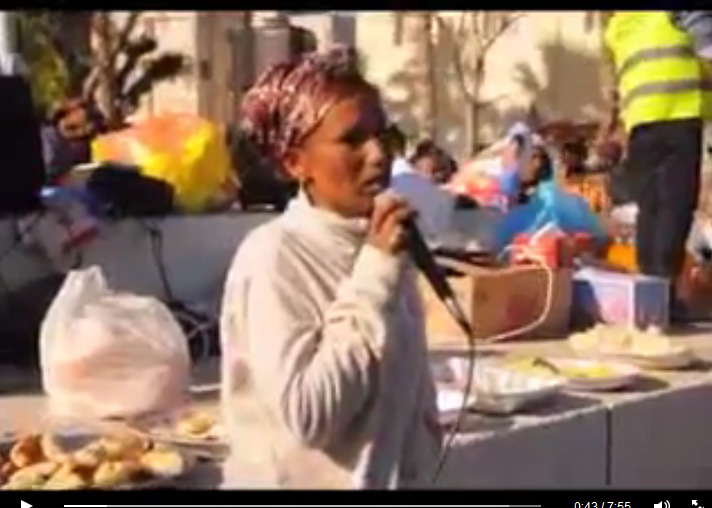
An overview
During Italian colonialism the girls were not only deprived from gaining an education but also became victims of sexual exploitation, in the cities they faced sexual violence and sexual exploitation. Hiwet Ogba Georgis who started working for an Italian family in 1950 states that all domestic workers were afraid of being sexually attacked. Italian men would rape domestic workers and if they got pregnant they would kick them out and deny any connection with them (Wilson 17) The attitude of Italian soldiers toward black women can be seen from the pictures below.
Attitute of Italian Soldiers toward black women during the Italian colonialism in Eritrea.! |
||
Igiaba Scego wrote in her comment " This is one of the most heinous colonial photo I have ever seen. 5 Italians (one is the one that takes the photo) is two eritreans. All are smiling. The girl instead no. Looks like Jesus Crucifix. The photo is taken from the volume (that laterza sent me and I would like to thank Nicola Nicola Attadio for this) margins of Italy, social exclusion of unity to today to David Forgacs Originally was written .in Italian as follow "Questa è una delle foto coloniali più atroci che abbia mai visto. 5 italiani (uno è quello che scatta la foto) è due eritrei. Tutti sorridono. La ragazza invece no. Sembra Gesù Crocefisso. La foto è tratta dal volume (che Laterza mi ha spedito e ringrazio Nicola Nicola Attadio Per questo) Margini d'Italia, l'esclusione sociale dell'Unità ad oggi di David Forgacs." Fonte: |
||
Mebrat remembers one occasion when an Italian man in a car had run over an Eritrean woman and killed her. “He just smashed her body. I don’t know if it was deliberate. Then the Italians beat a drum, they did this whenever they wanted to call us. We went there and found the women lying dead. They asked us to identify her. Then I saw that they had put a 30 franc coin on her mouth. I called a man who I knew was an Eritrean spy working for the Italians. I asked him the meaning of this. He said: “that is her worth” I said. Are we worth only 30 francs? Is that what our life is worth? The man said “Shut up, you are too young to understand”( Wilson 17)
It is written " madamato ", but it reads " legalized rape ". a term used in the former Italian colonies, first in eritrea and later also in the other colonies, Libya and Somalia Mussolini with "Madamato" allowed all fascists their child (7-8-9-10-11 years) inside the bed. Not only to the military, but also to civilians. I think it's obvious that only a pedophile pervert can allow such havoc, a normal person wouldn't even think such rubbish. By the way there are many testimonies of rapes to the damage of little girls who had the misfortune to meet mussolini.
This is what the fascist propaganda in his magazines and newspapers wrote in Italy: " he will never be rulers, if we do not have the exact conscience of our fatal superiority. With Niggas don't fraternizing, you can't and you don't have to ".
The Madamato, in addition to sexual slavery produced another atrocity, not secondary, children born from these abuse. The phenomenon led to the birth of thousands of "Biracial" children not recognized by the father whose only fate was to be abandoned. In addition to Mussolini, a famous Italian character, indro montanelli, "confessed" in an interview of 1982 (you can find it on Youtube) to have had, thanks to the madamato, a 11-Year-old girl in her Called Fatima and called it "a docile animalino". the madamato marked the authoritarian and absolute domain of the colonizer on the indigenous, of the man on the woman, the adult on the child, the free on the prisoner, the rich on the poor The Madamato was abolished by the same, years later, for the scandal that was seen, beyond the dead of the girls due to sexual violence, even those for complications during and after pregnancies.
People on fascism still know very little and, fascists do not read, they will not read the whole article, those have no culture or conscience and will begin to insult Many still believe "to trains arrived on time" and other nonsense spread by this rabble. On the madamato you can documentation as much as you want, if you want to find information on blog and fascist pages, but it will be easy to find the interview
You can understand who you will face when they try to cover this sad and bitter
If you read everything, congratulations to continue to be people who try to go beyond the simple slogan.
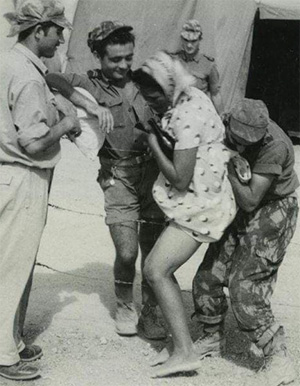
(Source: Antonella ripani - first humans) orginal text in
[ Si scrive "madamato", ma si legge "stupro legalizzato". Un termine usato nelle ex-colonie italiane, prima in Eritrea e successivamente anche nelle altre colonie, Libia e Somalia. Mussolini col "madamato" permetteva a tutti i fascisti la propria bambina (7-8-9-10-11 anni) dentro il letto. Non solo ai militari, ma anche ai civili. Credo sia ovvio che solo un pervertito pedofilo può permettere tale scempio, una persona normale non la penserebbe nemmeno una schifezza del genere. Tra l’altro sono tante le testimonianze di stupri ai danni di ragazzine che hanno avuto la sfortuna di incontrare Mussolini.
Ecco ciò che scriveva in Italia la propaganda fascista nelle sue riviste e nei suoi quotidiani: "Non si sarà mai dominatori, se non avremo la coscienza esatta di una nostra fatale superiorità. Con i negri non si fraternizza, non si può e non si deve".
Il madamato, oltre alla schiavitù sessuale produsse un'altra atrocità, non secondaria, i bambini nati da questi abusi. Il fenomeno portò alla nascita e al lor contestuale abbandono di migliaia di figli "meticci" non riconosciuti dal padre la cui unica sorte era quella di essere abbandonati. Oltre a Mussolini, un personaggio italiano famoso, Indro Montanelli, "confessò" in un'intervista del 1982 (la trovate su youtube) di aver avuto, grazie al madamato, una bambina di 11 anni e mezzo nel proprio letto, si chiamava Fatima e la definiva "un animalino docile". Il madamato segnava il dominio autoritario e assoluto del colonizzatore sull'indigeno, dell'uomo sulla donna, dell'adulto sul bambino, del libero sul prigioniero, del ricco sul povero, del forte sul debole. Il madamato fu abolito dagli stessi, anni dopo, per lo scandalo che si innalzava viste, oltre le morti delle bambine a causa delle violenze sessuali, anche quelle per complicazioni durante e dopo le gravidanze.
La gente sul fascismo sa ancora ben poco e, i fascisti non leggono, non leggeranno tutto l'articolo, quelli non hanno cultura nè coscienza ed inizieranno ad insultare. Molti credono ancora "ai treni arrivati in orario" e altre idiozie diffuse da questa gentaglia. Sul madamato potete documentarvi quanto volete, sbaglierete se cercherete informazioni su blog e pagine fasciste, ma sarà facile trovare l'intervista di Montanelli e documenti a riguardo in rete.
Potrete capire chi avrete difronte quando cercheranno di insabbiare questa triste e amara storia.
Se avete letto tutto, complimenti per continuare ad essere persone che cercano di andare oltre il semplice slogan.
(Fonte: Antonella Ripani - Prima gli esseri umani)]
Another facet of Italian racism against Eritrean women was to perform hysterectomy . According to Mebrat, drawing on her personal experience, “Dr Vero was a gynaecologist but when women went to see him for whatever gynecological problem he would perform a hysterectomy. He would do it under anaesthetic without telling them in advance. Women go mad after that, I had that experience. It has happened to a lot of women. After the operation we have no menstruation, nothing. It was deliberately done to decrease the population of Eritrea. Soon after this her marriage broke up.” Wilson t pp.22
Mebrat also told to Wilson: “I hate Italian men for the way they behaved. There were many instances of rape of Eritrean women by Italian men. It was Italians who introduced prostitution.” Mebrat adds that there was a separate area for prostitution. Italians would come and pick women out like a commodity. There was a place called Casino, the owner of this place was an Italian woman and she would go from place to place looking for beautiful women and sometimes forcing them to go with her. Asmara's Casino was also recalled by other women. (Wilson, 1991:13)
Giulia Barrera (1996) states that generally speaking, Italian men categorized their Eritrean sexual partners as either“sciarmutte” or “madam.” Sciarmutta was an Italianization of the Arabic term “sharmãta”and stood for prostitute; the term madam applied to concubines who associated with Italian men, although Italian men and their madam did not always cohabit. In a broader sense, the term seems to have referred to an African woman in an exclusive relationship with an Italian man. By Italian standards the madam (i.e., the relationship with a madam) had no legal sanction; Italians considered it something different from marriage, questioning whether or not an African woman could ever become a “real wife.” Italians debated the issue throughout the colonial period, but for most the answer was a definite “No”.
Additionally Array(1992) cited in Md Arshad (2012) notes that the establishment of Italian colonialism in Eritrea and the coming of large number of soldiers, officials and colonists, in most cases without their wives, led to a considerable growth and commercialization of sex which soon reached present proportions. In addition to colonialism, urbanization also contributed to the spread of prostitution in Eritrea. Cities were the centers of development, attracting rural migrants especially young girls (mostly widowed because of war who were left without support). In the countryside the occupational avenues were very limited. Hence, in order to escape exploitation as housemaids and because of poverty many young women became madams or prostitutes. In the successive eras of colonization, the immediate followers of the Italians were the British. What the Italians did, the British followed. Eritrean women remained fulltime servants as they had been with the Italians. At the time Europeans having sexual relations with Eritrean women was very common. Elderly people, belonging to that era, report that venereal diseases were found to be widespread in the country.
Generally speaking the practice of prostitution in Eritrea was introduced by Italian colonialism and rapidly expanded during the Ethiopian occupation and was further expanded by the PFDJ as result of an increase in poverty following the border conflict. This will be discussed at the end of this section.
Prostitution continued under the Haile Selassie regime. According Md Arshad (2012) the regime aimed at the political integration and promotion of prostitution (in order for Ethiopian soldiers to have free access to sexual relations with Eritrean women). Prostitution became a common activity especially in cities where military bases were located. War widowed women remained without any option but to open houses for prostitution
Furthermore in 1953, a U.S telecommunications centre was set up in south-west Asmars and by 1960s this had expanded to a military base, the Kagnew station during this period bars and discos were springing up in large numbers, and as one upper middle -class women, then in her teens, described
There were all kinds of special shops and duty-frees and certainly in the early sixties it was fashionable to have an American boyfriend.Just think of it , 3,000 US soldiers and many of them single men-more than anything it encouraged prostitution. Quite a few American took Eritrean women back as wives-many of them had been prpsitutes [Wilson p 27]
Throughout the liberation struggle prostitution was a growth industry where the Ethiopian forces occupied territories in Eritrea. The Ethiopian army also used women who work for them in some capacity, such as cooks and cleaners, as prostitutes. (Dines, 1989:147). Green in her report to Danida states that Eritrean girls within the occupied zones were also abused by Ethiopian soldiers. Eritrean girls required to register for army service at 16. Girls were seldom used in combat by the Ethiopians, but were often utilized as cooks and cleaners for the army (Dines, 1989:153). Furthermore, there is evidence to suggest that many of them were used as prostitutes by the soldiers (Green 1990 :23).
The Derg regime was worse than all the previous colonial regimes. It is believed that prostitution grew at a faster rate during that time. A UNICEF report by acknowledging NUEW stated “since colonization, prostitution developed at a slow rate but it reached at its peak during the Derg regime, when a large number of soldiers overwhelmed the country. According to this report, Ethiopian women who came with the soldiers and natives practiced prostitution. At that time commercial sex was common in most of the towns despite the fact that that the Ethiopian soldiers were aimed militarily. They did not come with their wives or families and hence, they had no permanent contact with any women. The Derg therefore promoted prostitution in order to satisfy the immediate sexual needs of its soldiers. Md Arshad (2012. As a result until mid-2000, a large percentage of commercial sex workers in Eritrea were Ethiopian. This was confirmed by asurvey which was conducted on Sex Work in Eritrea in 2002. According to this research 74% of the 4570 sex workers were Ethiopian, many of whom are likely to have returned to Ethiopia.
.Green,(1994) also states fear of harassment and rape by Ethiopian soldiers was a major issue in the occupied zone. A study which conducted by Lionel Cliffe (1989) showed that almost 200 rapes were reported by villages located in the contested zones (1989:377). Since the contested zones were not comprehensively covered by this study, the incidence of rape for these areas as a whole was probably much higher. This finding is supported by Dines who, writing in 1989, argued that harassment and even multiple rape of both girls and women is an everyday event in the occupied zones (1989:147)
The rape of both girls and women by the Ethiopan soldiers in the 1960s, 1970s and 1980 was repeated by the Ethiopian armed forces during the 1998-2000 border conflict. Regarding this there was a report on Eritrean women who were sexually abuse by the Ethiopian military. Sapa-AFP reported that (2000): “Life was terrifying," said a tearful Tsadkan, 50. "I could never live there again." She arrived on Monday from Senafe - some 70km south-east of the Eritrean capital Asmara -- which has been occupied since May. "Every night, the soldiers came to my house, trying to grope me, harassing me," she added. She said she knew of the case of an 80-year-old woman who was raped by Ethiopian soldiers. Tsadkan wears no jewellery, except for a
Janet Grube (2005) states that thousands of women and girls experienced sexual violence perpetrated by the Ethiopian military. Janet adds that in late August 2000 people were able to escape to internally displaced persons (IDP) camps such as Zula, and female Saho survivors of sexual violence had either been silenced or had silenced themselves , reasons include their households and community being identified as shamed and un-Islamic for ‘allowing’ women to be raped. There are similar stories from Somali women in war zones who were raped. In a book, Rape in Wartime (2012) Somali women survivors of rape in refugee camps did not speak of the ordeals they had undergone for fear of suffering victimisation within their own groups read more
The EPLF strongly believed that "women must be treated as human beings, not commodities, and promised to ban prostitution but this became lip service after the liberation. The abusing of young Eritrean women continued after the liberation, in fact has got much worse because of the prolongation of National Service, mentioned earlier. Regarding this Fetsum Abraham provides an overall picture of how young girls are sexually abused by Eritrean men! According Festum the Commanders rape them at SAWA and sex-starved Eritreans travel to the country to sexually abuse them for small payments.
After the 2000 border conflict and with the departure of the Ethiopians, the topography of commercial sex work changed in Eritrea due to the exacerbation of poverty. Increased poverty has forced still more Eritreans women into prostitution. A 19 year old prostitute said:
“I am doing it to raise my child".
Hunger and war form the backdrop to this, for deepening poverty is driving many Eritrean women to sell their bodies just to feed their families. Another woman also said she began selling sex when her 22-year-old boyfriend went into the military two years ago, during the 1998-2000 border conflict with Ethiopia. Their child was born soon after he left, she says. Her story is echoed by a colleague, a 30-year-old woman dressed in white robes who has two children. She says: "We were doing fine when we were living with my boyfriend, but when he went to the front we had nothing."Taro Matsuoka (2012)
More evidence of this could also be seen from case studies conducted by by Md Arshad (2012 Aster is 19 years old CSW [Child Sex Worker], she lives with her mother in Gheza Berhanu. The only reason for her to work as a CSW is to supports her family which formerly was her mother's responsibility. Her mother was working as a CSW but because of her age she no longer does it. As a result Aster had to support her family and the only means through which she can do was by continuing her mother’s legacy. She is now supporting her 3 younger brothers and her mother. Her mother admits that her daughter's reason to join CSW was mainly due to the economic problems of the family
The Eritrean government not only appears to use young females in sex tourism inside country but also exports them to Juba. Of the top ‘exporters’ of prostitutes to Juba, Ugandans lead the way with 45%, Kenyan prostitutes constitute 27% and Eritrean prostitutes 10% of the market share .[source].
As a consequence of human rights violations and indefinite military service since 2001 more than 300 000 citizens have fled Eritrea, many of them are young conscripts. According to various reports Eritrea has become the largest refugee producing country. All these refugees have fled the country to seek protection and a better life but unfortunately after arriving in Ethiopia, Sudan, and North Africa etc. they still face dangers, and many of them have not only lost their life in Mediterranean Sea, Sahara desert and Sinai deserts, but fell victims of the Rashaida tribe traffickers in Sina.
Over the past two decades many young people have become the victims of executions or perishing in the Mediterranean Sea and Sahara desert. During this time, opposition leaders have spent in internal disputes and narrow power struggles instead of focusing on bringing an end to the PFDJ fascistic regime. The opposition leaders have also contributed to some extent in prolonging the suffering of the Eritrean people and particularly of young Eritrean men and women.
This compilation has covered briefly
Looking back on the history of education in Eritrea, there was good progress in the 1940s and 1950s and reached at peak in the early 1970s. Unfortunately education started declining from the mid-1970s during the armed struggle when both students and professional educators not only became victims of the Dengue but also of the Jebha (ELF) and Shabia (EPLF) leadership...
After the liberation of Eritrea there was hope for a renaissance of education similarly to what happened after the defeat of the Italian fascist rule in 1941. Instead, it got worse than ever. To avoid the national service many young girls decided to leave school before completing their high school to be married and have babies which became one of the main contributing factors to the widening gender gap in education post-liberation.
The content of this compilation should be useful to readers particularly of the younger generation by giving a critical overview of the role of the Eritrea revolution leaders during the armed struggle as well as of the PFDJ and of the opposition leaders who participated in the liberation struggle. In fact these leaders of the PFDJ and the opposition leaders have also considerably contributed to the decline in the socio-economic development of the Eritrean society as well as in prolonging the suffering of the people.
The opposition group leaders and members of opposition groups and civil society have failed to learn lessons from the 1960s. When the Eritrean liberation army divided into 5 zones it gave more opportunity for the Ethiopian army to burn to the ground over 120 villages, causing more than 250, 000 to flee to Sudan. They have also failed to learn that the ELF and EPLF split in the 1970s became one of the main factors for prolong the Eritrea revolution from 1977 to 1991 which cost more than 100, 000 lives, including the civilians.
It is very sad to see that again opposition leaders and their supporters as well as member of civil society and youth associations repeat the mistakes of the ELF and EPLF leaders , Member of Youth Associations, Women Association and Mass Organisations affiliated with the ELF and EPLF. All of them contributed to dividing the Eritrean people in pursuit of their own interests and narrow power struggles.
Therefore the youth, particularly the young women, are not merely the victims of the PFDJ but also of the leaders of the opposition groups and their elitist supporters who contributed to prolonging the life of this autocratic regime which is responsible for the deaths and disappearance of thousands of Eritrean youths.
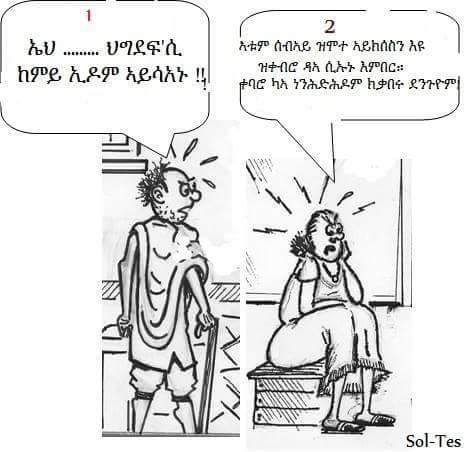
Reference
Bernal, Victoria(1996) From Warriors to Wives: Contradictions of Liberation andDevelopment in Eritrea
EPLF documentation about Women Rights and Emancipation in Eritrea [youtube]Eritrea's STRONG WOMEN Fighters (Part 1)
Eritrea's War Tested Women Soldiers Documentary By Yonatan[VIDEO]
Gebremedhin, Tesfa G (2002) Women, tradition and development : a case study of Eritrea
Gross, Michael L (2015)The Ethics of Insurgency: A Critical Guide to Just Guerrilla Warfare
HRW (2014) Trafficking and Torture of Eritreans in Sudan and Egypt
Krosch, Sara L.(2005) “A New Race of Women”: TheChallenges of Reintegrating Eritrea’s Demobilized Female Combatant
Kutschera, Chris(1997)What happened to the Eritrean female freedom-fighters?
Mekonnen, Daniel Rezene (2011) From Sawa to the Sinai Desert: The Eritrean Tragedy of Human Trafficking
Miran Jonathan (2002) "Missionaries, education, and the state in the Italian colony of Eritrea"
Muller, Tanja R (2005) The Making of Elite Women: Revolution and Nation Building in Eritrea
Rena, Ravinder (2007) Women in Eritrea: reflections from Pre- and Post independence period .The Indian Journal of Labour Economics, Vol. 50, No. 2, 2007
Wilson, Amarit (1991) Women and the Eritrean Revolution: The Challenge Road
A Fight Left Unfinished A Case Study on the Female Fighters of the EPLF and Female Emancipation
ehrea.org © 2004-2017. Contact: rkidane@talk21.com | ||||